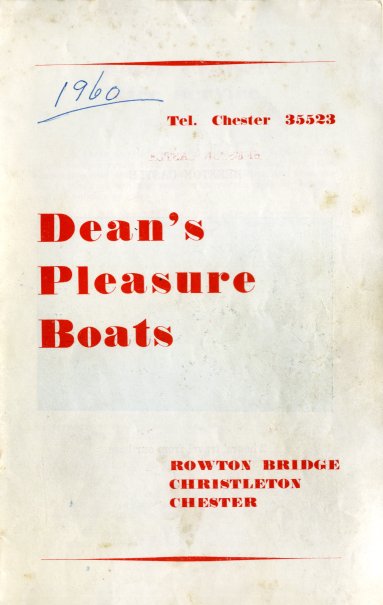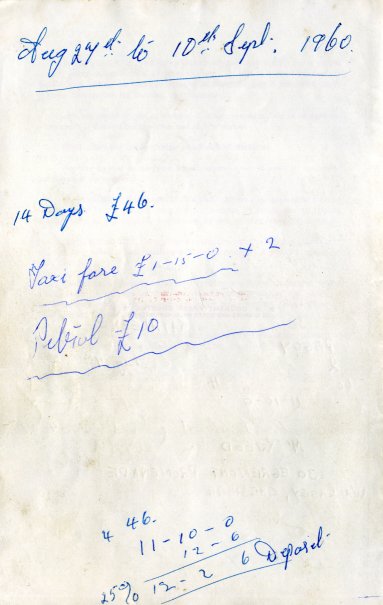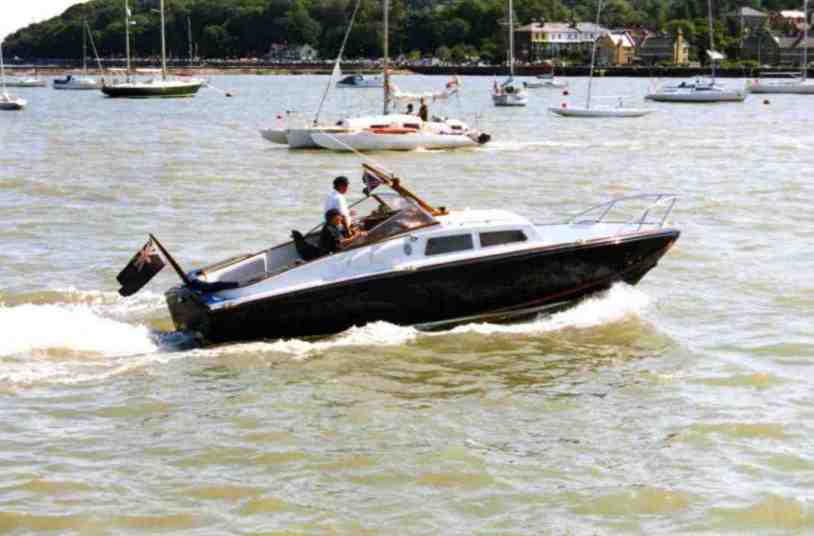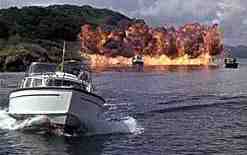
Book 1
Canal Cruising 1959 to 1982
An eBook by Cyril J Wood
|
|
|
|
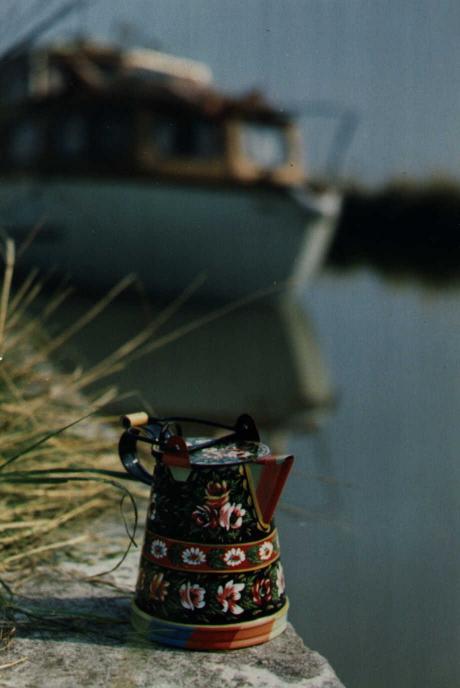
|
The title photograph shows a miniature Buckby can with |
|
an out of focus "Phial" lurking in the background |
(Photograph - James M Wood)
|
|
||
Click on title to follow links
|
|
|
Book 1 |
Canal Cruising 1959 to 1982
Chapter 1 - 1959, First Contact
Even though this volume of Canalscape - is entitled "Canal Cruising 1960 to 1982"; my first conscious encounter with canals occurred in the summer of 1959 when I was eight years old. At that time, my brother, Jim, was still serving his National Service with the British Army at Famagusta in Cyprus where he ran the "Tonanti" Cinema. He was due to be “de-mobbed” the following year and my parents decided upon our first family holiday to celebrate his return home. An advert in the “Liverpool Echo” for pleasure boats on the Shropshire Union Canal near Chester sparked their imagination and it was decided that we would have a day out to inspect them during the summer holidays.
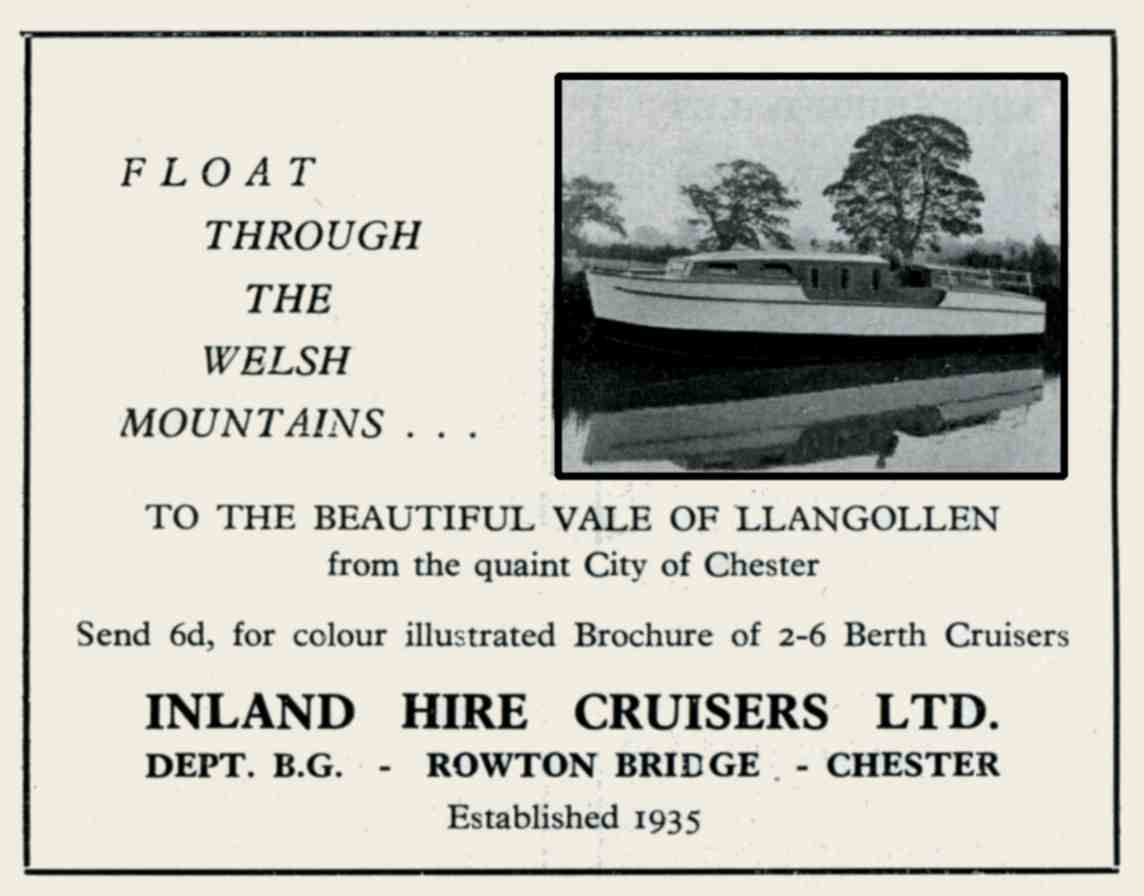
An old advertisement for Inland Hire Cruisers of Christleton with "Enterprise" illustrated
In 1959 few families had a car, so the thirty-odd mile journey was quite a trek from our home in Wallasey which is situated at the north-western tip of the Wirral Peninsula. On the day in question, we caught the train from New Brighton Station (the nearest railway station to our home) to Chester. Our first stop was the famous “Rows” of covered shops (no doubt to placate Mother who was quite fashionable and liked shopping). After this we went for a walk around the walls and I remember Father dangling me by the legs from the City Walls adjacent to the Watergate… one of gates in the ancient Roman wall surrounding the city, directly over the weir on the River Dee. We then caught the bus to the “Old Trooper” Inn at Christleton on the outskirts of the city. From the bus stop, the canal towpath was reached through a hole in the hedge adjacent to Christleton Mill, which is still there to this day. We walked along the towpath to Rowton Bridge where Inland Hire cruisers Ltd. (previously known as the Inland Cruising Association) were located. This company was established in 1935 by David Wain, one of the pioneers of canal hire cruising in this country, and was one of the earliest hire boat companies operating on the canal system.
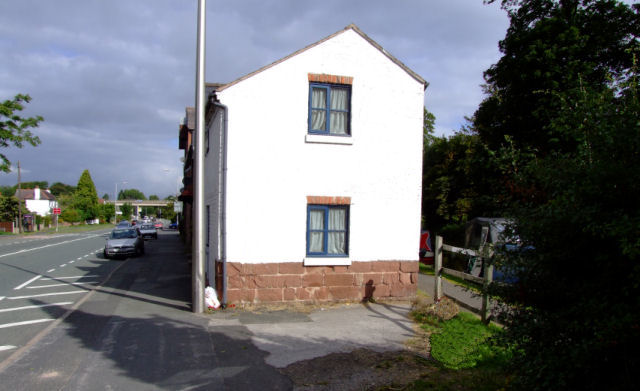
The hole in the hedge adjacent to Christleton Mill in 2011
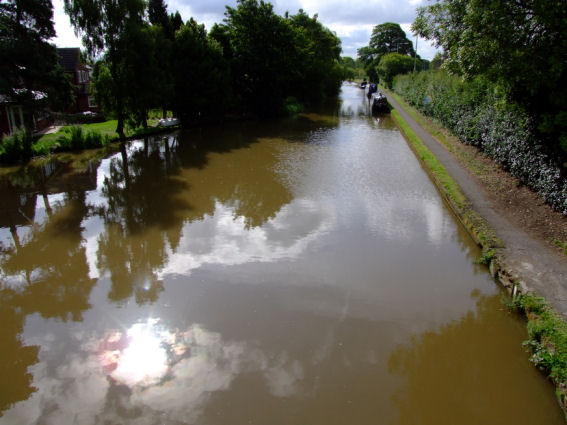
The first length of canal I ever saw or walked along at Christleton
Father was unimpressed by the craft as their dated designs didn't instil confidence plus they all looked old fashioned and dowdy in their dirty white and light blue livery. Whilst walking along the towpath we had previously passed Deans Pleasure Boats who were, in effect “next door” to Inland Hire Cruisers, located on the Chester side of Rowton Bridge. This was to be our next stop. After being shown a few of the boats, most of which featured marine ply carvel hulls, (which Father described as “slab-sided monstrosities”) a trim little craft christened “Kathleen” caught his eye. This was a clinker hulled, centre cockpit cruiser of 23ft. length, built in 1958 by J. H. Taylor of Tower Wharf, Chester (reputedly, the Rolls Royce of wooden canal cruisers). This boat impressed Father and after being shown around it by no less than Sid Dean… one of the company’s owners, she was duly booked for the last week in August and the first week in September the following year (1960). As I look back on this “First Contact” it is as fresh in my memory as if it were yesterday. I remember thinking that Inland Hire Cruisers' base was scruffy and the company's office looked like the front room of the adjacent house (which it was). Deans however were completely different. Their base looked more modern, they had a business-like office and their boats, many of which they built themselves in their own workshops, looked the part as well.
|
|
|
The front and back covers of Dean's 1960 brochure showing the costs in Father's handwriting
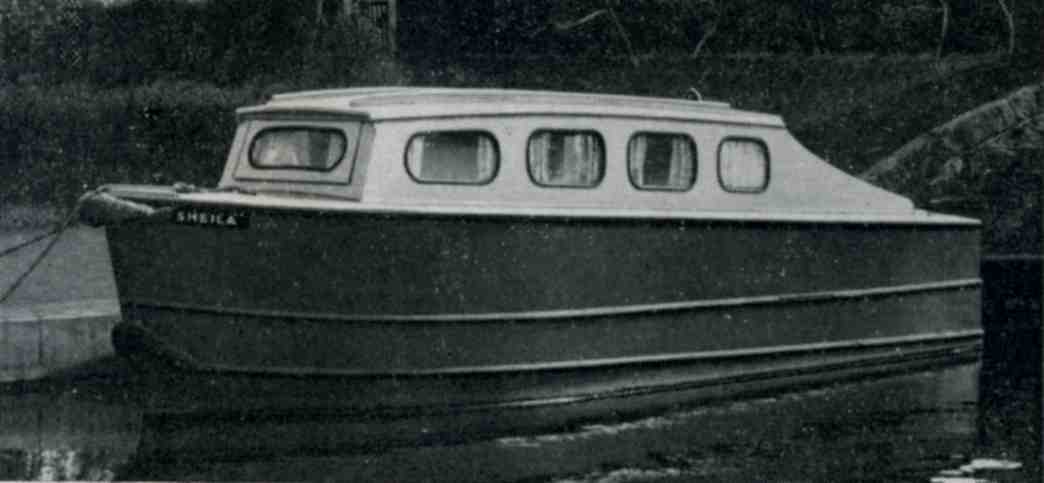
The identical, aft cockpit twins "Shirley" and "Sheila" failed to impress Father...
(Photograph - Dean's Pleasure Boats)
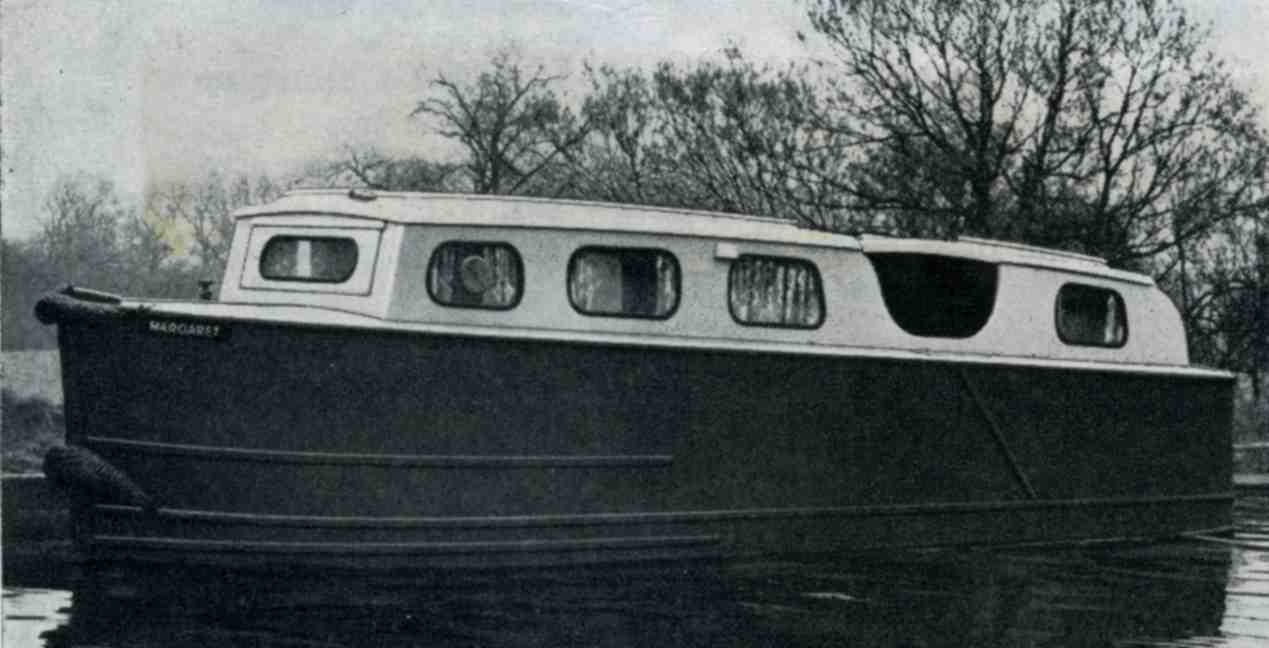
...as did the "slab-sided monstrosities" of "Margaret" and "Peggy" which were also identical
(Photograph - Dean's Pleasure Boats)
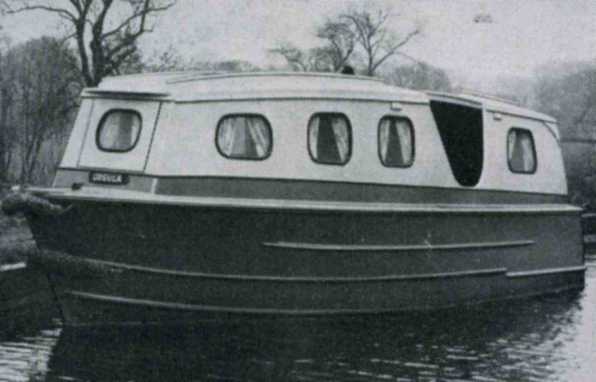
The "Ursula" and the identical "Mabel" possessed more of a "line"...
(Photograph - Dean's Pleasure Boats)
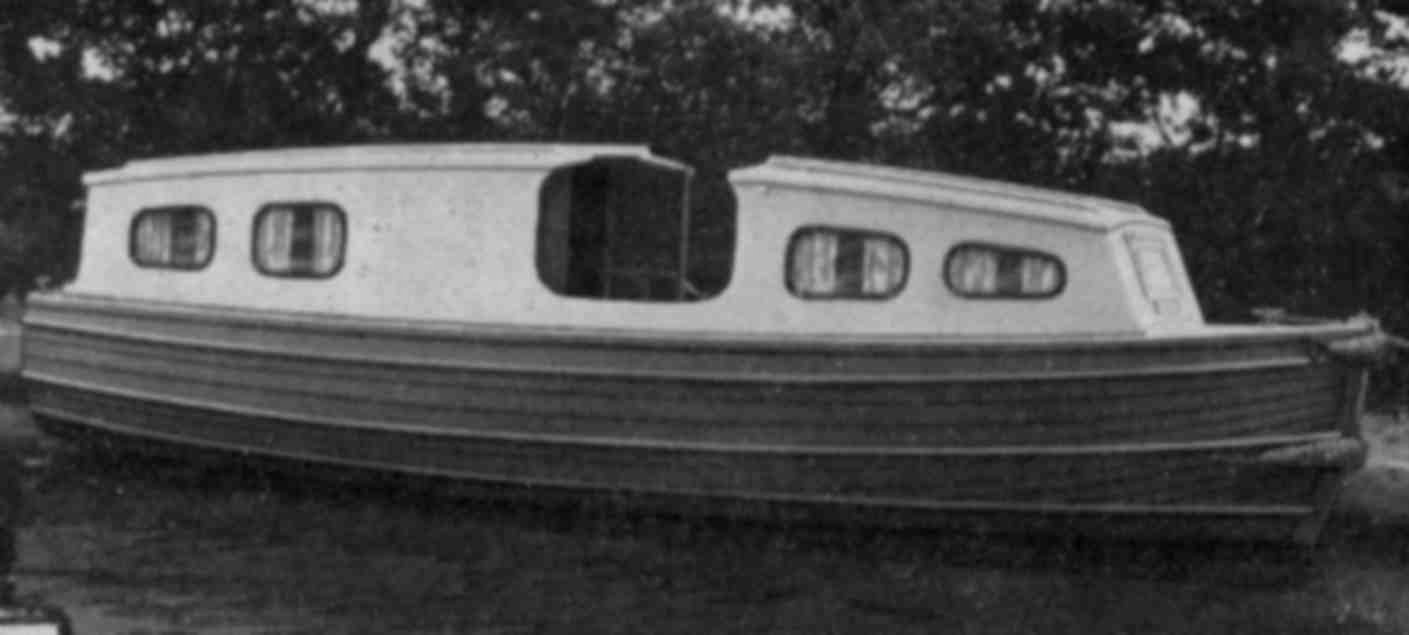
... but it was the Taylor built "Kathleen" that Father decided to hire for our 1960 canal holiday
(Photograph - Dean's Pleasure Boats)
When we returned home, plans were formulated for the holiday and a drawer in a large dresser on the top landing at home was allocated and christened the “Holiday Drawer". Each week articles and clothing were bought especially for the forthcoming canal holiday and placed in the drawer. The drawer soon became two drawers as waterproof clothing (initially plastic "macs" and later anoraks), a small clothes line complete with miniature pegs (an item whose use was to be quite memorable) that was a free gift in one of Mother’s magazines (Woman’s’ Own I think) was also added along with other appropriate articles.
At that time, the British Waterways Board (as the Canal and River Trust was then known) had an office in Liverpool in Pall Mall, not far from where Father worked and he purchased two of their original canal cruising guides (number one for the Llangollen Canal and number five for the Shropshire Union Canal). The canal was represented as a brown line in the early publications which I suppose is reasonably accurate.
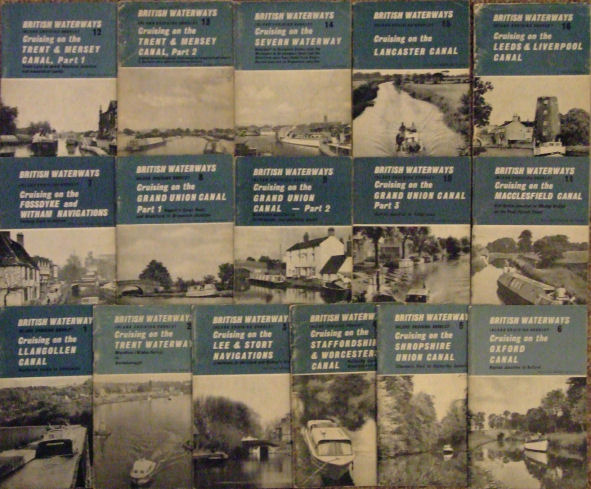
The complete collection of British Waterways Inland Cruising Booklets
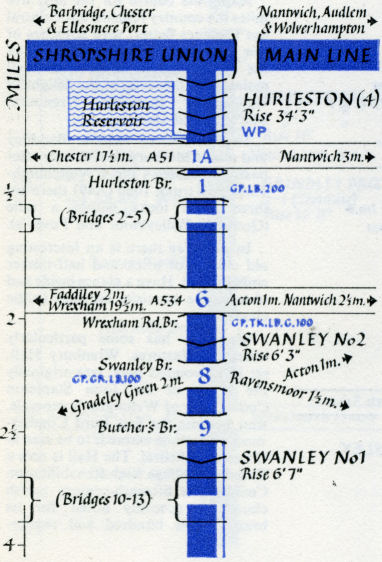
One of the maps reproduced from a second edition British Waterways Board Llangollen Canal Cruising Booklet
(Reproduced courtesy of Canal and River Trust)
We pored over these books and a couple of other publications on canal cruising that we came by (Robert Aickman’s “Know Your Waterways” and L.T.C Rolt’s “The Inland Waterways of England”). There wasn’t much interest in canal cruising in those days and books on the subject were extremely thin on the ground. Accordingly, any books and printed matter relating to the subject were immediately purchased and eagerly read from cover to cover. I still have all of these books in my canal and inland waterways books collection and I often take them off the shelf to reminisce and think about how much has changed since they were published.
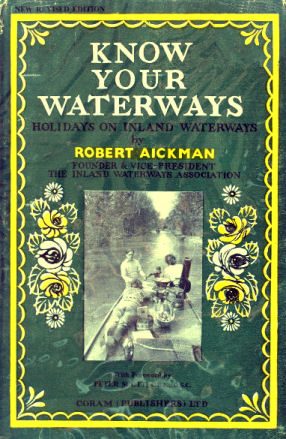
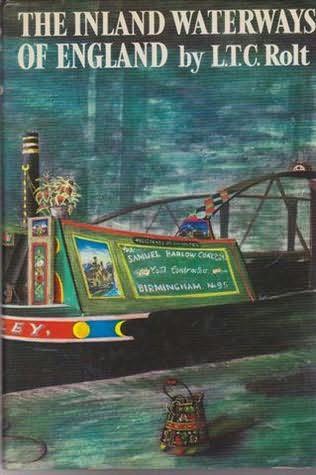
Two of the treasured canal books on my bookshelf
The summer of 1960 soon arrived. Jim, now home from the Army, had a job as a cinema projectionist and could not join us until the Thursday of the first week. It was decided that we would cruise up the “Shroppie” and for Jim to catch the train to Wolverhampton and meet us at a pre-determined location on the first Thursday of the holiday.
A friend of my parents... a Mr. Shaw, who owned a sweet shop on King Street in Wallasey, near to where we lived, operated a taxi service in his spare time. He was approached and then booked to take us and the contents of the holiday drawers to Christleton in his grey Humber Hawk and pick us up again two weeks later, to which he agreed, for a fee of £3.10s (£3.50p) return.
At last, the day of the holidays arrived. On Saturday the 23rd August 1960 at 12.00p.m. Mr Shaw’s Humber Hawk reversed down St Vincent Road, Wallasey (the nearest road access to our house), was duly loaded with our luggage in the shape of four large “holdalls” and off we went. I can still remember the journey, especially Rock Ferry (the by-pass had not been constructed in 1960) which was home to “Palace Motors” (“and they make a lovely cup of tea”) who advertised regularly on television and at Eastham where the the A41 Birkenhead to Chester road had a long stretch of sandstone walling at the side of it. Coincidentally, this wall marks the boundary of Eastham Golf Course which is adjacent to Wirral Metropolitan College’s Carlett Park Campus, where I used to work. Another object that I remember is what looks like a large bird box on top of a pole about thirty feet high just after the “Old Trooper” public house on the right hand side of the A41 at Christleton where the road bends around to the left. It was not until many years later that I discovered that it was actually a breather for the sewer pipe that was buried beneath the ground at this location.
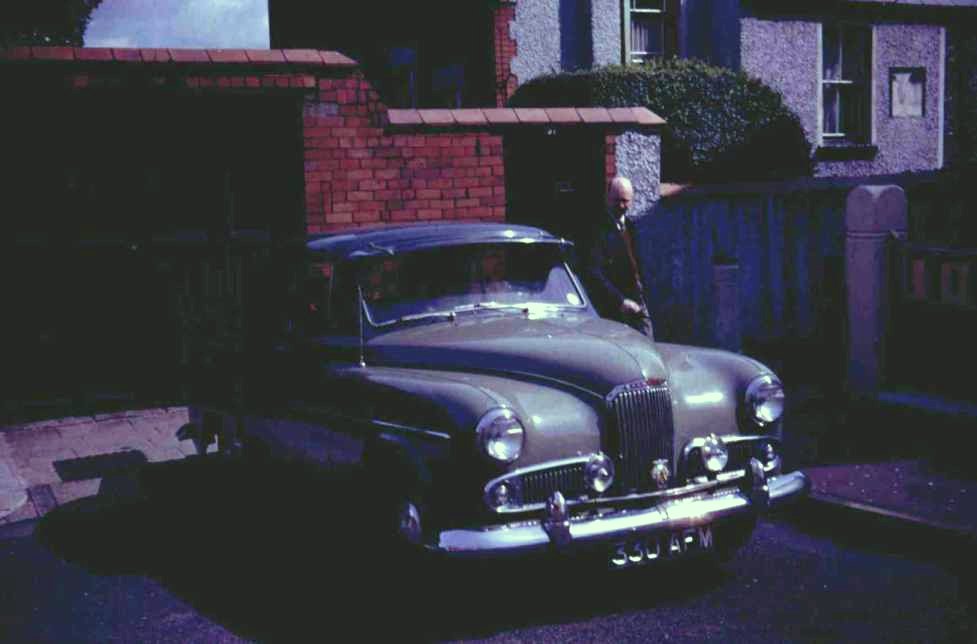
Mr Shaw and his Humber Hawk
(Photograph - James M Wood)
The journey to Christleton seemed to take forever and I amused myself by making shapes out of the clouds (I was convinced that there was one the same shape as the British Isles and that it must be a reflection). When we finally arrived at Dean’s Hire Boats I helped my mother load our holdalls onto the “Kathleen” whilst Mr Dean showed my father how a canal lock operated by using a small cement model with equally small wooden gates and a model boat. The source of water being a watering can. This tutorial was followed by a trip to the nearby Christleton Lock both of which were quite unnecessary as Father was a marine engineer by trade and was familiar with such things. He seemed more interested in the “Stuart Turner” 4HP marine engine, which was to propel the “Kathleen” and ourselves on our holiday along the Shropshire Union and Llangollen Canals.
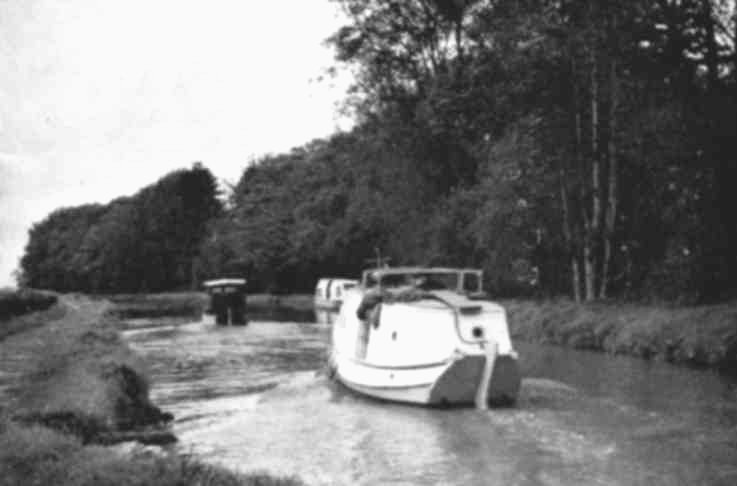
Pleasure cruisers on the Shropshire Union Canal at Christleton Bank in the late 1950s
(Photograph - Canal and River Trust)
When the formalities were over, we cast off, left the base and headed south along the “Shroppie” on the start of our voyage. The weather, which had been sunny up to that point, soon decided to change, or to be more accurate, the rain bucketed down! We tied-up on the off-side of the canal at a location that I now know to be between Waverton Village and Golden Nook Bridge, just before where the moored boats are today. Whilst we waited for the rain to abate, a pot of tea was made and we finished unpacking. The rain eventually stopped and we were under-way again.
A little later on I remember going around a bend and seeing a bridge with what looked like the pointed bow of a boat beneath it and remarked… “That boat will never fit under that bridge!” Oh, the ignorance of youth. What I had actually seen was the bottom gates of Wharton lock and I suppose they might look like the bows of a boat to an eight year old with an active and vivid imagination that had never seen a lock before.
My mother never forgot that lock either. She trapped a finger between the boat’s side and the lock chamber wall whilst trying to fend-off the boat. After negotiating the lock, we tied-up in the wooded cutting above the lock to administer First Aid to mother's finger and decided to spend the night there. The close proximity of the main Chester to Crewe railway line kept us awake at first, but the boat’s rocking and the pitter-patter of yet more rain on the cabin roof eventually lulled us to sleep. Our first night taught us that the bedding supplied with the boat was not as warm as we had been used to at home. Consequently, if we decided to have another holiday with Deans, Mother and Father planned to buy four sleeping bags to take with us.
The next day dawned bright and cheerful, so an early start was made after Mother’s finger had been checked. It was not broken... just badly bruised. There was a shop not far from the next bridge (107) right next to Beeston Castle and Tarporley railway station (now demolished, although the location of the station forecourt can still be seen as can the shop) so we tied up for milk, bacon and eggs and had our breakfast at a place that was, in years to come, to be our second home and very close to our hearts. The place was Beeston (of Iron Lock fame) or to be more precise... Tiverton.
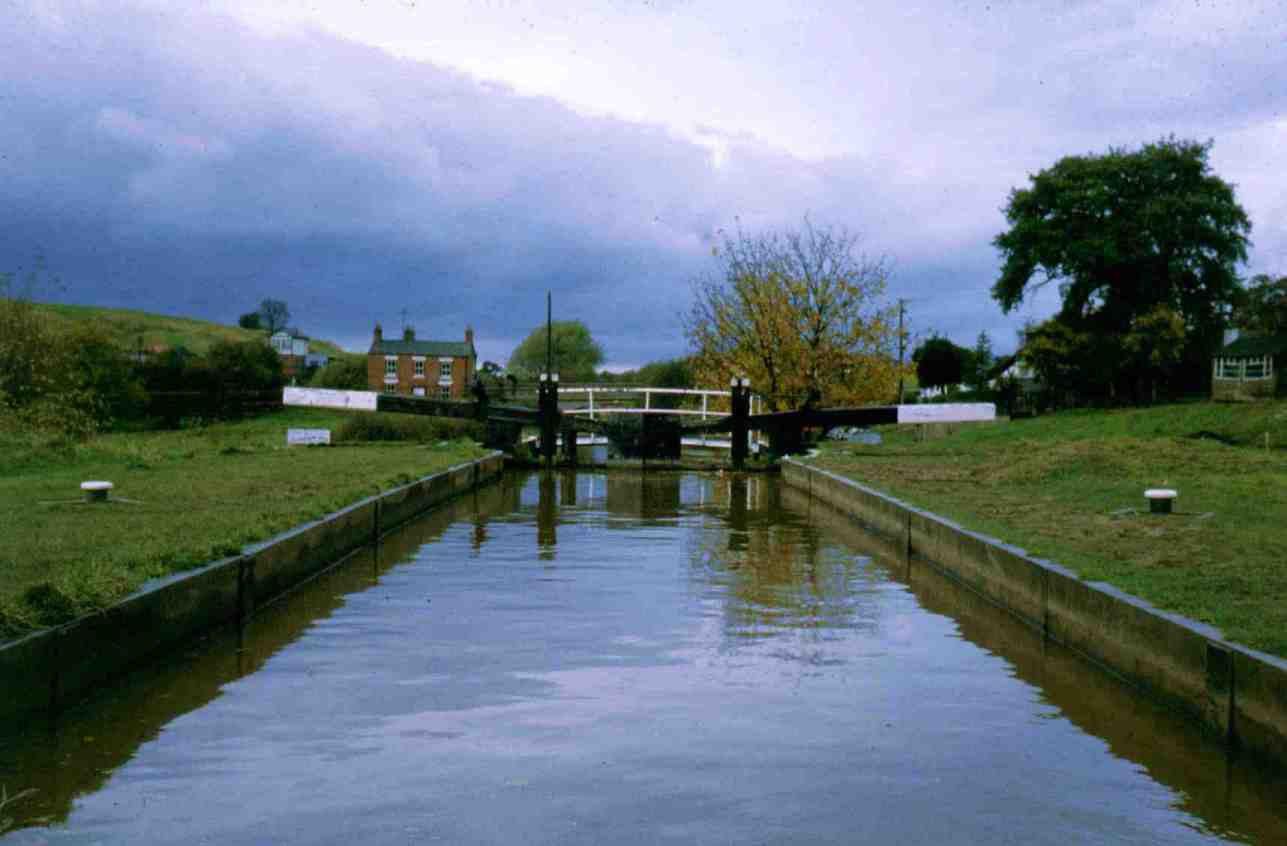
Beeston Iron Lock... a location that was to become close to our hearts
After breakfast, we negotiated the two Beeston locks which were followed shortly after by Tilston Lock. Just before Bunbury staircase locks was the "Golden Line" hire cruiser base (later Dartline, Watertravel and now Anglo Welsh Canal Cruisers). On approaching the lock a piece of discarded rope wrapped itself around the propeller and stalled the engine. As the “Kathleen” did not possess a weed hatch, Father decided to tackle the problem in a very unorthodox manner. We pulled the boat into the bottom chamber of the staircase lock using the ropes and filled the chamber up to the intermediate level. When the intermediate gates were opened Father boarded the boat and we pulled it into the upper chamber. Instead of closing the intermediate gates and filling it, Father instructed us to leave the intermediate gates open and open the bottom paddles, draining the top chamber completely. When the boat was sitting on the floor of the chamber, he told Mother and I to close the paddles, took his shoes and socks off, rolled-up his trouser legs, swung his legs over the side of the boat and dropped down to the lock chamber's floor. He squelched through the mud on the bottom of the lock chamber to the stern of the boat, cleared the propeller with his penknife (which was always kept extremely sharp), climbed back aboard the boat, instructed us to close the intermediate gates and open the top paddles to fill the lock in the normal fashion. When the water level had risen sufficiently he rinsed his feet in the canal water and dried them. I can't remember what the lock keeper said, but I don’t think it would be allowed today... even on a canal like the “Shroppie” that possesses a good water supply. Apparently, this trick was widely used by the boatmen of working narrowboats but we did not know that at the time. Father said that it seemed to be the common sense thing to do under the circumstances.
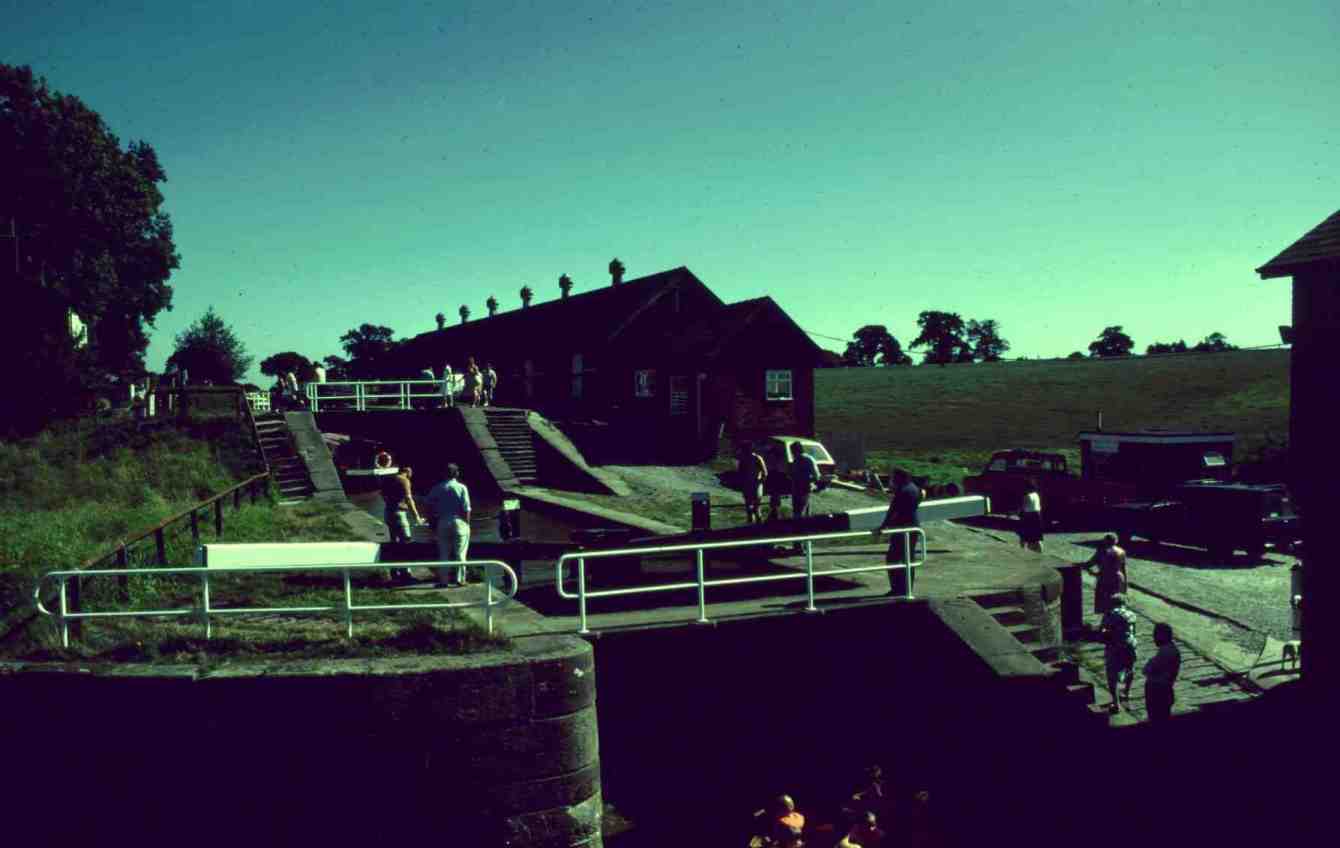
A recent photograph of Bunbury Staircase Locks
We cleared the lock and set off again. After Calveley there is a long straight stretch before the canal negotiates an “S” bend beneath the A51 Chester to Nantwich road. Just before the bridge was a BP Boat Service sign indicating that there was a garage nearby so we moored temporarily (that is to say… Mother and I held the ropes) whilst Father took the two five gallon (25 litre) “Jerry” cans normally secured on the rear deck, off the boat to fill with two stroke mixture (fifty to one petrol/oil ratio). The canal is in a cutting at this point and as Father scaled the grassy sides to reach the road he slipped and let go of the empty cans nearly which ended up in the canal. After a quick look around he found a path worn in the grass which lead up the sides of the cutting to emerge directly opposite the garage. We didn’t laugh... much!
On the approach to Nantwich we admired the boats we passed moored at the Nantwich and Border Counties Yacht Club. As it was Sunday we didn’t stop at Nantwich due to the shops being closed and our second night was spent at another place that was to become close to our hearts… Hack Green. The lock keeper’s cottage was still standing in 1960 and I can remember playing in the disused stables whilst dinner was being prepared. The following morning we set off and passed the revolving "Type Seven" radar antenna which (along with Jodrell Bank) was to become the subject of many of my drawings. Before too long I was introduced to the delights of Audlem. I can remember the general store cum Post Office opposite the butter market that also sold toys and “Matchbox” cars in particular (but no "Lone Star Locos"... a series of small, die-cast model trains approximately "N" Gauge that I collected).
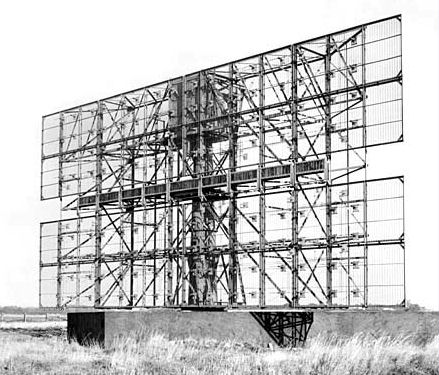
A Type Seven Radar Antenna identical to the one at Hack Green
(Photograph - Subterranea Britannica)
By now I was becoming quite proficient at operating locks and we made good time passing through the Audlem and Adderley flights. As we travelled further along the “Shroppie”, when negotiating the locks we noticed a large amount of foam caused by the opening of the centre gate paddles (most of which are now removed) on the upper lock gates. On some occasions, the whole of the front of the boat was enveloped in foam and we christened the centre gate paddles “soap sudders”. We wondered why the amount of foam increased the nearer we journeyed to Wolverhampton. It was not until many years later I discovered that the cause was the outfall from a sewage treatment plant emptying into the Staffordshire and Worcestershire Canal near Autherley Junction. Fortunately, this phenomenon does not occur today due to an increased awareness of pollution and its impact on the environment.
The rest of the journey to Wolverhampton was without incident except for the Stuart Turner misbehaving at Norbury Junction. Stan Clegg, Dean’s hire fleet manager-cum-engineer had already been called to another breakdown (the ”Peggy” sinking on the Llangollen Canal) and was unable to attend so we were asked if we could have it repaired locally. Father, who was more than capable of making the repairs... being a marine engineer and having recently rebuilt from scratch a classic 1938 Harley Davidson motorcycle (first registered in the U.K. in 1942), diagnosed the problem as the engine needing a decoke. We had no tools with us except for the spark plug spanner that was supplied with the boat and reluctantly entrusted the task of decoking the engine to a local garage mechanic in the village of Norbury a mile up the road from Norbury Junction.
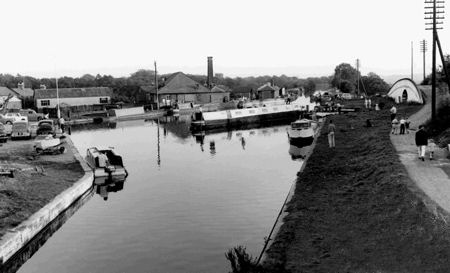
Norbury Junction in the 1960's
Whilst the repairs were in hand, Mother and I explored the village and walked a little way along the abandoned Newport Branch of the Shropshire Union Canal wishing we could cruise along it as it looked most picturesque. On our return the engine repairs were completed and Father paid 19/6 (97.5p) to the garage mechanic, obtaining a receipt so that the money could be claimed back from Dean’s on our return to Christleton. Just try and get a garage to perform a decoke for that price today!
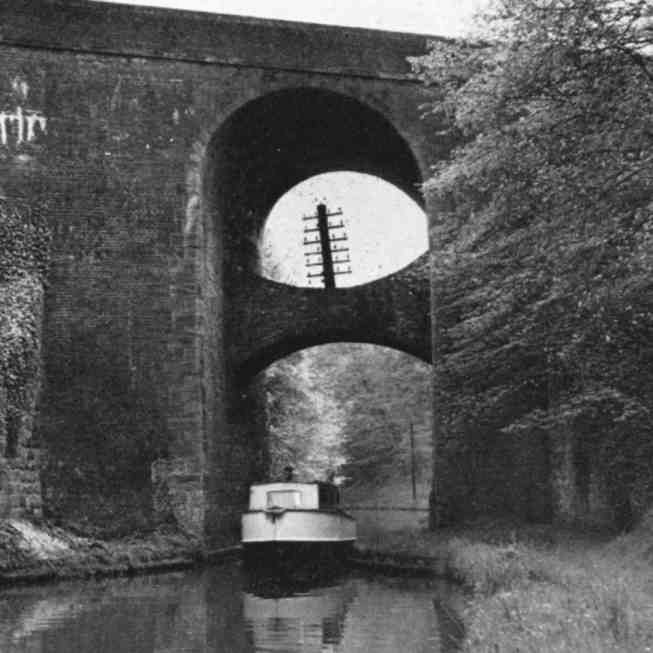
|
A Dobson built hire cruiser (possibly "Bredon Hill" from Stourport) passing |
|
beneath High Bridge (39) which spans Grub Street Cutting on the Shroppie... |
|
(Note the original, crooked, telegraph pole on the buttress) |
(Photograph - Canal and River Trust)
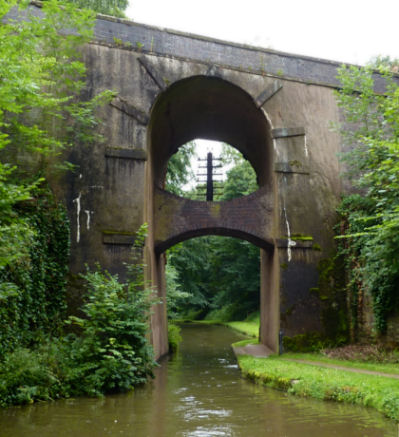
...and the same location in 2013, now rendered, complete with a straightened telegraph pole!
Even though the break down had put us behind schedule, we arrived at Wolverhampton late Thursday morning. The designated meeting point was at Tettenhall Bridge which carries the A41 trunk road over Staffordshire and Worcestershire Canal, not far from Aldersley Junction where the Birmingham Canal Navigation meets the Staffordshire and Worcestershire Canal. Co-incidentally, the A41 was the road that took us from Wallasey to Christleton at the start of the holiday. Jim was catching the train from Birkenhead’s Woodside Station (now sadly a car park after being demolished along with the railway line in a rock cutting that lead to it... although one of the cast iron sided bridges is still visible)). The train was to convey Jim to Wolverhampton where he caught a bus (he thinks that it might even have been a trolley bus) to Tettenhall Bridge. Whilst we waited for him, I looked at more “Matchbox” and “Dinky” model cars on display in the window of a toyshop adjacent to the bridge and watched the trolley buses that ran over the bridge to and from Wolverhampton. The trolley buses were quite a novelty to me as I had travelled on trams in Liverpool and even though I possessed a “Matchbox” model of one, I had not seen this cross between a bus and a tram before in real life. After about an hour I became fed up of waiting and returned to the boat but not long afterwards a waving figure appeared on the bridge. It was Jim. He came down the path to where the boat was moored to join us and climbed aboard. It did not take long to stow away Jim’s luggage, have lunch, turn the boat around and get under way again. The addition of Jim to our crew signalled that the rest of our holiday had begun.
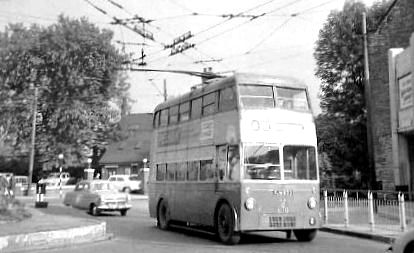
Wolverhampton Corporation trolley bus
Jim’s first experience of a lock was the pitiful excuse for a lock at Autherley Junction where the “Shroppie” starts its journey northwards from the “Staffs and Worcs” Canal. Originally constructed as a stop lock, its six inch drop separated the waters of the two canals to prevent the Staffs and Worcs supplying the Shroppie with any of its valuable water. Even though, it gave him some idea of how a lock worked he would have to wait until Wheaton Aston a few miles further on for a taste of his first “proper” lock. Whilst “Kathleen” was “descending” the Autherley Stop Lock, we filled the green plastic water container from the adjacent tap and chatted to Sam Lomas, the toll clerk, in what was to be the first of many such memorable chats. Sam told us tales from his memories of the canal in its commercial heyday and we discussed how pleasure cruising was becoming more popular and taking over from commercial carrying on the canal.
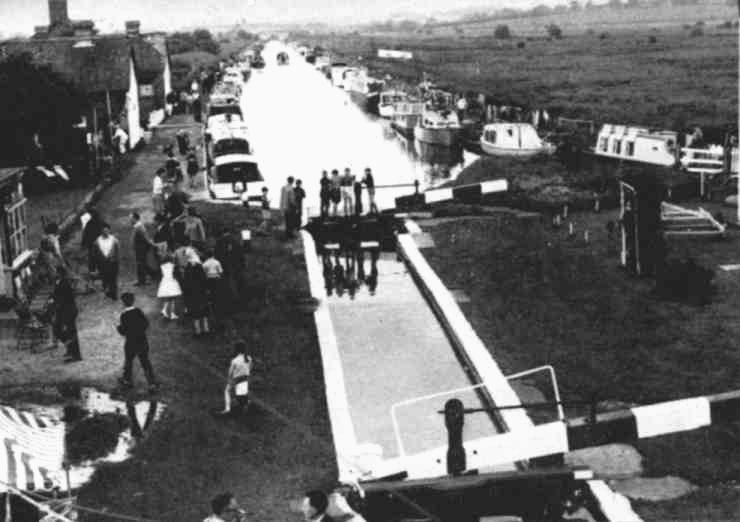
|
A boat rally at Autherley Junction in the late 1950s. |
|
Sam Lomas' office can just be seen on the left adjacent to the lock |
(Photograph - Canal and River Trust)
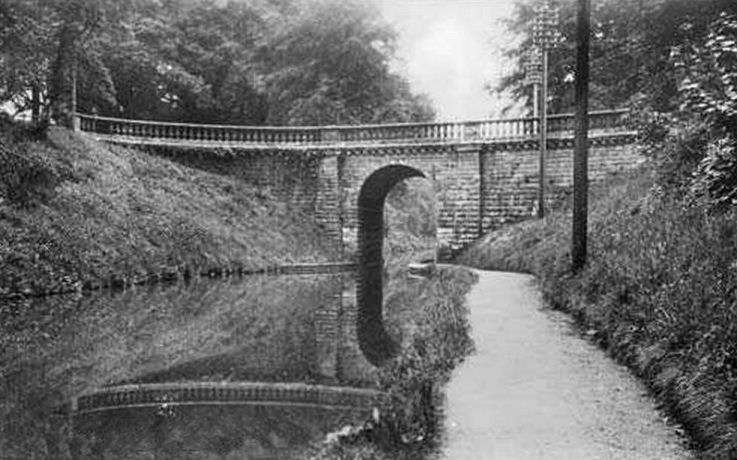
Avenue Bridge - No 10 leading to Chillington Hall near Brewood
(Photograph - Canal and River Trust)
After leaving Sam and Autherley we headed back along the “Shroppie” and passed beneath the beautiful Avenue Bridge (10) which leads to Chillington Hall. We were to admire the beautiful Ashlar masonry that Thomas Telford used for this bridge every time we passed it. We moored for the night at Brewood (pronounced “Brood”) and the following morning we visited the village shops to replenish our larder before setting off. We soon reached Wheaton Aston Lock below which we moored to fill-up the two previously mentioned “Jerry” cans from the nearby garage at 2/- (10p) a gallon. The garage is still there today and reputedly sells the cheapest red diesel fuel on the “Shroppie”.
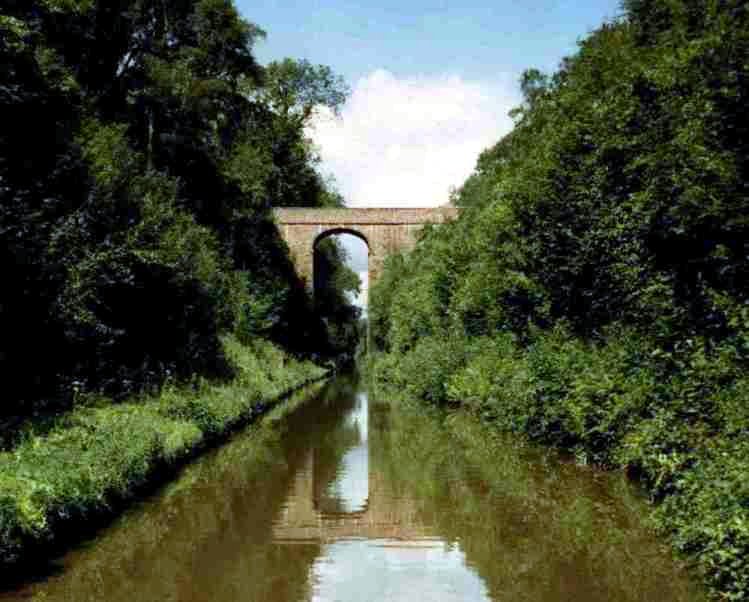
|
Rocket Bridge in Grub Street Cutting... |
|
one of the sultry cuttings on the "Shroppie" |
The next day we cruised across the lofty embankments and through the wonderful, sultry cuttings that typify the southern section of the “Shroppie”, accompanied by herons, which we christened “weirdies” as they looked so strange (almost like a pterodactyl). Jim tried to capture one of them on ciné film with his Bell and Howell “Sundial” standard eight millimetre ciné camera, but every time we came close to the large bird, it took off, landed a hundred metres away and waited for us to catch up before repeating the process. This went on for a good few kilometres before the large bird must have got fed-up and flew away, never to be seen again. In contrast, today, these imposing birds stand their ground when being passed by craft, intent on looking for fish below the surface of the water. In recent years I have captured one of these birds on video actually catching a fish and flying off with it clutched in its talons to an adjacent field where it started to eat its prey.
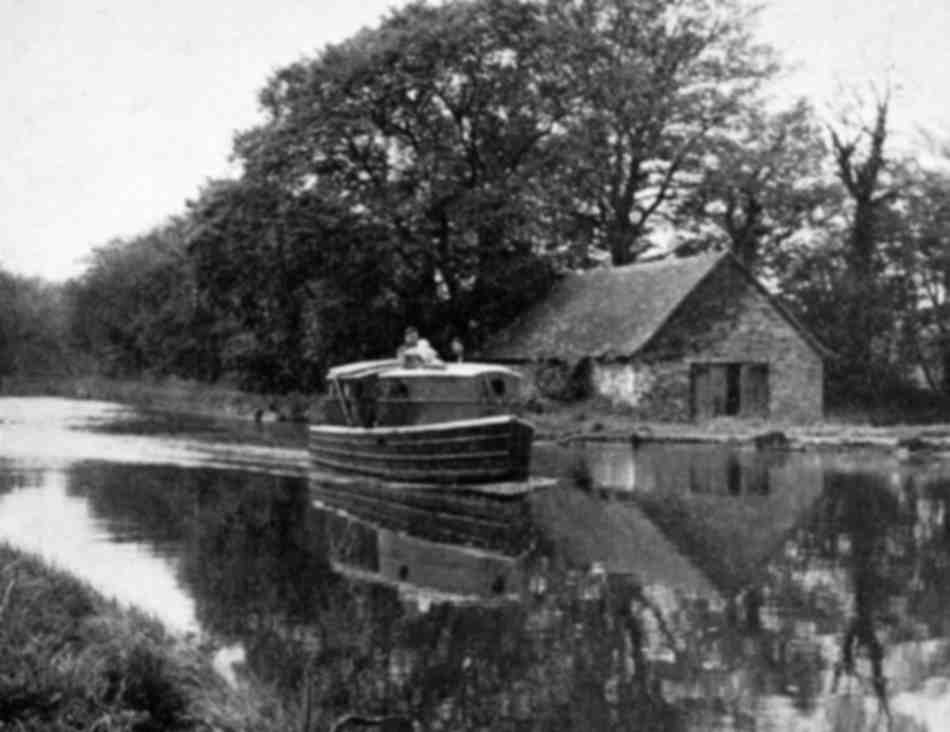
Holidays Afloat's cruiser "Jean" on Shebdon Embankment
(Photograph - Canal and River Trust)
The extra pair of hands on the locks made quite a difference and we made mincemeat of the Tyrley, Adderley and Audlem flights, punctuated by trips into Gnosall (pronounced “Nawzall”), Market Drayton and Nantwich, arriving at Hurleston Junction, the beginning of the Llangollen canal, on the Saturday morning.
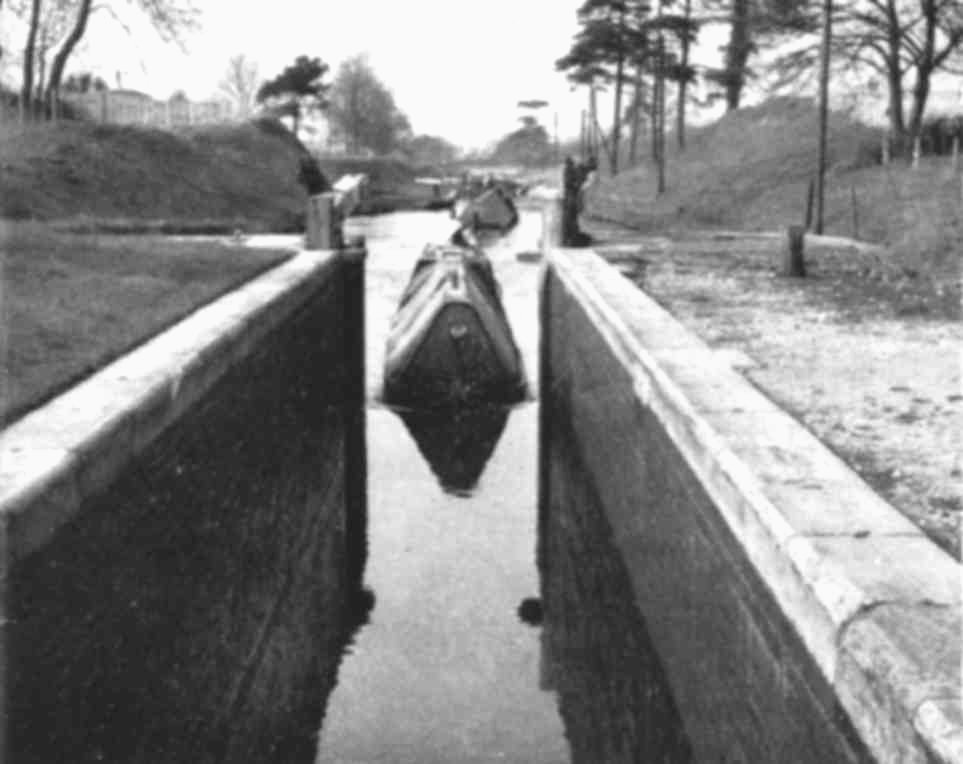
Commercial narrowboats working up Audlem Locks in the late 1950s
(Photograph - Canal and River Trust)
Amongst the craft due to go into the locks ahead of us was a converted wooden narrowboat powered by a marinised Austin A40 Somerset side-valve petrol engine and owned by a large man with a long beard called Chris. On entering the notoriously narrow bottom lock, his boat got stuck at the bow. No amount of revving the engine, pulling on ropes and flushing with paddles would shift it. He stroked his substantial beard whilst summing up the situation and eventually announced to the collection of onlookers that had now gathered… “There’s only one way I’m going to get this bugger free!” So, with that, he jumped down from the lock side onto the roof of his boat, went to his toolbox and quite calmly produced an axe. He then proceeded to chop chunks out of the boat's bow until it floated free. Although it seemed alarming at the time, I now look back at the incident with a smile on my face. Needless to say, Chris didn't cruise up the Llangollen canal that year but we did bump into him on a later voyage when he showed us that he had repaired the damage he inflicted on his boat’s bows. He informed us that now he normally confines himself to his home waters on the Trent and Mersey Canal. “It’s not as traumatic to both myself and the boat” he told us. It is ironic to note that this lock still causes problems today and we regularly hear of craft getting stuck in it (lift the fenders Ange!).
Looking on the whole performance with mild amusement was a man that struck fear into the hearts of the feint-hearted or those who dared to cross him… Mr Walter, the lock keeper at Hurleston. He was a Polish (I think) ex-Prisoner of War that had settled in this country after the end of the Second World War. Father christened him “Happy Harry” for after either he or his multitude of children had helped boats through the locks he held his hand out for a tip. We fed his German Shepherd Dogs with bacon due to be thrown out (no refrigerators on most canal boats in 1960) and he offered us the “loan” of one of his daughters to help with the locks (no doubt for a nominal fee). Needless to say, the offer was declined.
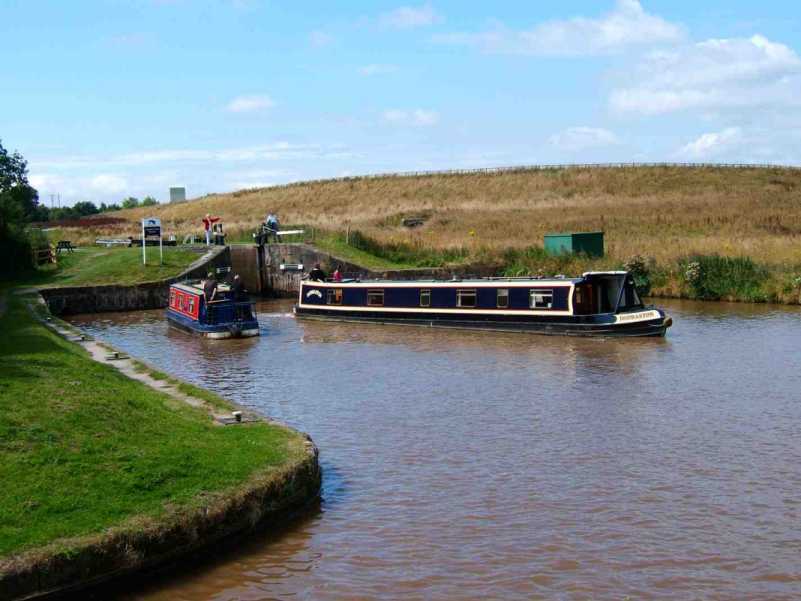
A recent photograph of Hurleston Junction and the notorious bottom lock
Mr Walter had a car that he kept beneath a lean-to in the field adjacent to the locks. It was a French two door Panhard et Levassor and it was the first example of this marque that I had ever seen although Father and Jim seemed to know all about them. On a later occasion we noticed that the single car had grown to three. When we asked him about the additions to his fleet he informed us that a grateful passing boater had given him the other two vehicles for spares after helping them through the locks.
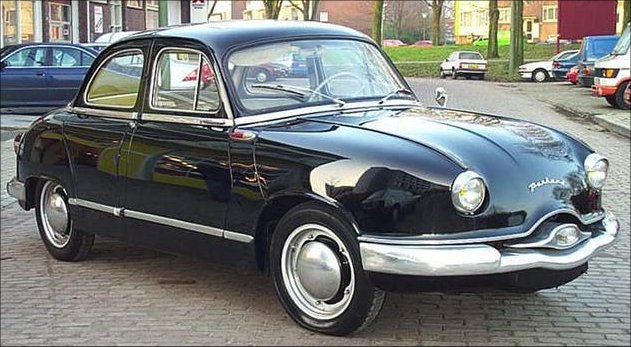
A rare photograph of a Panhard Dyna Z12 which is reminiscent of a Renault Dauphine
(Photograph - www.forum-auto.com)
Some of the locks on the Llangollen Canal possess quite unusual “swan-necked” ground paddles by the upper gates. Whilst winding them up, the unwary operator is standing directly over a breather pipe for the water culvert beneath the ground. When the paddle is first raised there is a whistling noise and water shoots through the breather hole, drenching the legs and lower body of the unfortunate person standing over it. This is one of those happenings that when first experienced (much to the delight of enlightened onlookers) is not usually repeated.
Another design anomaly concerning the locks on the Llangollen Canal is the by-washes. With the canal being, basically an open pipeline for the passage of water from the River Dee at Llantisilio to the reservoir at Hurleston, there is a considerable current of water passing down the canal. I remember reading that over eight and a half million gallons a day passes down the canal and that the reservoir holds ninety eight million gallons of water. This water comes down the by-washes with sufficient force that when going up-hill, boats approaching the locks are pushed to the opposite side of the canal.
That night we moored below Quoisley lock, another place destined to become one of our favourite mooring places. I remember leaning on the bridge parapet with Father and Jim the following morning, watching the mist on the canal dissipate, accompanied by the “caw” from the odd crow and the occasional car passing along the A49, as the smell of our breakfast… bacon and eggs cooking, wafted up towards us. It didn't get much better than this!
We were soon on our way and made mincemeat of Willeymoor, Povey’s and the three conventional locks at Grindley Brook, but we were held-up at the triple staircase lock as a “Simolda” hire boat from Nantwich (the “Queen Elizabeth” I think) was stuck in the bottom chamber of the lock. This lock suffered the same fate as Hurleston Bottom Lock in having bulging brickwork. A few years later the lock was rebuilt and the offending bulge removed. Whilst we waited we bought ice creams from the adjacent shop-cum-Post Office and watched the lock-keeper attempting to flush the boat free with the paddles. It was eventually freed without having to resort to Chris at Hurlestone’s drastic actions with an axe and we were soon rising in the top chamber without any of the problems experienced by the previous boat. After the hold up at Grindley Brook we made good time, only stopping at Welsh End to visit a farm adjacent to the canal for provisions.
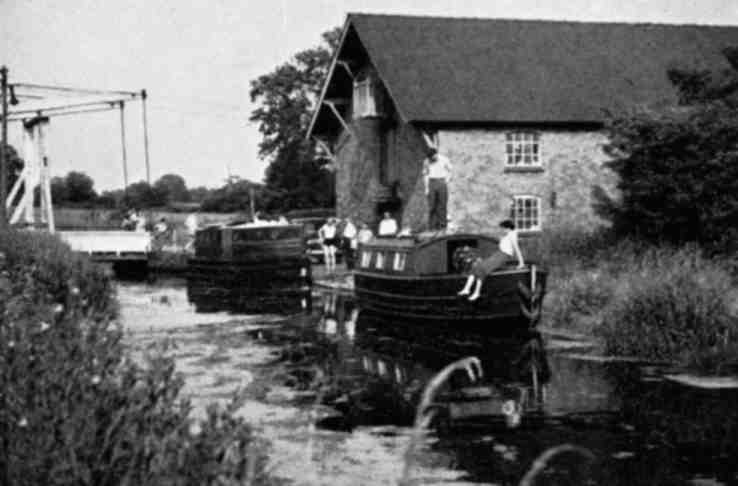
Inland Hire Cruisers' "Pat" and Holidays Afloat's "Jean" at Wrenbury in the late 1950s
(Photograph - Canal and River Trust)
One essential piece of equipment that was supplied with the boat was aluminium “Billy” can complete with removable lid and wire carrying handle and wooden grip on top. The can was capable of holding a quart (two pints or 1200 ml) and was to be used for bringing back the milk on farm visits. I well remember donning “wellies” and trudging across many a muddy field, avoiding the occasional cow (and frequent cow pats) on the way to the farmhouse for our supplies. On the return journeys the route was retraced with butter, cheese and the "Billy" can filled with milk that was sometimes still warm.
Dredging was taking place on the long straight through Whixhall Moss. Standing patiently by the mud boat was a horse munching contentedly from its feeding pail whilst waiting for the boat to be filled so that it could pull it to the emptying point further along the canal. Also present was a mechanical mule… a small towpath tractor also used for towing engineless craft. They were both captured for prosperity on Jim's Bell and Howell “Sundial” ciné camera and these shots are a source of amazement to all who see them.
The Deans (the Kathleen’s owners) had a caravan (later replaced by a log cabin that is still there to this day) on the off-side of the canal approaching Ellesmere and we had been invited to call in when passing. The “Kathleen” had a loose rubbing strip, and the opportunity to have it fixed by the boat's owner was taken. Mrs Dean took mother and I down a wooded path to the nearby Colemere whilst her husband bent down and displayed his ample backside as he fixed the rubbing strip with a nail and hammer (I would have used a screw and screwdriver had it been up to me). The operation was captured on ciné film and even today it still makes me smile when ever I watch it.
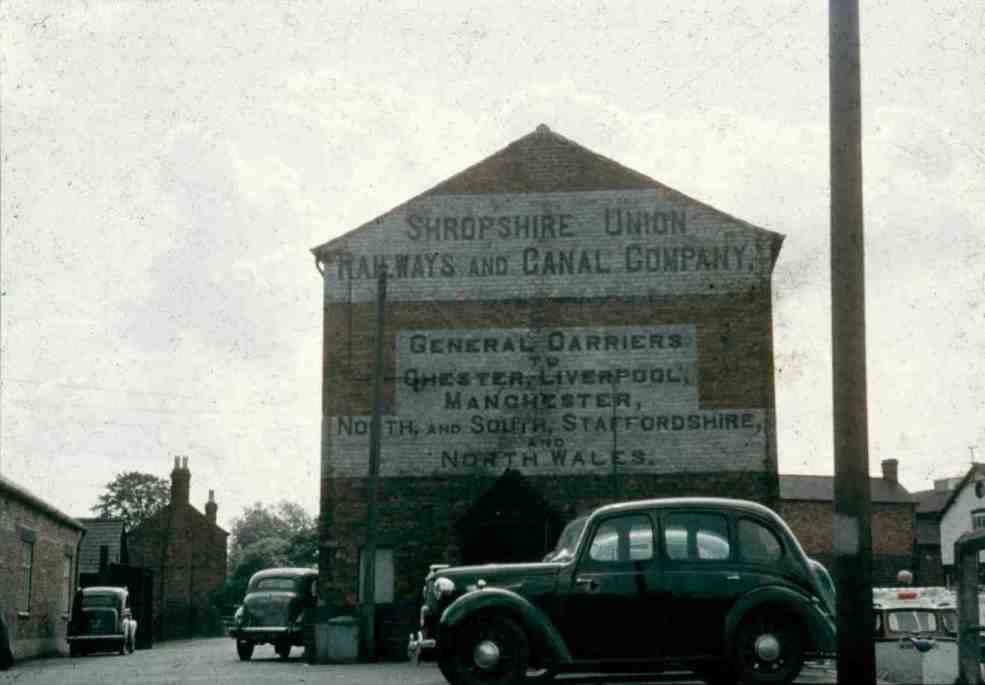
The warehouse at the end of Ellesmere Basin in the 1960s now scheduled for redevelopment
(Photograph - James M Wood)
That night we made the mistake of tying up at the end of the Ellesmere arm. It was a mistake for two reasons. One, the then United Dairies processing plant situated at the end of the arm operated all night, keeping us awake, and two, the multitude of swans in the arm, woke us very early next morning tapping on the boat's hull demanding food (or so we thought). Apparently, I have discovered that the swans were actually scraping moss off the boat’s hull and eating it. Ever since then, we have moored for the night before the junction opposite Beech House. In more recent years we have moored in the arm as the dairy is now disused (and also quieter) and the site is awaiting redevelopment.
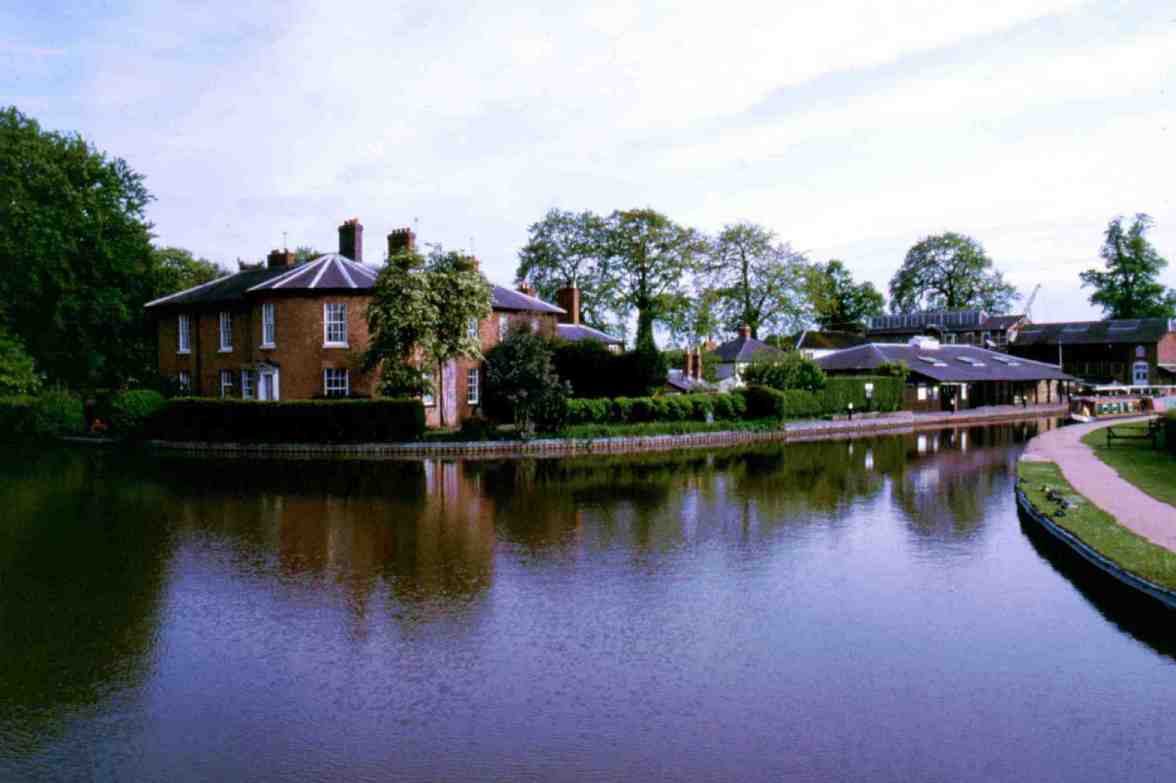
A recent photograph of Beech House at the junction with the Ellesmere Arm
The next day was to be a scorcher and after our early start, we negotiated Newmarton locks, stopped at Usher’s Stores for bread, milk and ice creams before crossing Chirk aqueduct and mooring in the basin between it and the tunnel for lunch. After lunch we surveyed the magnificent aqueduct and the adjacent railway viaduct before we cast off and plunged from brilliant sunshine into the dark, damp and exciting depths of the tunnel. I do not remember the "Kathleen" possessing a headlight but I do remember Father using a torch that he had brought with him to guide us through the tunnel. This tunnel was one of the exciting highlights of the passage along the Llangollen Canal although today it does not have the same air of mystique as we are used to longer tunnels such as Preston Brook and Harecastle.
Halfway through the cutting after the tunnel, a flotilla of boats approached us at speed from the opposite direction. The steerer of the lead boat informed us that the canal had “sprung a leak” at Llangollen, and advised us to turn around before the falling water level grounded us and left us stranded. This we did, and after turning around we followed in their wake to Newmarton Locks and relative safety.
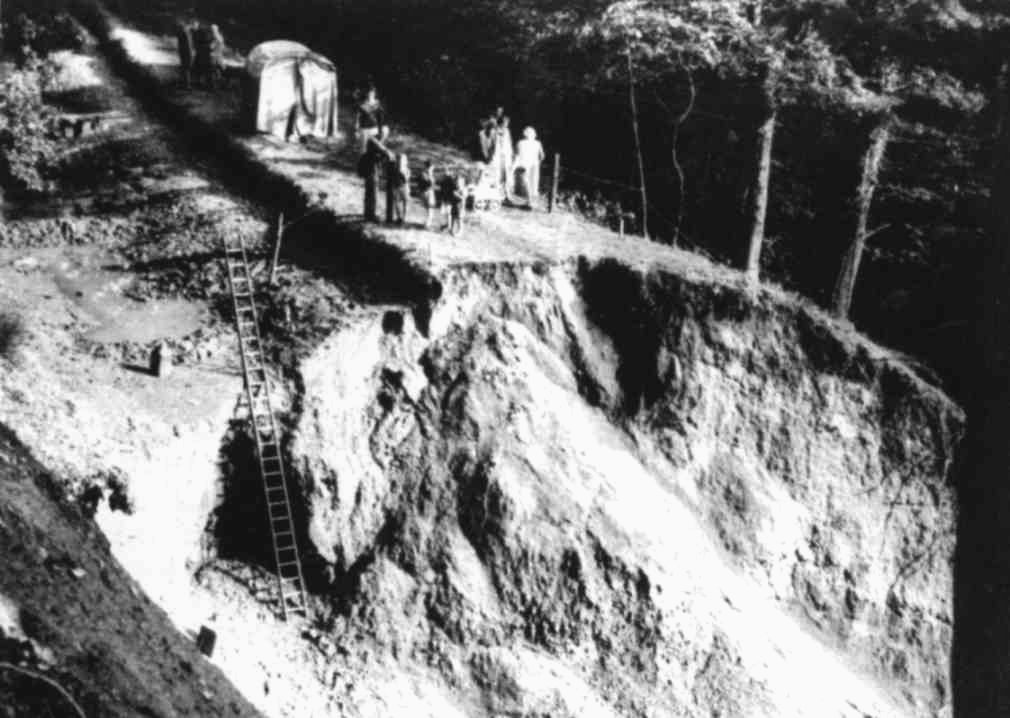
An archive photograph of the Llangollen Breach in 1960
(Photograph - Canal and River Trust)
By the time we reached the locks, quite a queue had formed. We eventually passed through the locks as darkness fell. We made the passage just in time as the water level in the canal was dropping at an alarming rate and we only just cleared the top cill of the lock. Once through the lock, we moored for the night where craft had triple moored in the pound between the locks. Early next morning, Father untied us from the adjacent boats before anyone else was awake. He then “poled” us away from the other boats to the lower lock and operated it single-handed. Once through it he again poled us past the rest of the moored craft before starting the engine. I can still remember waking up to the throb of the little “Stuart Turner” and we covered quite a few miles before tying-up for breakfast. Mother christened the act of poling as Father doing his “vulgar (not Volga) boatman act”, a term that lasted throughout our boating adventures up until Father’s death in 1978.
The rest of the journey back to Hurleston was without incident. As we had time on our hands, it was decided to back-track along the “Shroppie”. We moored on the embankment at Nantwich and walked into the town for shopping. After we had bought our supplies we returned to the boat, cast off and made our way to Hack Green locks. We moored above the locks by the lock keeper’s cottage and the old stables used by British Waterways Board for tool and equipment storage. The garden contained apple and damson trees, the fruit from which we helped ourselves to, as well as up-rooting a small damson tree to transplant in our garden at home. Talk about ill-gotten gains though, once replanted at home it never bore fruit to my knowledge. Just above the locks was a radar station with a gigantic rotating scanner. This remained one of the landmarks at Hack Green for many years until it was dismantled in the late-sixties.
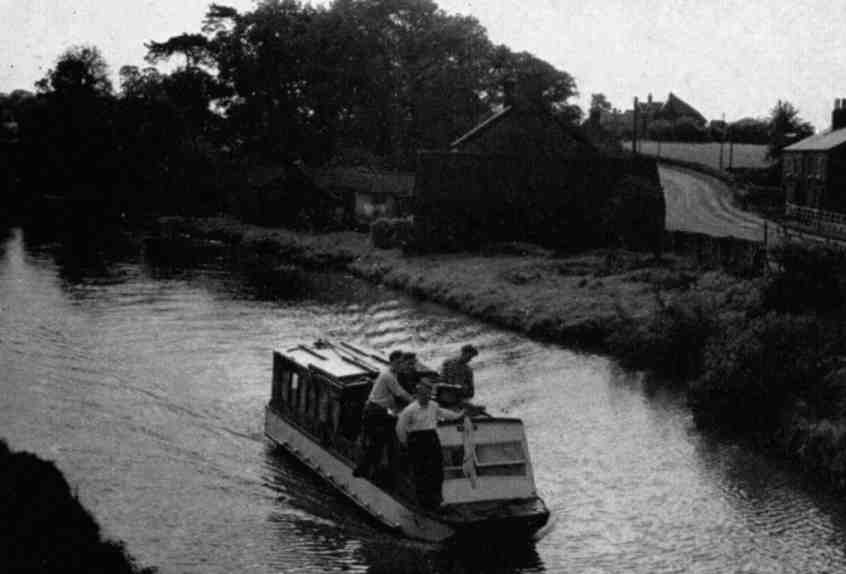
Dean's converted pontoon "Dorothy" near Barbridge Junction in the late 1950s
(Photograph - Canal and River Trust)
The following day was Friday and time to turn around and head back towards the cruiser base at Christleton. That evening, we moored at Waverton ready for the return to the base the following morning.
We made the short cruise to Christleton in virtual silence as we were not looking forward to going home after our wonderful holiday. On our arrival at Christleton, Mister Shaw was waiting for us. Whilst we were loading our luggage (and Damson tree) into the Humber, Father went to see Sid Dean to have the money refunded that he paid for the engine decoke at Norbury. He also paid a deposit on “Kathleen” for the same two weeks in following year,... 1961. We were all bitten by the canal cruising bug, and hoped that next year we would reach Llangollen.
Little did Father realise that in answering the advertisement in the “Liverpool Echo” for a canal boating holiday just how much he had changed the future and shaped the rest of our lives!
Chapter 3 -
1961, Llangollen at Last
After our aborted attempt to reach Llangollen the previous year, in 1961 we were determined to reach our goal no matter what. This time, Jim was able to have the same holiday period as the rest of us and could enjoy the whole two weeks instead of having to be picked-up part-way through the holiday as on the previous year.
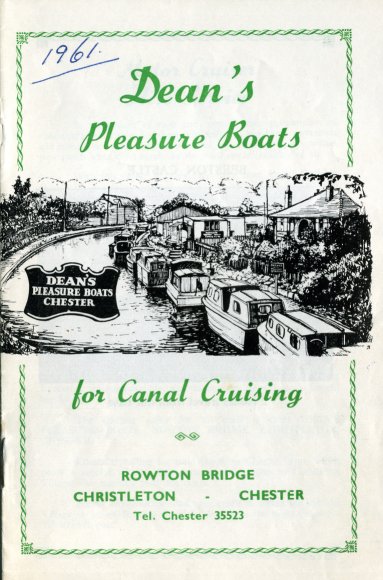
Dean's brochure for 1961 showing their base at Christleton
It seemed a long year as we willed the last week in August and the first week in September to arrive. I spent many hours designing and drawing my “ideal fantasy canal cruiser” (usually based on a “Taylor” design) in my drawing book. Sometimes Jim joined me and we would produce a combined effort. I even made “Lego” models of boats, canal locks complete with opening gates and lift bridges which actually lifted.
We repeatedly watched the home-movies that Jim had made the previous year on his Bell and Howell “Sundial”. This camera was destined to be replaced by a Bell & Howell “Autoset” and later on again by a Bolex C8 accompanied by the obligatory Sangamo Weston Master III light meter (complete with “Invercone”). Jim's home movies were (relatively) well edited and possessed titles. They also usually ended in an animated sunset usually taken from the banks of Hurleston Reservoir. We also repeatedly read the British Waterways Canal Guides that we already had, remembering the places to tie-up and the places not to. Father bought two more of the booklets covering the Trent and Mersey Canal (North and South) and I can remember marvelling at the photograph of the Anderton Lift and wondering what the long tunnels at Preston Brook, Saltersford and Barnton were like… in years to come, I was to find out. In the early editions of the guides, the booklets didn’t have photographs on the front cover and the canal was represented by a straight brown line on the maps (quite apt really). In later editions, a photograph was added to the front cover and the canal was changed to a blue line. On my bookshelf, I still have a complete set of these guides, some of which I had bought with my pocket money at Ladyline’s Barbridge base (the original copies are complete with Father’s handwritten pencil notes in the margins). I still read them today and remember the magical memories of our early canalling experiences that they awaken. Some of the photographs from these guides are reproduced in “Canalscape” courtesy of British Waterways.
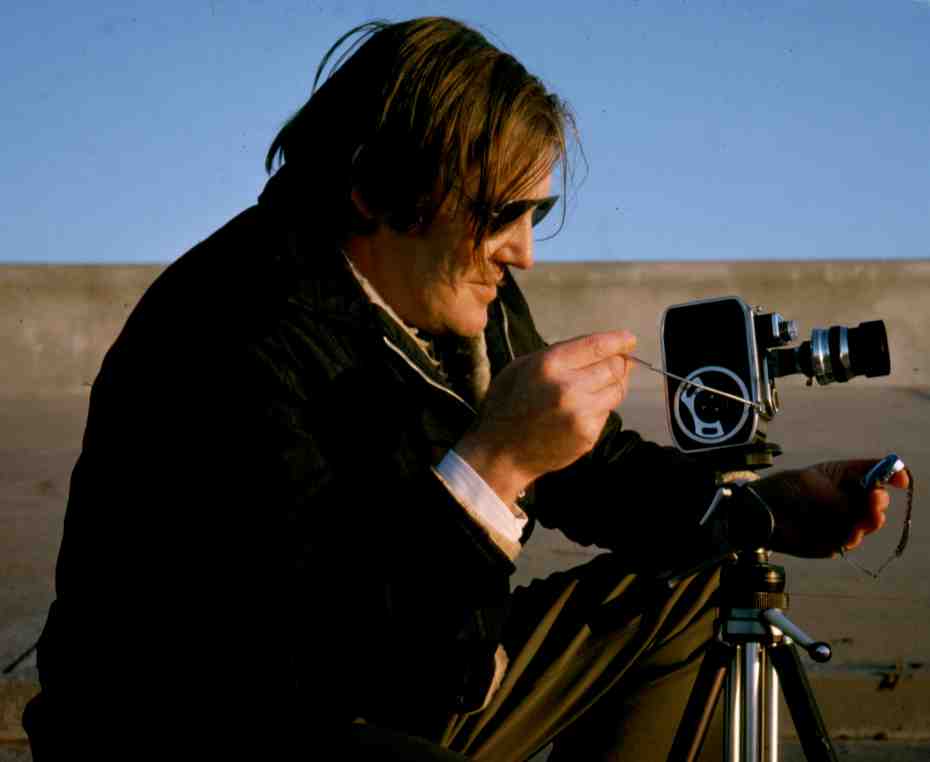
A windswept Jim, complete with Bolex B8SL and Möhler widescreen lens capturing a time-lapse sunset
More items were added to the “Holiday Drawers” and some items removed as experience deemed them as not being necessary and a set of four sleeping bags purchased. Mother spent many hours covering the nylon outer layer of the bags with purple, black and white horizontal striped blankets to ensure that we were all warm enough. We even had trial runs in the sleeping bags (just to make sure!). At last, the school summer holidays arrived and our holiday time approached. We were soon loading our luggage (and sleeping bags) into Mr Shaw’s Humber again and heading for Dean’s Pleasure Boats once more.
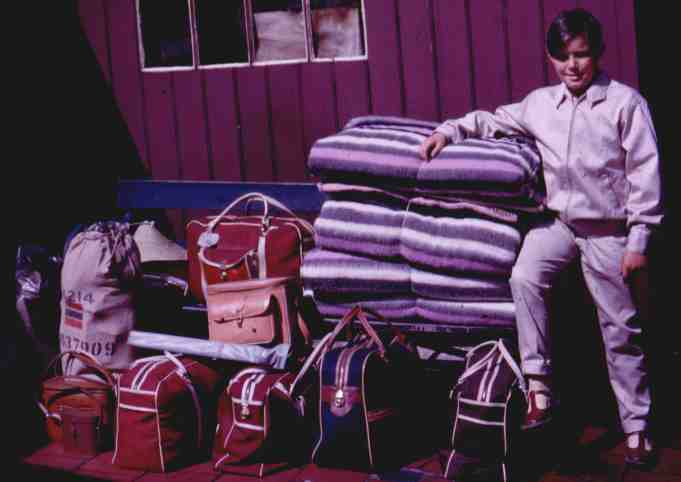
The luggage and me waiting for Mister Shaw
(Photograph - James M Wood)
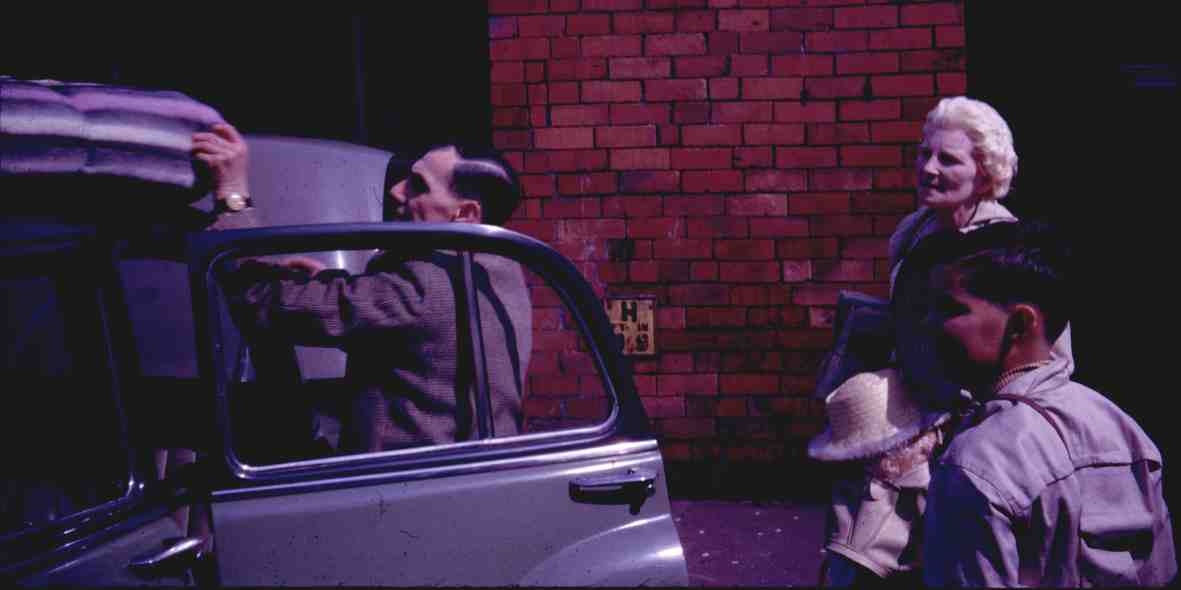
When Mister Shaw did arrive it didn't take long to load up the car and be on our way
(Photograph - James M Wood)
This particular year, Dean’s hire cruiser base had moved from Christleton on the outskirts of Chester to Barbridge Junction near Nantwich, where the “Shroppie’s” Middlewich branch joins the main line. To reach the car park area, a hump-backed bridge had to be crossed. This bridge was (and still is today) quite steep and the Humber, being quite heavily laden, “bottomed out” on the crown of the bridge. We all had to get out of the car in order for it to reach the car park and unload our luggage. We were later to discover that the car’s exhaust had been damaged by this incident. On our arrival, the boat was handed over to us and we bid Mr Shaw goodbye until he collected us two weeks hence and arranged to pick us up opposite the “Jolly Tar” public house and so removing the need for the Humber to tackle the hump backed bridge again.
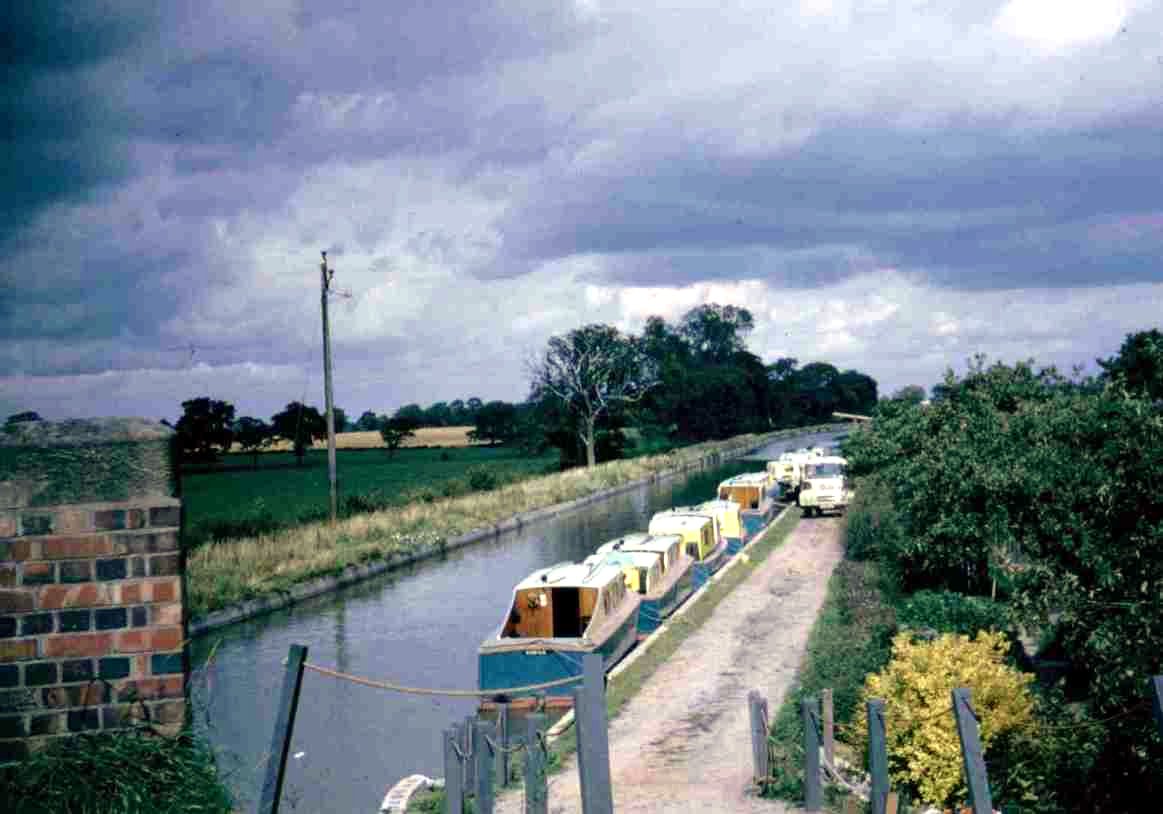
Deans Pleasure Boats hire base at Barbridge Junction in 1961
(Photograph - James M Wood)
The “Kathleen” had a new colour scheme for 1961, which we didn’t particularly like but, apart from this, she was the same as the previous year. We were soon under way and reached Hurleston Junction, the start of the Llangollen Canal, soon after. Before locking into the canal, we moored in a small feeder from the adjacent reservoir, had a cup of tea, a snack and did some unpacking. We also took the opportunity to inspect the reservoir hidden behind the high banks. I remember on one occasion, we watched a school of fish being chased by a larger fish… a Pike I think, as they came around the reservoir every ten minutes or so… the length of time it took them to circumnavigate the reservoir.
The trip to Llangollen was without drama. We said hello to “Happy Harry”, the lock keeper at Hurleston and stopped at our usual haunts like Wrenbury, Quoisley, Ellesmere (but not overnight), etc. In 1961, bridge 20 at Wrenbury was opened by turning a windlass that wound-up a chain to open the bridge. Next to the bridge was John Sumner’s Mill which is now the home to Anglo Welsh Canal Holidays. On the first night we stopped at Quoisley Lock having made really good time. The Llangollen Canal’s cantilever lift bridges were a source of entertainment for me and, no doubt, many other children. If we moored close to one, I would open it for other boats provided that the chain used for opening them was long enough for me to reach (much to the annoyance of any children on board) and after the boat had passed through I would run up the bridge’s platform as it closed with a bang. It’s no wonder that these bridges needed constant maintenance and I don’t think that today’s electrification or provision of hydraulic lifting mechanisms provide as much fun for the younger generation as the older “heave on the chain” variety did.
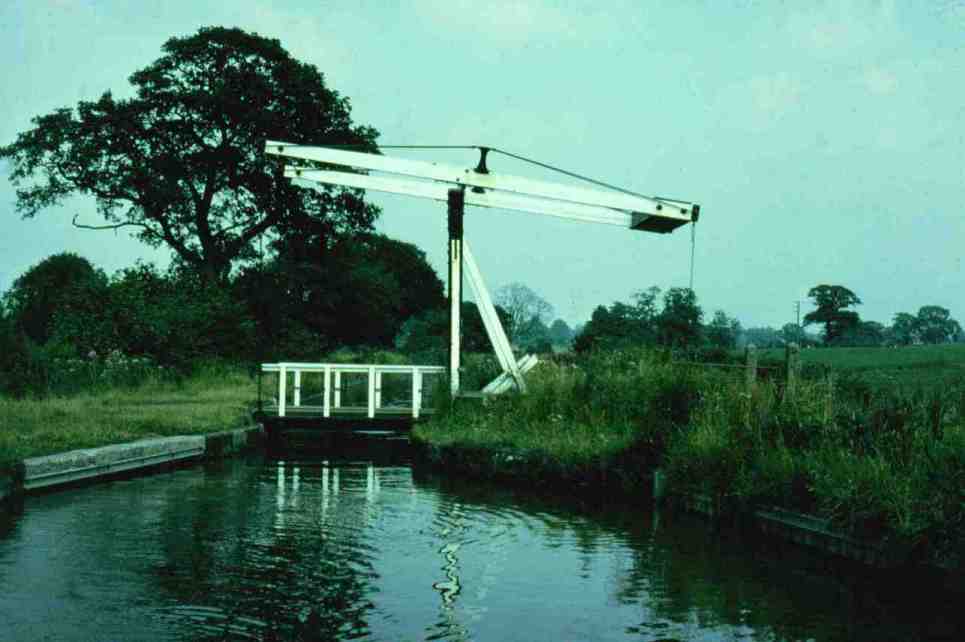
|
One of the Llangollen Canal's lift bridges - this example is near Whitchurch |
|
(Note the chain dangling from the counterweight) |
We were soon cruising the upper stretches of the canal denied to us the previous year due to the canal’s breach near Llangollen. We stopped at a garage adjacent to the canal where it was crossed by the A5 trunk road. Here there was a landing stage where boats could moor in order to buy petrol from the garage. The BP Boat Services sign was displayed here and consisted of a boat’s propeller on a shaft in BP’s familiar yellow and green corporate colour scheme. There were also several boats moored here and one boat in particular… the “Acorn” caught my eye. It was a centre cockpit, varnished carvel hulled cruiser similar to the Taylor cruisers but obviously not one of that type due to the “line” of the craft being not as graceful as the Taylors. A little further on I was lying on the top of the rear cabin roof as we were passing along a wooded embankment when we noticed a narrowing in the canal ahead. Not having travelled up the canal this far we did not know that we had reached the mighty Pontcysyllte Aqueduct. Mother helped me down off the roof just as we started to cross the aqueduct in case I fell over the unprotected side of the aqueduct into the fields below.
Once we had crossed “Ponty” (as we called it), we moored the boat by the dry dock and went to inspect this monument to Thomas Telford’s civil engineering skills. The towpath over it was at that time in a poor state of repair and closed to pedestrians so we decided to view it from below. I remember scrambling down the valley side to the banks of the River Dee and looking up at the canal trough one hundred and twenty six feet above our heads. This fantastic structure was awe inspiring then and even when I revisit it now (either by car or by boat) I am always moved by the sheer scale of its construction. It is most definitely the jewel in the Llangollen Canal's crown.
After our climb back up the valley sides we returned to the boat and resumed our journey to Llangollen. Above the aqueduct, the canal was extremely narrow and shallow in places. This is due to this stretch of the canal being designed as a navigable feeder and its main function was to carry water from the end of the canal where it meets the River Dee.
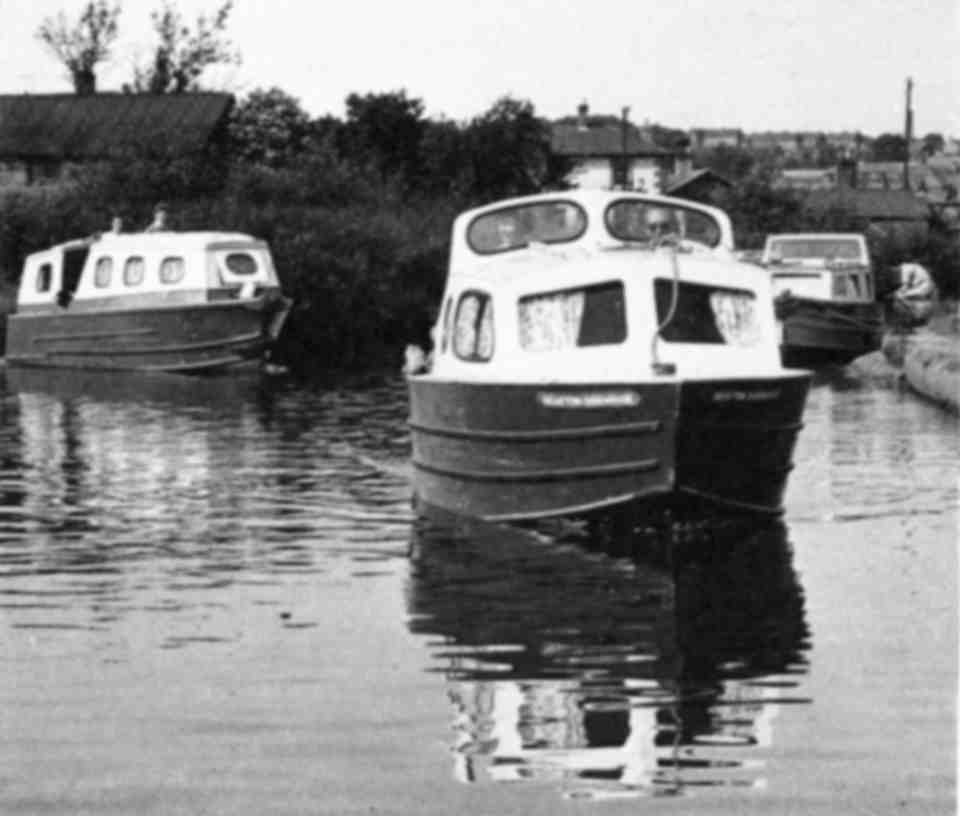
"Drayton Dormouse" and either Dean's "Ursula" or "Mabel" at Trevor approaching "Ponty"
(Photograph - Canal and River Trust)
On the way to Llangollen, we passed the site of the breach that caused our cruise on the canal the previous year to be cut short. The embankment had fresh scars that pinpointed the exact spot where the water from the canal had washed away trees and the railway line below. This stretch has always proved troublesome and today is now almost completely lined with concrete but the scars of 1960 are still visible nearly fifty years on.
When we reached the town of Llangollen, there were no mooring places available (some things never change, although the new marina has provided the much needed additional temporary moorings) so we decided to carry on cruising up to the Horseshoe Falls two miles further on. At this time, craft could navigate the even narrower and shallower stretch of the feeder above the town all the way to the Valve House adjacent to the Chain Bridge Hotel at the end of the canal. Today, the only craft able to do this are the horse-drawn pleasure craft, canoes and rowing boats. On a later trip in 1984, I noticed that concrete humps had been added to the canal bed at bridge holes to prevent larger craft from proceeding beyond the winding hole past the moorings (and, no doubt, provide the trip boats with additional passengers).
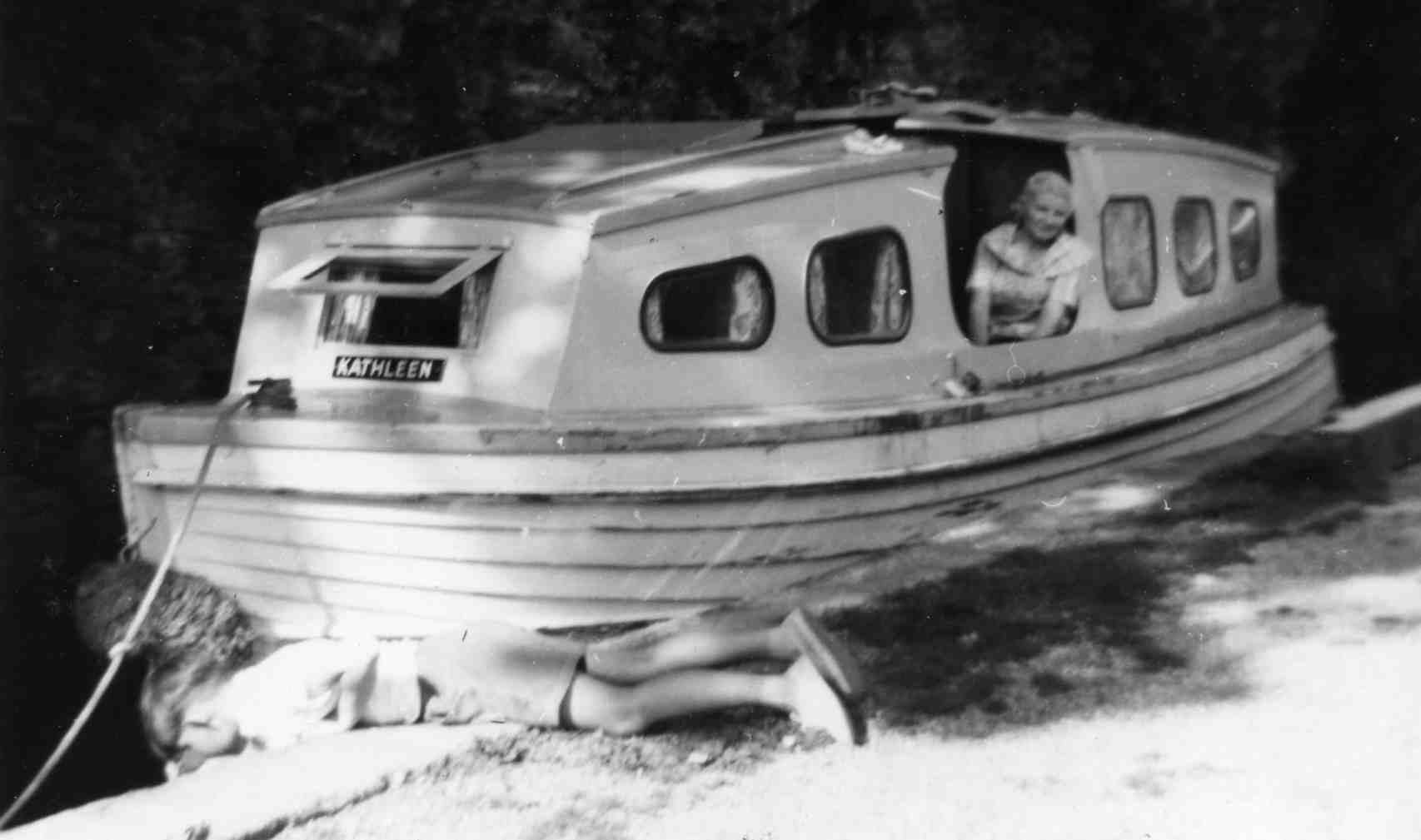
Mother watching a young Cyril Wood fishing at the Chain Bridge in August 1961
(Photograph - James M Wood)
We tied-up adjacent to the Chain Bridge Hotel and walked the last few yards to the Valve House and the Horseshoe Falls just beyond it. Here, we admired yet another of Thomas Telford’s wonders. In order to provide the canal with a plentiful water supply, Telford raised the level of Lake Bala or, to give it its Welsh name, Lyn Tegid (the source of the River Dee). This was accomplished by damming the Dee where it exited the lake and constructing a weir to control the flow of water out of the lake and down the river. He also constructed another weir two miles upstream of Llangollen at Llantisilio in the shape of a horseshoe, hence the name “Horseshoe Falls”, which provides a head of water regulated by the Valve House prior to being fed into the canal.
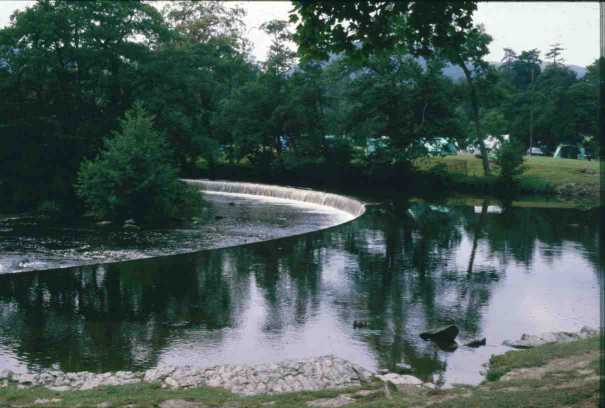
The Horseshoe Falls at Llantisilio... the source of water for the Llangollen Canal
After this visit we returned to Llangollen, which necessitated reversing the “Kathleen” half a mile to the first available spot wide enough to turn her around. Once we reached the town, we tied up at the end of the line of moored craft and went to explore. This was my first visit to Llangollen and to this day it remains one of my favourite places, even when visited by car.
Having reached our goal, we were able to take our time cruising back down the Llangollen canal, inspecting “Ponty” and its smaller sister at Chirk in more detail. When we reached Hurleston Junction again, we turned right and headed towards Wolverhampton. As with the Llangollen Canal we were able to take our time and see various features of the canal that we did not have the time to inspect the previous year when we were on a tight schedule. One of the highlights of the “Shroppie” for me was the passing of the Nantwich and Border Counties Yacht Club moorings. Here I could see more of the beautiful varnished mahogany Taylor craft that I had used as the basis of the “ideal fantasy boats” that I regularly drew on my drawing pad. For additional information on J H Taylor's mahogany cruisers see "Don't Call It A Barge" or visit the website dedicated to them at... http://www.jhtaylorboats.com/JHTaylorboats/home.html
We stopped at Nantwich and went into the town that was to become another of my favourite places; due in the first instance to the quality of its toyshops and more latterly, because it possessed a “proper” camera shop. After Nantwich we had an overnight stop at Hack Green. We were woken the next morning by a sound that was to become one of the most emotive sounds ever heard on the cut… “Bumpah… bumpah… bum… bumpah… bumpah”. This was the sound of a “Bolinder” semi-diesel engine. In 1961, the canals still had commercial traffic on them and we regularly encountered working narrowboats accompanied by their butties. We had passed them the previous year whilst cruising, but this was the first opportunity we had to inspect them close-up. The motor boat was loosely moored at the head of the lock whilst the lock was filled to allow the butty to rise up and accompany its partner.
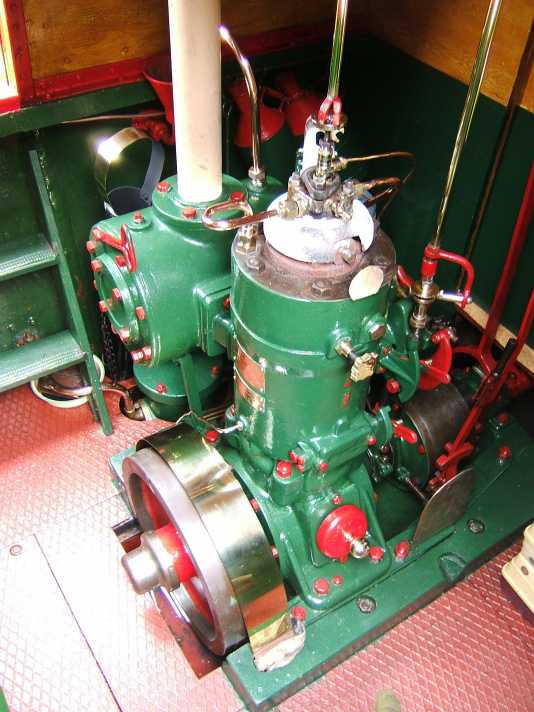
A contemporary photograph of a 15 hp Bolinder engine (alias musical instrument)
They were both heavily laden and, as they were not fully “sheeted up”, we could see into their holds which were filled with a cargo of aluminium ingots. The engine room doors were open which allowed us to view the “Bolinder Beast” that resided within, which was lazily ticking over awaiting instructions. We chatted to the boatman about the engine and he informed us that he preferred Gardeners or Nationals as they were easier to start (no blowlamp required) and they reversed more reliably. He explained to us that when selecting reverse that the engine would stop dead and bounce off its compression to effectively run backwards. On numerous occasions, when going into reverse the engine would stop dead and not restart backwards but stall, causing the boat to crash into the gates of many a lock. The boatman let us see inside his rear cabin and we were amazed by the neatness of its contents, the paintings and lace plates that were everywhere… on the doors, on the underside of the tables, and water containers that I later discovered were called “Buckby Cans” after the locks on the Grand Union Canal were they originated, and “Dippers”… small pan-like containers with handles on them which were placed next to Buckby Cans. Even the mops stales and boat poles were brightly painted in a spiral fashion containing traditional canal colours.
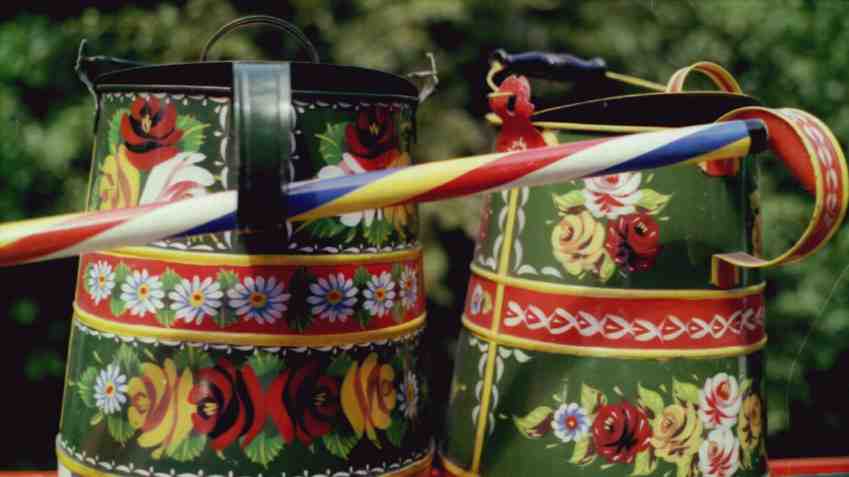
A contemporary photograph of Buckby Cans and a spiral painted mop stale
When the water level had risen we opened the top gate and the butty exited, we felt quite important opening and closing the lock gates and paddles after the craft. The crew gave friendly waves as they left and we could hear the Bolinder working away, missing the odd beat, for at least another fifteen minutes.
After breakfast, we cast off and made our way to Audlem and tied up after three locks at the place now occupied by the “Shroppie Fly” public house. On our way into the village we passed a mill (now the Audlem Mill craft shop) that had a covered loading bay extending over the canal towpath. Father said that the mill contained a “gas engine” and we peered through the mill doors to see it in operation. The gas engine is a conventional internal combustion engine that runs on town gas instead of oil. On this occasion it was working and the sound it made was not dissimilar to that made by a Bolinder but with a more regular beat. A large pipe ran up the side of the building which took away the engine’s exhaust and high above our heads we could bear the throaty note that the large bore of the pipe produced. On latter day visits to the mill, I have noticed a sign informing interested parties that the mill once contained an “oil engine”. Maybe my father was incorrect in stating that it was a gas engine. Well, we are, none of us, perfect… including my father!
We returned from the village with our supplies and proceeded up the locks where we met another pair of working narrowboats. We pulled in to let them go past before we carried on up the flight without incident.
That night we tied-up at Market Drayton. In the town there was another toyshop that required close inspection. I remember being bought a rocket launcher that propelled a rubber-tipped projectile twenty feet into the air for 19/6 (97.5p). I also remember going into Woolworth’s where Father bought a couple of small fishing lines wound on a plastic reel, complete with float, weights and hook. After leaving Market Drayton we moored up below Tyrley locks at a landing stage made from engineering brick on the side of the canal opposite to the towpath. I later learned that this and the other similar landing stages were for the milk boats to moor whilst they picked up the churns of milk to be delivered to the Cadbury factory at Knighton further along the canal. There is a large oak tree in the centre of the adjacent field and Father told me that this is where King Charles the Second had hidden from the Parliamentarians during the English Civil War in 1651. At the time I did not know if he was right or not, but now know that King Charles the Second hid in an oak tree at Boscobel House near Brewood further up the canal. But I wasn’t particularly interested in all that, I just wanted to have lunch and try out my rocket launcher!
The inaugural flight of the rocket was successful and we soon set off for Tyrley Locks. This first lock in the flight is located inside a rock cutting and is sheltered by a canopy of trees. Such is the beauty of this flight of locks; it became one of our favourite locations on the Shroppie.
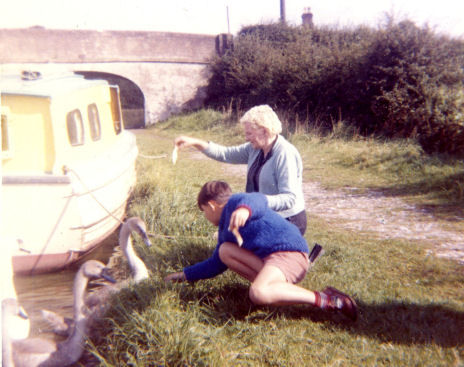
Yours truly and Mother feeding swans at Gnosall
We moored for the night past the Wharf Tavern at Goldstone, adjacent to another large field that contained crops. Mother had forgotten to buy turnips to go with the carrots whilst in Market Drayton and Father said he thought that the field contained turnips so we went into the field and dug one up. We returned with the largest turnip I had ever seen, which was duly peeled, diced and cooked. I didn’t like vegetables then so I didn’t have any but I will never forget the look on everybody’s’ faces as they ate the meal that containing the carrots and “turnip”. Apparently, the taste was horrible and Father said maybe it wasn’t a turnip that he obtained from the field after all, but a mangleworzel! Talk about ill-gotten gains!
After tea, Father christened the fishing line bought in Market Drayton but unfortunately, he didn’t catch anything with it. The compressed bread he used as bait kept falling off leaving the hook exposed which may not have looked very appetizing to passing fish. Our only other means of entertainment was a “Murphy” B385 transistor radio complete with a tan PVC carry case. It was the first “Murphy” transistor radio, had push-button LW/MW/off buttons and took two PP9 batteries (the great big nine volt batteries) and Father had bought it specifically for the holiday. We spent many hours listening to Radio Luxemburg “On 208... your station of the stars” not to mention featuring “Keynsham spelt K. E. Y. N. S. H. A. M, Keynsham, Bristol” (an advertisement for the football pools I think) and in later years... Radio Caroline (on 199) the infamous pirate radio station, as we sat on the roof of the boat in the sunshine or inside the cabin if it was raining.
We travelled as far as Brewood and I can remember that it was raining when we reached there. After mooring the boat we donned our plastic macs and struggled up the path that lead to the village. We walked around the shops purchasing the usual perishable items and in a newsagents-cum-toyshop I spent some of my pocket money on a blue plastic Tallon Tek construction kit and on our return to the boat I took over the table to try out my new purchase. This occupied me for a couple of hours until the rain stopped and we turned around to retrace our steps back down the “Shroppie”.
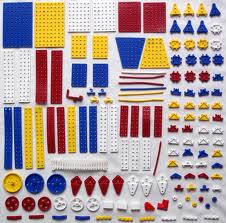
Parts of a Tallon Tek construction kit recently sold on eBay
The rest of the holiday was without incident and all too soon we were heading back to Barbridge Junction. After the fiasco at the hump-backed bridge, Mister Shaw decided to meet us on the towpath on the opposite side of the road to where the Jolly Tar public house is. Whilst we put the luggage into the car’s cavernous boot, Father took the boat back to its moorings and booked “Kathleen” for the following year. On his return we departed the world of canals until the following year.
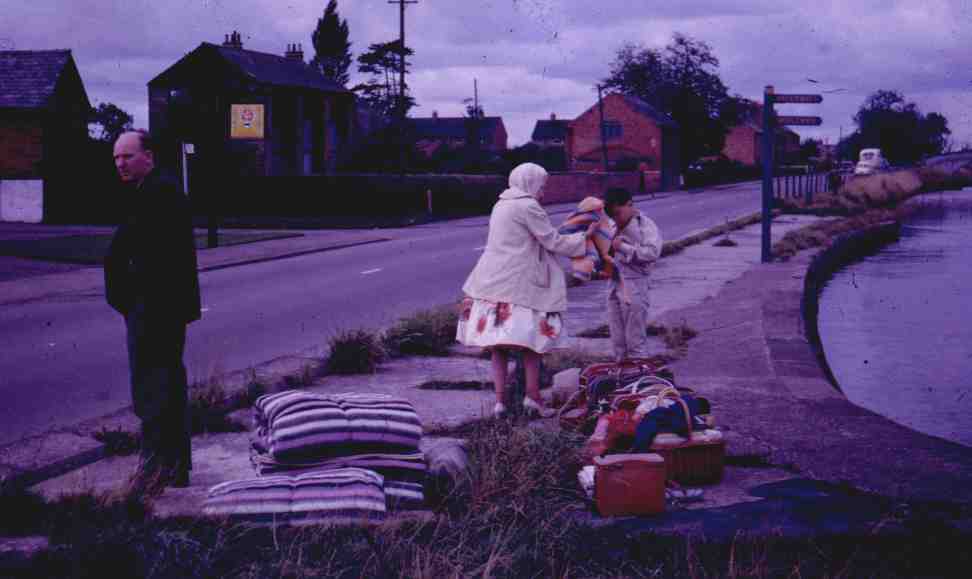
Waiting to load our luggage into the Humber at Barbridge
(Photograph - James M Wood)
The intervening period would, no doubt, seem like an eternity. But we had our home movies shown on the Bell and Howell “Moviemaster” (usually accompanied by Bert Kaempfert’s “Swinging Safari” L.P.) to refresh our memories and I had my boat drawings to occupy myself with. As previously mentioned, Jim would quite often join me and we would create on paper our dream boat. On one occasion, Jim drew a centre cockpit cruiser with trapezoidally shaped windows except for where the toilet was which was round in shape. He named this boat “Exodus” after his favourite film of the time. The following year, we saw a boat that was virtually identical even down to the trapezoidal windows, colour scheme and name. Coincidental or what? Not too long ago I saw the same “Exodus” out of the water at the Boat and Butty Company’s boatyard on the Bridgewater Canal at Runcorn and on one of our “Boys’ Days Out”. I took Jim to see her. She was looking the worse for wear and needed a lot of work doing on the hull but she was definitely the same “Exodus” that we drew and saw in 1961/62.
Our Christmas presents now included many things that were canal orientated. For Christmas 1961 Father and I both received identical fishing outfits consisting of a green fibreglass rod, fixed spool reel, floats, lures, weights and hooks. The complete outfits were contained in a fitted case ready for use. Unfortunately, we had to wait eight months to use them. Father also received a couple of books on canals which, along with many others, are now part of my extensive collection of waterways books and publications.
Jim changed his Bell and Howell “Moviemaster” cine projector for a Bolex 18-5 (far superior). After making his new purchase, he bought me a model boat. It was a Vosper triple screw express gas turbine motor yacht made by Victory Models, renowned for their models of Vosper Motor Torpedo Boats. It featured three brass propellers (contra-rotating) and three brass rudders all correctly synchronized. Unlike the fishing rods, the model boat didn’t have to wait until the summer to be tried out as there was a model boating lake in New Brighton, not too far from where we lived. The model boat was christened “Phaedra” after a boat featured in a film of the time and I had stuck a photograph of the real thing inside the box. Being a keen model enthusiast, I made a few additions to it. Corgi made a model of a “Dolphin 24” cabin cruiser which was mounted on home-made davits glued onto the stern of “Phaedra”. After trial runs, the “Mighty Midget” electric motor was replaced by a more powerful unit which still ran off the same four HP11 (“D” cell) batteries but was more efficient and faster. This model was to provide me with many hours of pleasure and I have memories of sailing it in the top lock at Hack Green later on in the year. Years later it was handed down to my eldest son... Michael, who also enjoyed many happy hours playing with it both in and out of the water. The boat on which the model was based was originally called "Mercury" but has had several names since and at present is named "Brave Challenger".
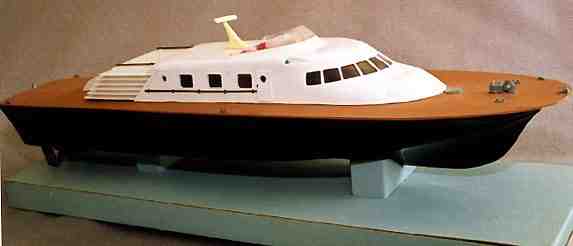
The "Victory" model of "Mercury"...
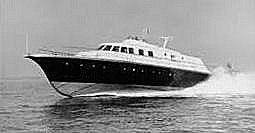
... the photograph that was glued to the inside of the model's box...
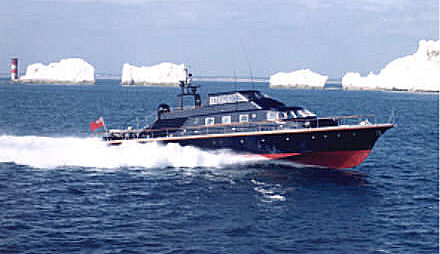
...
and the genuine article now named "Brave Challenger" in Freshwater Bay, Isle of WightAfter reaching our goal the previous year, we decided to repeat the performance for 1962. The only change to the route we took was that Dean’s hire cruiser base had reverted to Christleton and we cruised the “Shroppie” first before heading up the Llangollen Canal. It was a brilliant holiday with good weather and no hold-ups caused by break downs or canal works, however, one incident is engrained in my memory.
As a child I couldn’t (and still cannot) swim, as I had (and still have) a fear of water and after my mentioning that fact, I’m sure that you know what is coming next. We were cruising past the old disused RAF base near Shebdon Embankment and Jim was at the helm of “Kathleen”. Father and I were sitting on the front of the boat when he asked me to go and fetch a cigarette for him. I walked down the side of the boat to collect the cigarettes and matches but as I walked back to the front of the boat I was “buzzed” by a wasp. I hated wasps and in my panic, I slipped and fell in to what must have been one of the deepest parts of the canal.
Father immediately jumped in to rescue me and even he couldn’t stand up in the canal due to its depth being grater than his height. I remember grabbing hold of his head and pushing it under the water in order for me to breathe. Without his prompt action, I would surely have drowned. We were soon sitting on the side of the canal dripping from head to toe. Jim had brought the boat to a standstill and we got up onto the towpath and climbed on board the boat. My brother was too pre-occupied with the situation to reach for the cine camera to record the incident, which, I suppose, was just as well (even though he did request an action replay for the camera). After drying ourselves and changing our clothes Father asked me… “What happened to my cigarette?”
For hours afterwards, the contents of Father’s wallet were hung up to dry on the miniature washing line. It seemed funny to me and I don’t know what the crews of passing craft would have thought at the sight of ten shilling, one and five-pound notes strung up to dry. Mother told Father to buy me a life jacket as soon as possible. This he did for the following year just in case there was a repeat performance. In the meantime, I was banned from the front of the boat whilst we were moving. Whilst on the subject of the life jacket, I must admit that I didn’t like wearing this bright yellow straitjacket and even hid it behind the sofa in the dining room one year when we were packing our things into Mister Shaw’s taxi in the hopes that its absence would not be noticed. My ploy was successful and it was not missed until we reached Dean’s. Although the following year, Mother and Father made sure that it was packed. As well as the purchase of a life jacket I was enrolled onto a swimming course at our local swimming baths which enamoured me even less than the life jacket. I was horrified when the instructor told me to jump in at the deep end. Needless to say, I refused point blank and did not attend again much to the dismay of my mother who had spent nineteen shillings and sixpence (97.5p) on the lessons to no avail.
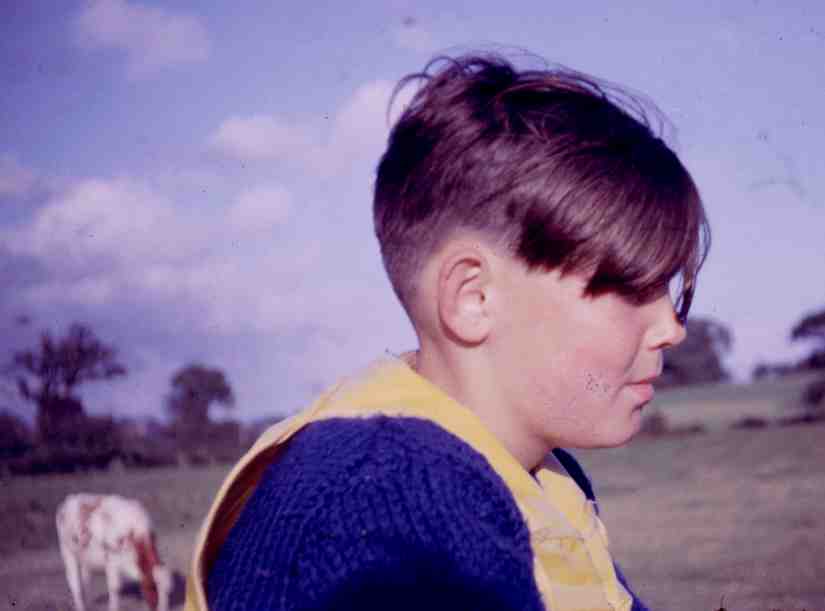
A rare photograph of the author wearing his life jacket
(Photograph - James M Wood)
Over the course of the previous years, we had gained considerable experience in knowing the best places to obtain milk, eggs, bacon etc. One of our regular stops for provisions was at Starkey’s Farm which could be reached by walking down the lane from bridge 17 on the Llangollen Canal near Wrenbury.
My memories of Starkey’s Farm are of a vintage Rolls Royce (complete with windows “yellowed” with age and horizontal radiator grill) that was parked in the farmyard. My memory recalls that there were a large amount of wasps buzzing around and also numerous children playing in the yard, one of which was a boy a bit younger than myself. I was to encounter this boy in later years when we were both grown-up. He was none other than Chas Harden, now the owner of Chas Harden Boats at Beeston Castle Wharf on the “Shroppie”. Chas recently told me that the Rolls Royce was used as a milk float and sold to finance their first hire boat in the mid 60’s. This boat, which was to be the first of many, was usually moored at the bottom of one of their fields near to the farm between bridges 18 and 19, before they moved to their present location.
When purchasing our milk and provisions, Father usually bought a carton of fresh double cream which we “swigged” between us whilst walking back down the lane to the boat. When I tell people about drinking pure double cream they usually have a look of disgust on their faces. But having said that... they don’t possess my palette and, most probably haven’t tried it “neat”!
When we returned to the Barbridge Junction hire base after the 1962 holiday, Father went to book the “Kathleen” for the following year only to be told that she was already booked. The “Ursula” was offered as an alternative and, after looking over her, Father reluctantly booked her.

"Ursula" was to be our hire boat in 1963
(Photograph - Dean's Pleasure Boats)
Our holiday aboard “Ursula” the following year started at Christleton as Deans had sold the Barbridge site to Ladyline Cruisers, a recent addition to the hire cruiser companies on the “Shroppie”. The holiday was unremarkable except for seeing two boats sinking. One was a Dean boat... the “Peggy”. She was one of the “slab-sided monstrosities” that Father had criticised in 1959 when we first visited Deans. The hull was made out of marine plywood which appeared to be quite vulnerable to damage. The other boat that we saw sinking was the “Espathea”. She belonged to Inland Hire Cruisers and had her “clinker” planked hull punctured by an underwater object at Llangollen. When we passed her she was listing alarmingly. The hirers had removed their belongings and bedding onto the towpath, whilst the female of the party was sitting on a pile of sleeping bags, holding their cat in her arms, sobbing. It was sad at the time but we later saw them after the boat had been repaired and they seemed to enjoying the rest of their holiday, having put the sinking incident behind them.
During this holiday, one cause for concern on the “Ursula” was the toilet. We
had been used to the (now outlawed) “flush into the cut” variety and to be
confronted by the “Elsan” variety which basically was a large metal bucket with
a carrying handle and a seat on top came as a bit of a culture shock. When using
the toilet, we got into the habit of singing to mask the sounds of the ablution.
In those days there were no sanitary stations at which to empty the loo and we
were supplied with a small spade to dig a hole in a secluded field, into which
the contents of the toilet was emptied. The hole was then filled in and a hasty
retreat made. How things have changed!
The author chatting to a fellow hire boat crew member at Beeston
Iron Lock in 1964
(Photograph - James M Wood)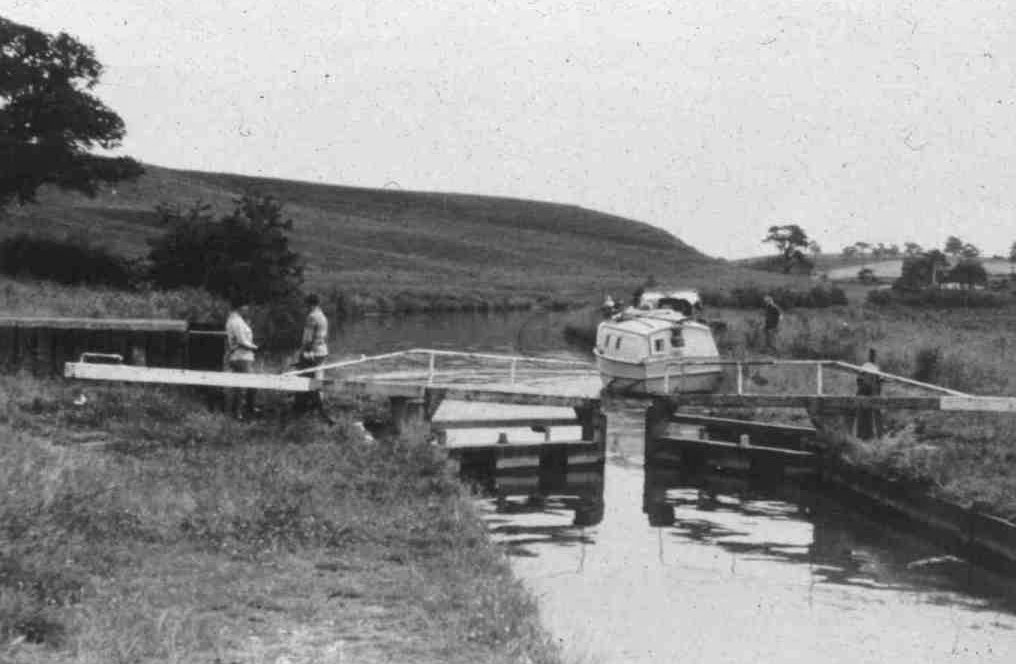
A memory that has recently surfaced concerns Mother's ballroom dancing activities. She taught ballroom dancing and had heard of dances held in Acton (near Nantwich) Church Hall on Monday evenings. I cannot remember which year it was but Mother packed on of her dresses and dancing shoes to take on holiday in the hopes that she could go to the dance at Acton. When we reached Acton on the Monday afternoon, Father (who I should explain was not a dancer in any way shape or form) moored the boat at the closest point to Acton so that, when the time came, Mother, accompanied by myself would walk across the fields to the Church Hall and spend the evening indoctrinating the locals into the latest dances of the day. Well... I can laugh now but at the time I daren't have shown the slightest sign of amusement when Mother stepped into a cow pat (moist variety) in her dancing shoes. But, I did suggest before we left, as did Father, that she took another pair and changed into her dancing shoes when we arrived at the Church Hall. I cannot remember much about the evening but it must not have been too traumatic an experience otherwise it would have been etched indelibly on my memory.
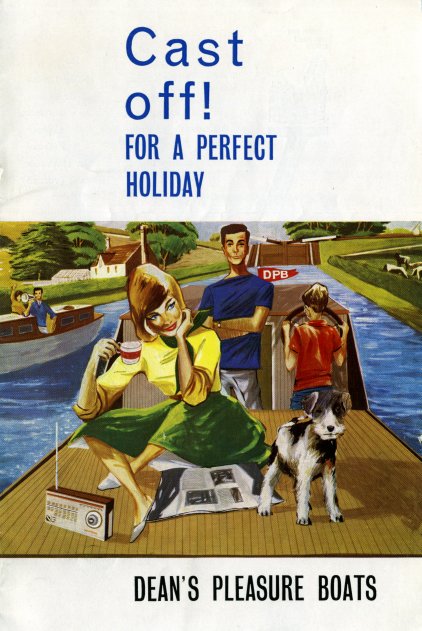
Dean's brochure for 1964 portrayed an stylised canal scene and it was in colour!
(Note the boat's steering wheel is on the wrong side for the canals)
We decided not to rebook the “Ursula” for 1964 and later on in the year, we made a trip to Dean’s in Jim’s 1951 Ford V8 Pilot that he and Father had spent most of their spare time over the previous year rebuilding. When we arrived at Christleton, Sid Dean and Stan Clegg showed us one of their newest craft, the “Maureen”. It was a boat that they had built themselves for a customer who had since died and Deans bought the boat back to place her in their hire fleet. She was of the “slab-sided” design similar to the “Margaret” and “Peggy” who we had seen sinking the previous year. “Maureen” featured an eight-horse power, twin cylinder Stuart Turner, a “deluxe” flushing toilet (still into the cut), navigation lights, an oven, water heater and plush upholstery and the cost per week was, accordingly, higher that the other boats in the fleet. At this time we had acquired a dog... Jack. The width of the gunwales around the side of the boat were measured so that our canine companion could walk around them.
Jim had taken cine film of the boat and its interior prior to our deciding to book it. When we arrived to start our 1964 holiday, the boat wasn’t ready due to a small fault. When the boat was eventually ready, we noticed some changes had been made. The “deluxe” toilet had been changed to the same type as on the “Kathleen”, the navigation lights had gone, as had the oven, water heater and plush upholstery. When challenged about the changes, Sid Dean said that no changes had been made but he soon changed his tune when informed that we had the interior on cine film and gave us a reduction on the price. We also noticed a slight smell of petrol when we took over the boat, due, we were told, to a blocked fuel line having to be cleaned out. We were to discover why it had to be cleaned out, but more of that later.
We were impressed with the handling of “Maureen”. The extra power from the additional cylinder in the eight horse power Stuart Turner made all the difference in speed and manoeuvrability but made very little difference to the fuel economy. Father’s only reservation was that she would easily catch the wind due to the flat, high sided hull but in normal conditions steered a beautifully straight line. She was longer and more spacious than the “Kathleen” and “Ursula” which made quite a difference to the accommodation.
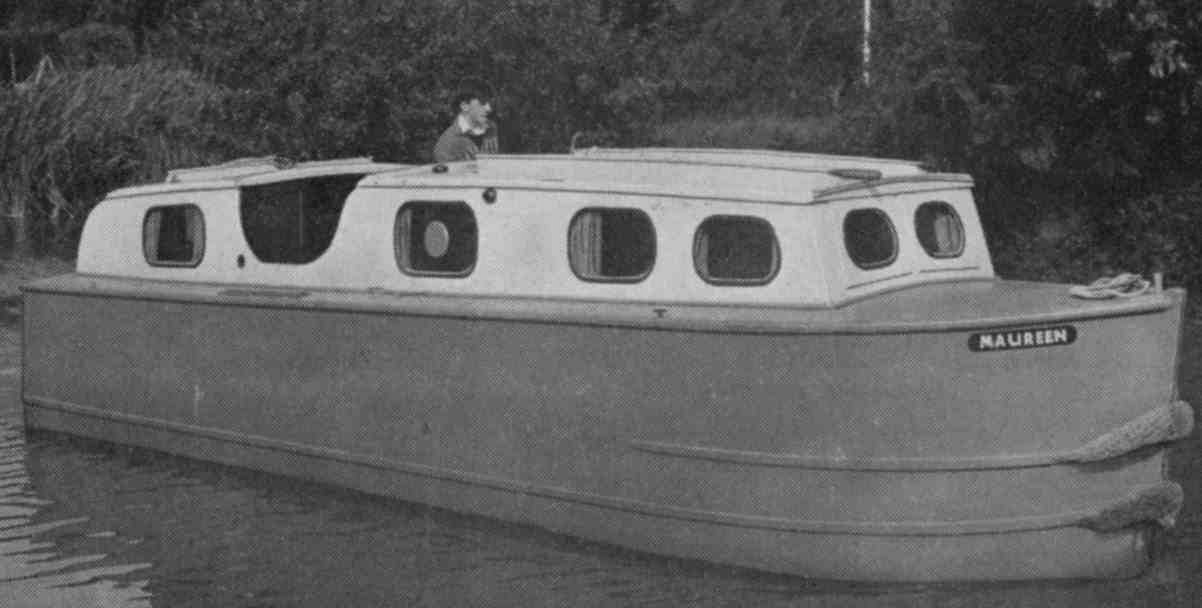
"Maureen" exceeded our expectations in 1964 and 1965
(Photograph - Dean's Pleasure Boats)
The weather was good and we were enjoying our holiday until we reached Whixhall Moss on the Llangollen Canal. The boat started to be quite sluggish and appeared to be sitting a little lower in the water than normal. After lifting the cockpit floorboards we discovered the problem. The engine was almost completely submerged with canal water. We looked for somewhere to beach the boat but sod’s law dictates that when you want to find somewhere shallow, you are more than likely to be on a stretch of canal that has been recently been dredged. That was exactly the position we were now in. We pulled the boat in to the bank just after Morris’s Lift Bridge (number 45). I was busy on the bilge pump whilst Father walked a little way along the canal with the boat hook, plumbing the depth in order to find a shallower section. When somewhere suitable had been found, we pulled the boat there and beached her.
Jim went to the nearby scrap yard to telephone Deans. In the meantime, we all took turns on the pump and just managed to keep the water level at bay. Before long, Stan Clegg, Dean’s engineer, arrived in his Triumph Courier van (based on the Triumph Herald Estate but without the rear seats and windows). Coincidentally, Sid Dean was cruising along the Llangollen Canal in his boat, “Falling Sands”, named after the lock on the Staffordshire and Worcestershire Canal near Kinver. He was taking the boat from its mooring at Nantwich to his caravan at Ellesmere, a route that took him past where we were sinking. After mooring his boat behind “Maureen” he rolled his sleeves up and got “stuck-in” helping Stan whilst his wife made us all cups of tea and sandwiches.
Stan and Sid removed the engine and lifted it on the towpath. With the engine out, the cause of the leak was revealed. This turned out to be a patch on the hull that was allowing water to seep past it. The patch had been recently applied but had not “taken” properly and started to pass water. After a few hours work, a new patch sealed with copious quantities of bitumen was fitted, the Stuart Turner retrieved from the towpath and returned to its proper place beneath the cockpit floor.
Sid Dean and his wife left leaving Stan to tie-up the loose ends. When his boss was out of the way, Stan then admitted that the patch had been fitted just before we arrived to pick-up the boat. When the engine was being replaced, some petrol started to siphon out of the fuel tank, hence the smell that we noticed when we took the boat over.
After another hour or so, we were on our way again having experienced the only drama on the holiday. Even now, forty-odd years later, I always smile when watching the cine film of the incident, (which I have now recorded onto DVD) especially the shots of me labouring away at the bilge pump. The sight of Sid Dean and Stan Clegg doing some work instead of drinking tea or ice cream sodas, which was usually what they usually did when we met them whilst on the canal, brings smile to my face as well.
Despite the problems we had encountered during the holiday, the “Maureen” was a good, comfortable boat. On our return to the base at Christleton, Sid Dean apologised for the sinking at Whixhall Moss and offered Father another reduction on the next year’s hire fees. He accepted and booked the “Maureen” for the following year.
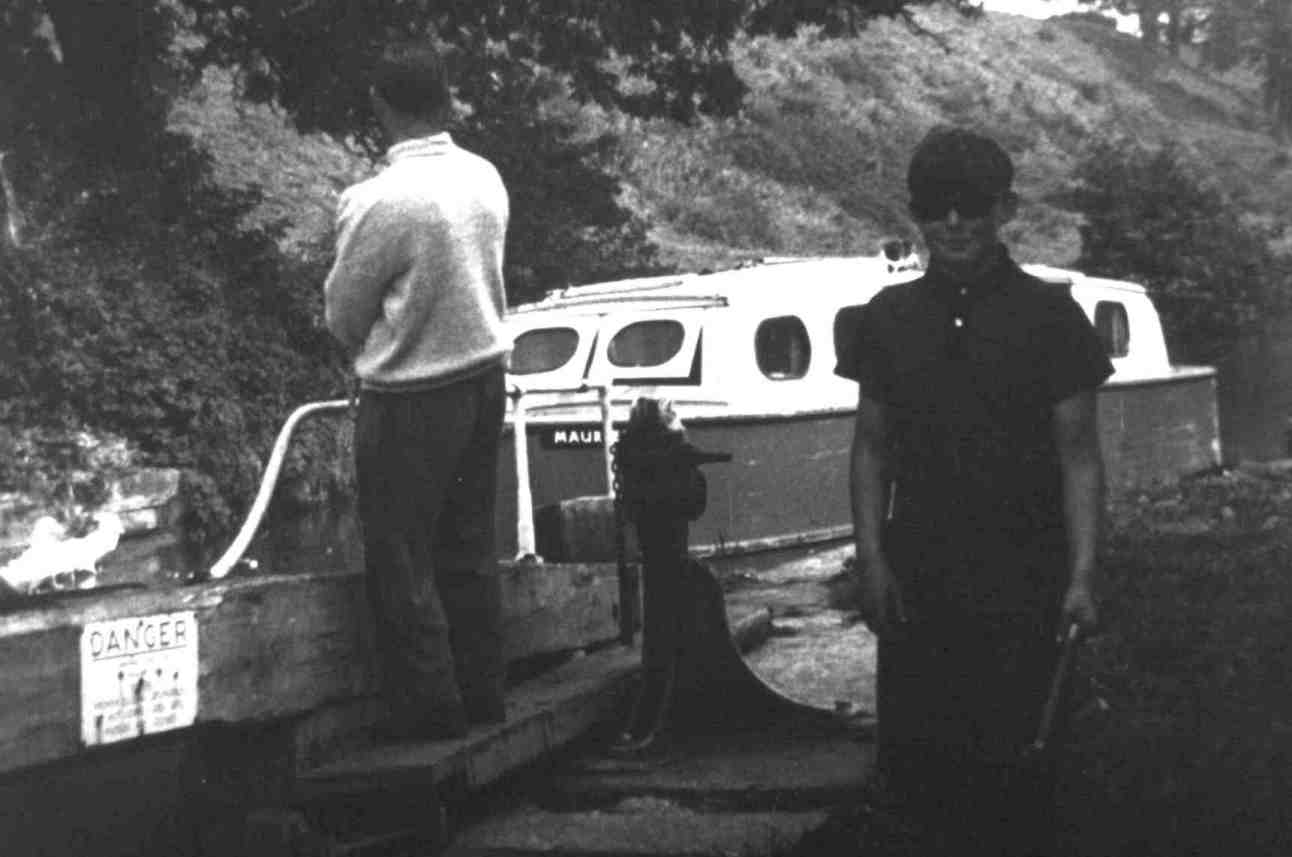
Father pulling the "Maureen" into Tilston Lock - 1964... check out my cool shades!
(Photograph - James M Wood)
The intervening year dragged as it usually did, but we were soon cruising along our beloved Shropshire Union and Llangollen Canals again. The holiday was as enjoyable as ever but, thankfully, not as eventful as the previous year. One thing that we had noticed was the absence of commercial narrow boats. No doubt their demise was accelerated by the “big freeze” of 1963 when man were frozen in the ice when they could have been completing deliveries, the greater number of lorries on the roads and pre-Beeching railway euphoria. Whatever the cause, the loss of the traditional narrow boats was extremely sad and I feel very privileged to have witnessed their presence in previous years. Their way of life is recorded in museums such as The Boat Museum at Ellesmere Port where many ex-working boats have been preserved for prosperity. Working boatmen are also immortalised in the films “Painted Boats”... an Ealing Comedy/Romance and “The Bargee” starring Harry H Corbett of “Steptoe and Son” fame both of which are available on video and DVD.
Prior to the 1965 holiday, we had been discussing the possibility of buying our own boat. Consequently, during the holiday, we were on the look-out for any boats for sale and whilst we visited every boatyard that we passed and kept a look out for “for sale” signs when passing moorings. There weren’t many boats for sale at that time except for the “Jean”... a retired hire boat from “Holidays Afloat” at Market Drayton (Chapter 6 - Canal Cruiser Diversity). Not only was the unusual appearance off-putting but its poor condition precluded it from being pursued further. On inspection this centre cockpit wooden cruiser was suffering from rotten timbers amongst other things and didn’t meet with Father’s approval.
With so many ex-working narrowboats for sale at the time, I am sure that Father toyed with the idea of buying one and converting it into a boat tailor-made for our own needs. The deep draft of these boats may have put him off as well as the lack of somewhere local to do the conversion work. I wonder how the future would have been changed had he put a plan of this type into action.
Bearing the boat hunting project in mind, we didn’t book a boat from Dean’s for 1966, hoping that we would have our own boat by the following year. The story of our boat hunting activities is documented in the next chapter of the saga.
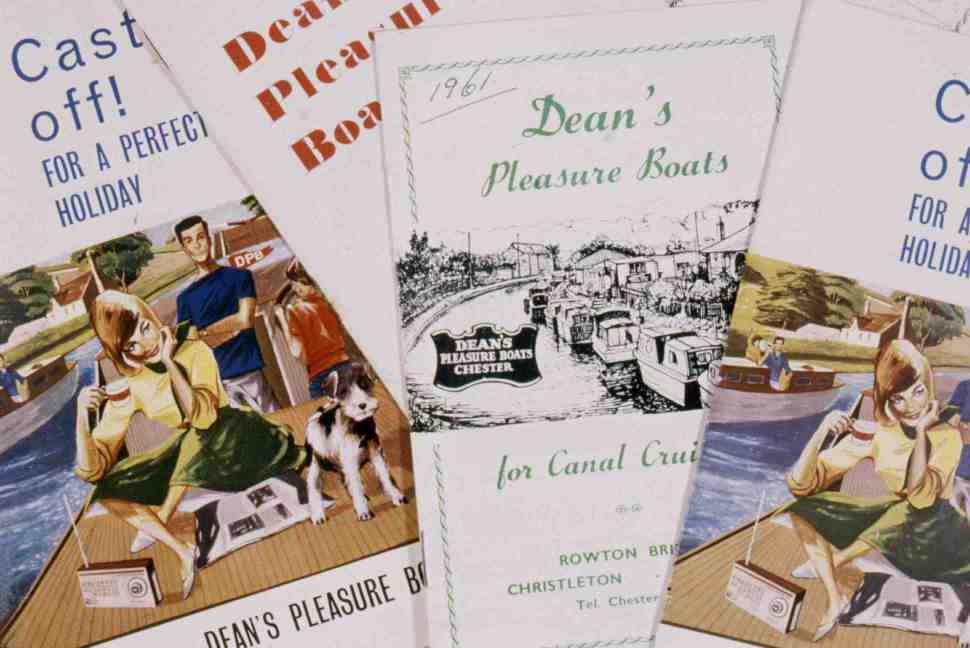
A selection of Dean's Pleasure Boats brochures from the early 1960's
During the autumn and winter of 1965, and spring of 1966, we continued our search for a suitable boat. The “Craft for Sale” adverts in the “Liverpool Echo” (Classified Section number 97) and “Motorboat and Yachting” were scoured. Sometimes, if the boat advertised sounded promising , an advertisement would be answered but it was usually a fruitless exercise. In those days we did not have the luxury of magazines such as “Waterways World”, “Canal Boat” and “Canal and Riverboat” so most of our searching was by visiting various locations around the North West of England.
On a Sunday morning, whilst Father was at work, we prepared flasks of hot milky coffee to wash down ham barms which we had packed for lunch and went off in the Ford Pilot pursuing our quest. We drove to the Ladyline boatyard at Market Drayton but they had nothing suitable within our budget. We had soon scoured the entire length of the “Shroppie” during our search. The boatyards at Nantwich, Bunbury, Waverton and Christleton all gave similar results.
We went as far afield as Lydiate on the Leeds and Liverpool Canal where we viewed a glass-fibre “Loftus Bennet” which was deemed ugly and unsuitable, to Agden outside Lymm on the Bridgewater Canal, when, one cold and windy Sunday morning in January we went to see a boat at what I now know to be Hesford’s Boatyard. The boat was a converted lifeboat making it too wide in the beam for the narrow canals (the Bridgewater being a broad canal), had a “Gale” outboard motor fitted that had seen better days and was also dismissed as unsuitable. An advert in the “Liverpool Echo prompted us to go and see another boat a little closer to home. She was called the “Doric” and was moored in Birkenhead’s Morpeth Dock. The “Doric” was timber hulled, required considerable re-planking due to rot, was also wider that six feet ten inches beam and was also quickly dismissed.
One Sunday in March 1966, we visited the boatyard of J. H. Taylor and Co. in Chester whose work we had admired for many years, especially Dean’s “Kathleen” and the varnished mahogany cruisers moored at the N.B.C.Y.C. moorings at Nantwich. Knowing quite well that we would not be able to afford anything that they had to offer, we went anyway just in case they knew of any suitable craft within our price range.
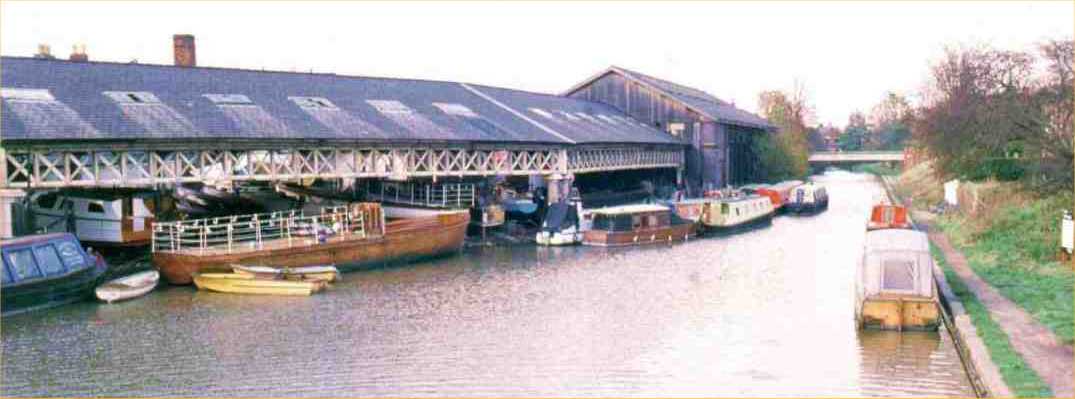
J H Taylor's boatyard in Chester... the home of varnished mahogany
After admiring the craft slipped out for their winter maintenance (“Teal” later called Amaryllis and now at the Ellesmere Port Boat Museum, “Avon”, “Marabeth” and “Quiet Waters”), a trip to the office proved fruitless. Mister Taylor advised us to try next door at Marlin Craft, which we did.
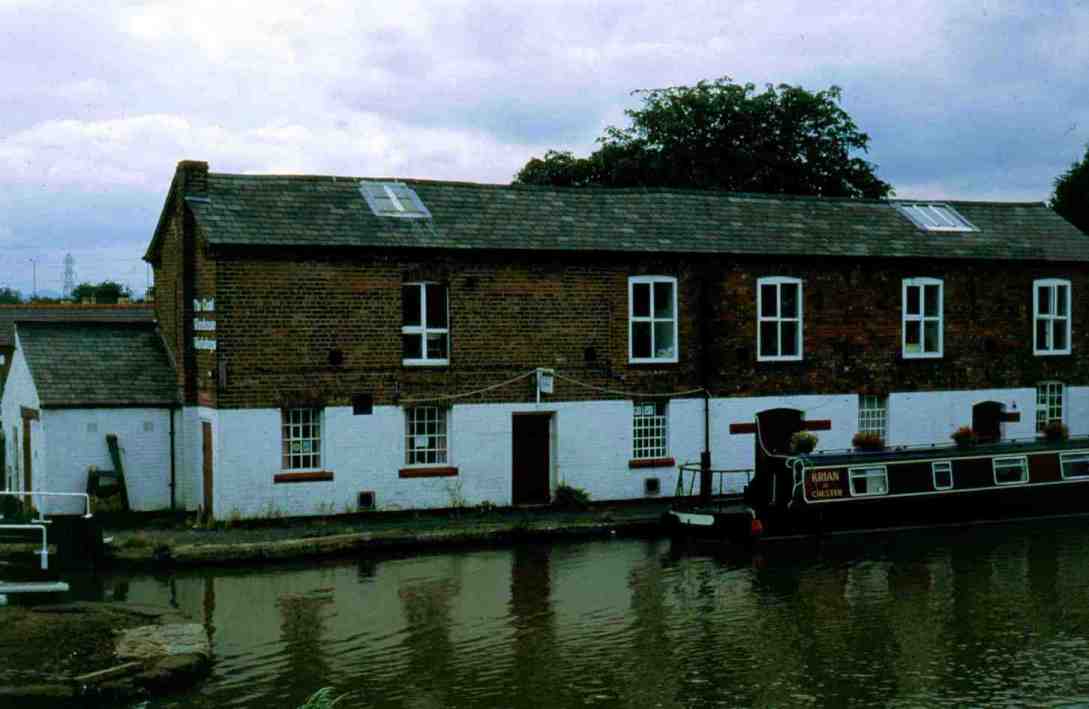
Marlin Craft's workshops next door to J H Taylor's boatyard
Marlin Craft’s workshop was a converted canal horse stable adjacent to the top lock of the Shropshire Union Canal’s River Dee branch. On entering, we were greeted initially by the distinctive smell of fresh glass fibre resin curing. We then saw three craft in various stages of completion. They all shared the same eighteen foot six inch fibreglass hull design with a conventional cabin constructed from three quarter inch marine plywood. The design was very similar to the classic Fairy “Huntress”, “Huntsman” and “Swordfish” off-shore, high-speed cruisers, as used for the boat chase sequences in the James Bond Film “From Russia With Love”, but on a smaller scale and possessing glass fibre hulls instead of timber. Even to my inexperienced eye, the design and craftsmanship was to an extremely high standard.
|
|
|
|
The left hand photograph shows a Fairey "Huntsman" on the Solent off Cowes, Isle of Wight whilst the one on the right shows a Fairy Swordfish being filmed in the James Bond Film "From Russia With Love". It is not evident in this photograph but the two craft in the background are Fairey Swordfishes as well (Right hand photograph - Eon Productions) |

Marlin Craft's trade mark (logo) also has similarities to a Swordfish
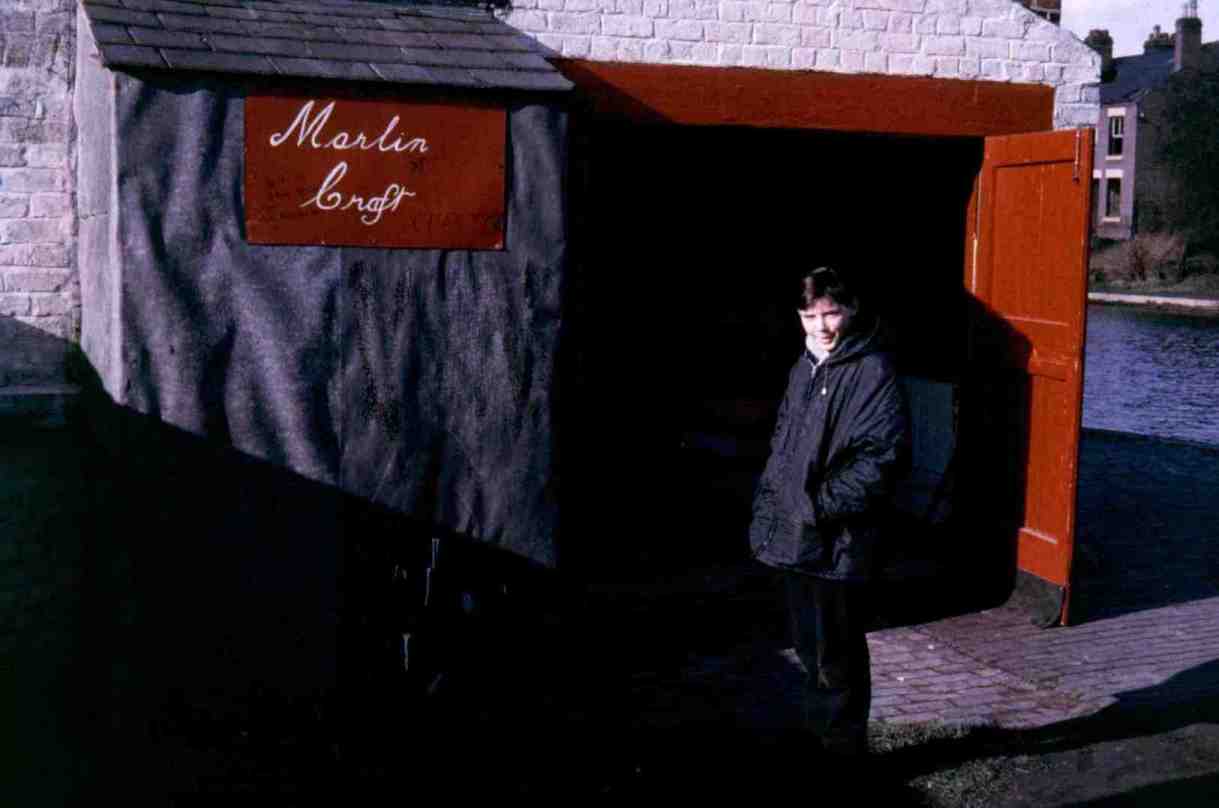
The author outside Marlin Craft's workshop - March 1966
(Photograph - James M Wood)
One of the boat builders, a Mister Jones, introduced himself and showed us around the craft in construction. When we enquired about the beam of the craft, we were told that it was seven feet three inches but could be pulled-in to the six feet ten inches required for narrow canal use by modifying the springing of the gunwales and the superstructure as well as re-profiling the massive “stepped” keel so that the craft had a draft of less than twelve inches (without the engine). The price range was also within the bounds of possibility if ordered with a minimum of extras. Jim enquired if a rear cabin extension could be fitted over the open aft cockpit. Mister Jones assured us that it could. Whatsmore, one of the hulls awaiting completion had been ordered by a gentleman who had just suffered a heart attack and had subsequently cancelled the order. This example could also be modified to our requirements. We arranged another visit one evening in the week when we would return with Father.
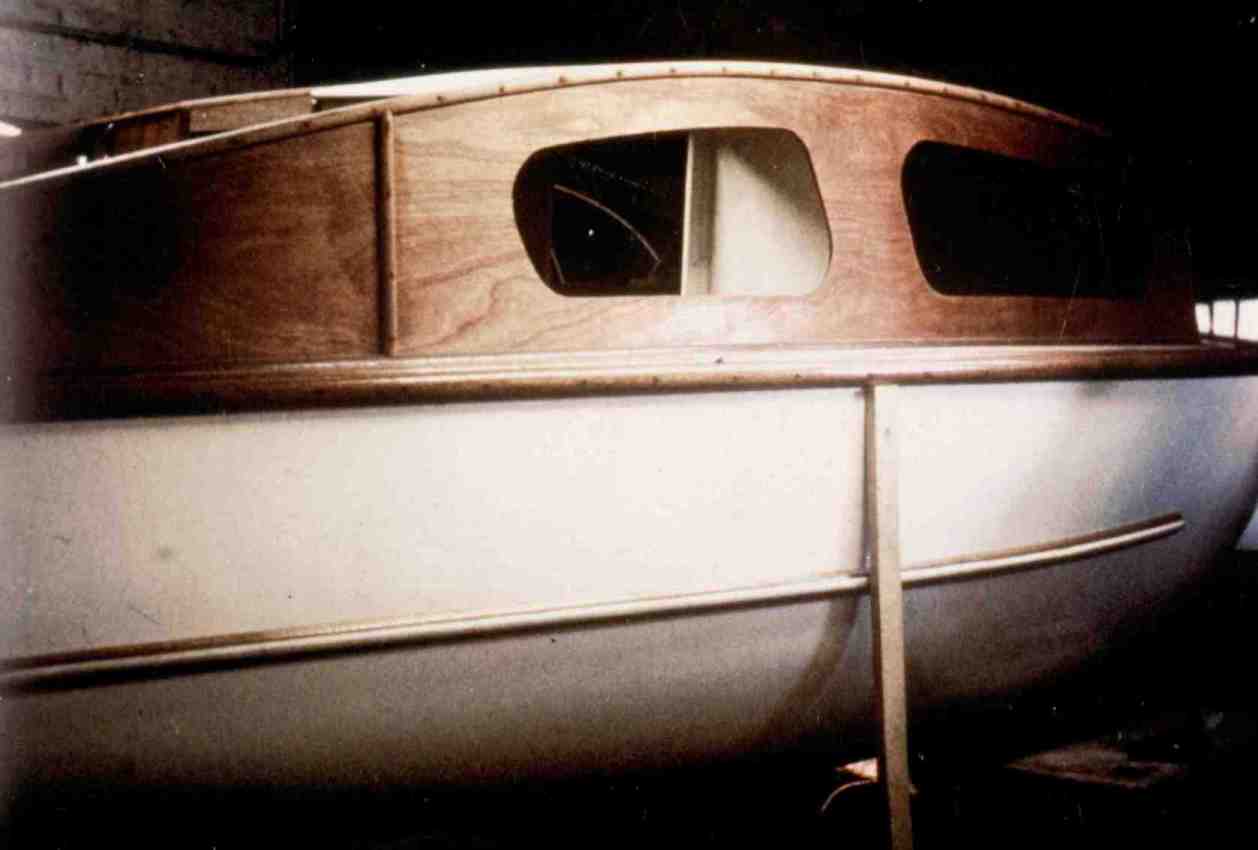
|
Inside Marlin Craft February - 1966 showing the boat that was to |
|
eventually become "Phial" prior to the rear cabin being fitted |
(Photograph - James M Wood)
During the few days before the return visit, Jim and I set to work producing plans for the possible modification to the rear cabin. We also measured the width of “Jack” the dog in order to know that he would be able to walk along the side of the boat. On the following Wednesday evening, we all (including “Jack”) piled into Jim’s Ford V8 Pilot to revisit Marlin Craft. On our arrival at the workshops, we left “Jack” in the car and went inside. After being shown around the workshop, inspecting the craft under construction and scrutinizing the design, standard of workmanship, etc, Father was as equally impressed as the rest of us were. I remember him passing comment on the fact that all the exposed brass wood screws had their heads in a straight line (something that I try to emulate even today). Admittedly a small point, but it gave some idea of the attention to detail that went into the boat’s construction. Father entered into a dialogue with Mister Jones and his partner, Mister Gilbert with regard to ordering one of the craft with suitable modifications. I don’t think that Father was too impressed with the fact that it would be impractical to fit an inboard engine to the boat, and I know that he would have preferred a Stuart Turner installed, but in the interests of space and economy, a compromise had to be made somewhere.
We were relieved and delighted when Father’s chequebook came out and a deposit paid on what was destined to become “our boat”. The boat was ordered as virtually a bare shell with a white hull, cabin roofs and gunwales but with a varnished superstructure just like a “Taylor”. Additional cleats were ordered to be positioned exactly one third of the way back from the bow, to ensure that when she was being pulled by ropes she didn’t veer into the banks but moved at an angle (basic marine engineering theory). A “Bryden Boy” flush into the cut toilet (now outlawed), a sink (made from fibreglass of course), cooker and a “Crescent Marin 18” two stroke, electric start outboard motor were also to be fitted.
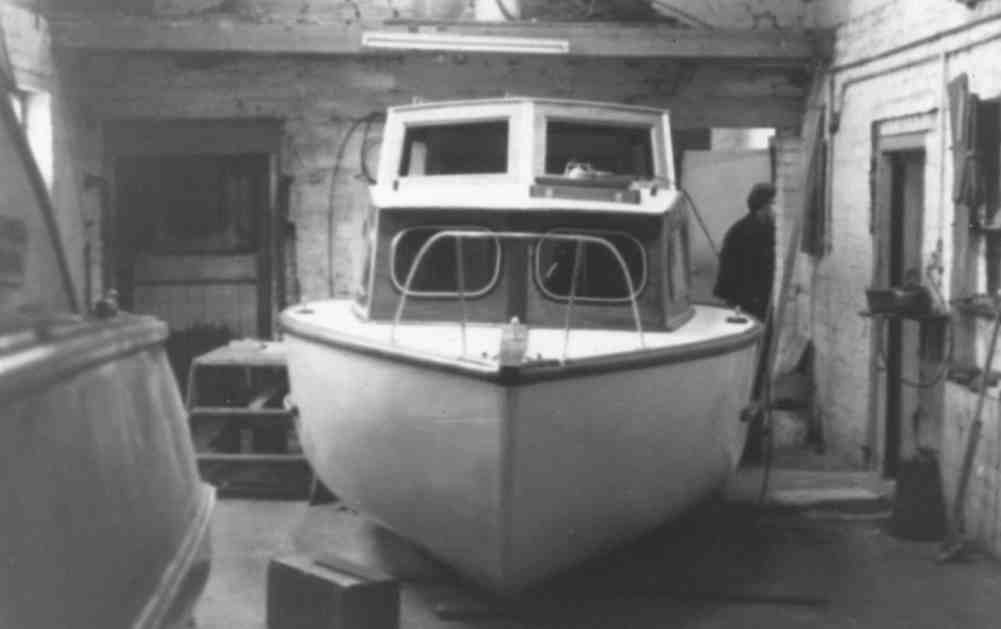
"Phial" under construction showing the rear cabin fitted - March 1966
(Photograph - James M Wood)
On our return home we were all excited at the prospect of our new boat. But, one thing that we had to decide on was a name. In the family discussion that followed, many suggestions were made. As usually happens with these things, one name cropped up time and time again. That name was “Phial”. A phial is a small glass vessel and our new boat was relatively small by canal standards, because it was a boat was classed as a vessel and… its hull at least, was made from glass fibre. Hence the name “Phial” was deemed logical, sounded right and was decided upon.
The proposed completion and launch was to take place on the Saturday after Good Friday. Prior to that day, a mooring had to be found. The nearby canals were scoured and a suitable mooring secured at Beeston Castle Wharf, just off the A49, three miles from Tarporley. Beeston Castle Wharf was the home of Beeston Castle Cruisers and after having a chat with the owner, a Mister Sidney Merral and paying a deposit, the mooring was prepared for us. The following year, Mister Merral promised, we could have a new mooring above Beeston Iron Lock where he was rebuilding a cottage that he planned to live in. Interestingly, the Merrals had connections with Wallasey where we lived. At one time they owned a dairy on Trafalgar Road near to the Co-op but were now living in Capenhurst. They were also in the process of rebuilding "Iron Lock Cottage" adjacent to the nearby Iron Lock.
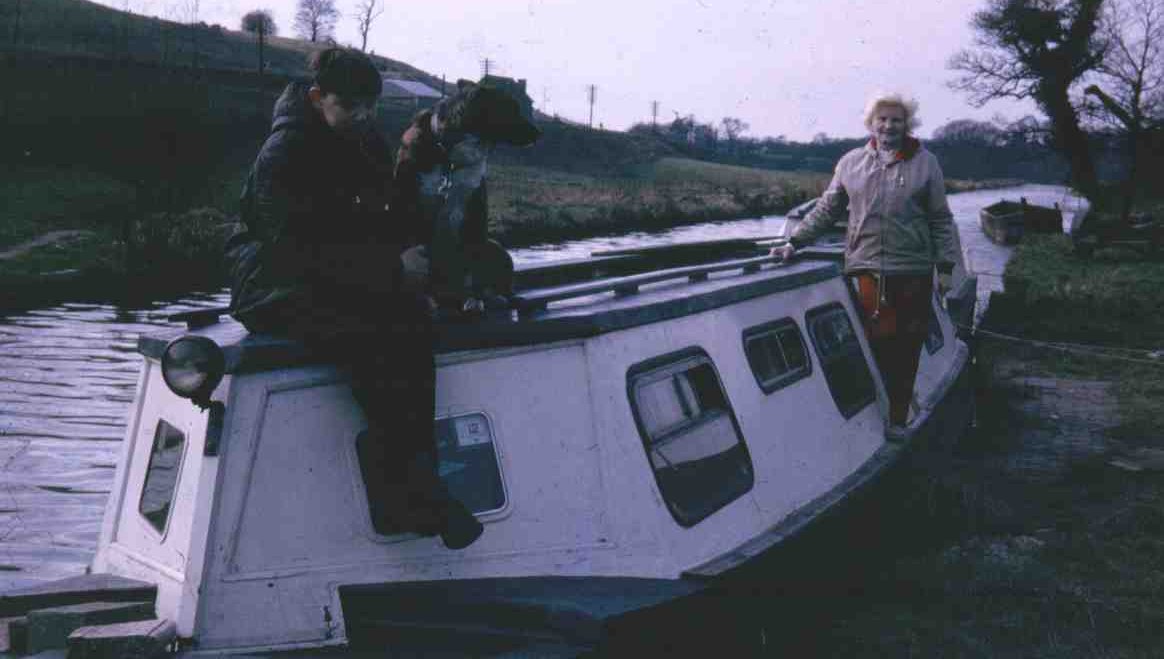
Mother, Jack and I on "Starling" at Beeston Castle Wharf which was to be "Phial's" home
The boat had been registered with B.W.B., the licence obtained and the other preparations like making curtains, bunk cushions and covers, ropes and inventory had been obtained ready to take up to Chester. Some of the inventory consisted of items previously stored in the “Holiday Drawers” in the dresser at home. That is, all except for one item that was too large for the drawers. We lived adjacent to the River Mersey in Wallasey and every morning I religiously walked Jack the dog along the promenade. One morning I came across a wooden boat pole that had been washed-up by the tide. I took the pole home and presented it to Father for when we had a boat of our own. He took the pole to work, cleaned it up, painted it white and had the hook galvanized. After the refurbishment it lay for a couple of years in our large tool shed cum workshop waiting for the day when it would be required. During the period leading up to Easter, we visited Marlin Craft about once a week to see how well work was progressing and to take photographs of every stage of construction.
At last the launch day arrived. On the Thursday before Good Friday, Mother, Father and I left for Chester in an Austin A35 Countryman (PED 663) that Father had bought from an acquaintance of Jim’s. Jim was working and could not join us until the evening. He was also bringing Jack the dog with him as the A35 was packed almost to bursting point.
"Phial" was prepared for launching and eventually wheeled out of the workshop on a four wheeled bogey. A problem arose in that the height of the workshop door was too low and the extended rear cabin's handrails had to be removed in order for the boat to come out into the daylight. Then there was a problem with the bogey and "Phial's" substantial elm keel. In order for her to slip off the bogey smoothly, a notch (that can still be seen to this day) had to be cut into the stonework on the side of the lock. Once this had been done the launch could commence. Lemonade was poured over the boat’s bow just before the launch to christen the boat, and into the water she slipped. The engine was then fitted and the boat builders, Mr. Jones and Mr. Gilbert went around the basin with Father before handing over the boat and receiving the final cheque for payment.
On completion of the formalities, the boat was moored adjacent to Marlin Craft’s workshops and we started to load our belongings aboard, including the boat pole mentioned previously, although I cannot remember it being taken up to Chester. The boat pole was to eventually have a black band added eighteen inches from the hook’s point that indicated the deepest part of “Phial’s” draught (the engine’s skeg), thus simplifying matters when a mooring spot was being sought whilst out on our travels. I have adopted this idea on my own boat but one end indicates the draft at the bow whilst the other end shows the draft to the skeg. This done, the boat was moved around the corner to Tower Wharf (opposite what is now the “Telford’s Warehouse” restaurant) where we waited for Jim and Jack to arrive and had our first cup of tea and a snack on board.
We all slept on board that night and the following day, we took "Phial" to her new home at Beeston. It was a misty Good Friday morning and we took extra care not to mark the gleaming white fiberglass hull on the sides of locks. On the way to Beeston, I remember looking up an entry at the side of the lock-keeper’s cottage at, I think, Chemistry Lock on the outskirts of Chester, and seeing lines and lines of steam locomotives in the railway yard behind the cottage waiting to go to Barry Island in Wales to be cut-up for scrap. I have always had an interest in railways since I was a small child and this was a poignant sight that has remained in my memory for nearly fifty years. I recently returned to this location on foot and was not surprised to see that the railway yard had been replaced by a housing estate although the railway line was still present.
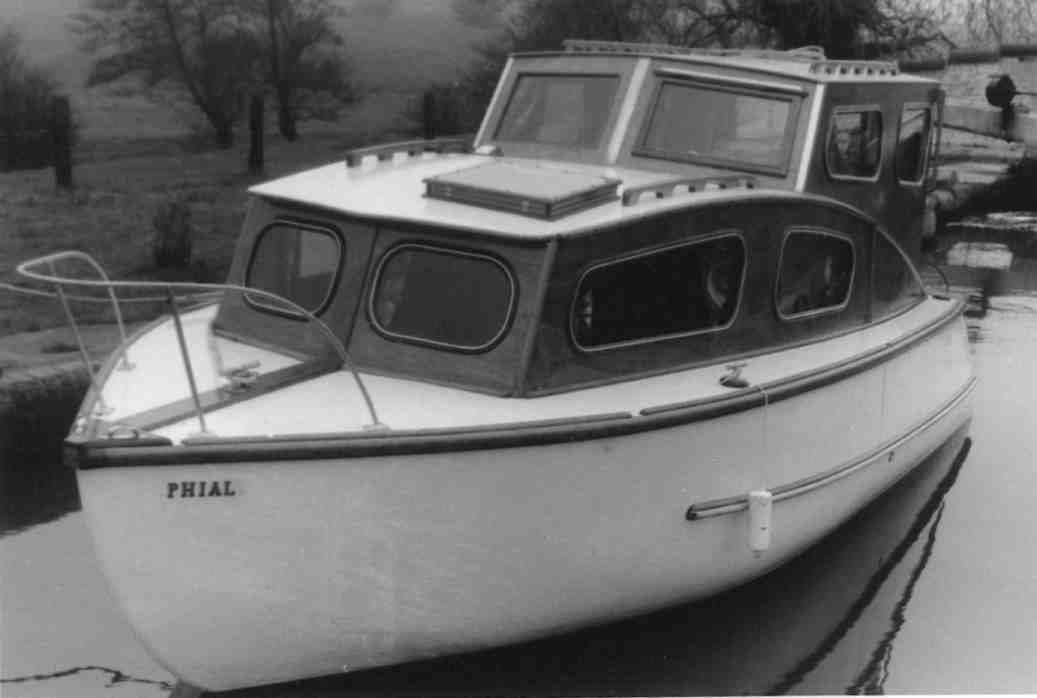
|
"Phial" on her maiden voyage in Wharton Lock |
|
on the Shropshire Union Canal, Easter 1966 |
(Photograph - James M Wood)
On the way through Christleton we stopped at Dean’s boatyard to show off our new boat to our old friends at the hire boat base. We were later to hear from Stan Clegg that Sid Dean was not very pleased and had said… “If I’d known that they had that kind of money I’d have sold them the bloody “Kathleen”! We reminded Sid that we had called in a few times to see if they had any boats for sale but we were told that they hadn’t. Maybe it was just sour grapes on his part! After the visit to Dean’s, we carried on to Beeston where “Phial” was to be moored for the next twenty-six years.
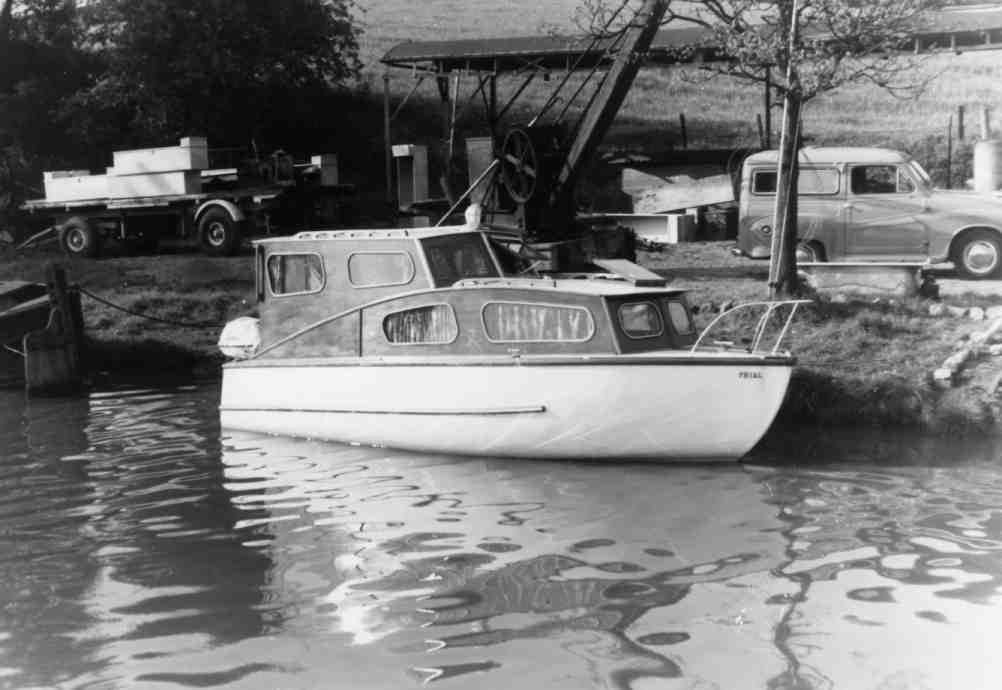
A brand new "Phial" at the Beeston mooring after her maiden voyage - April 1966
(Photograph - James M Wood)
After a few weeks, the varnish on the cabin sides was showing signs of distress and fading, so a return trip to Marlin Craft at Chester was made at Whit. I remember the trip down to Chester well. I also remember Father’s reluctance to leave the boat there whilst the remedial work was completed but Mr. Gilbert assured him that the boat would be moored in Taylor's Boatyard (adjacent) and that nobody would be able to reach it without their permission.
The first few months after launching were spent adding essential equipment such as headlight, horn, water tank, etc. Two extra ventilators were required, one for the toilet compartment and the other for the cupboard beneath the sink that housed the two Calor Gas bottles (no Boat Safety Certificate then!). Marlin Craft couldn’t supply them as the manufacturers had gone out of business and we searched all of the Shropshire Union Canal’s boatyards to find them, before finally obtaining a pair from a boatyard near to Aldersley junction on the Staffordshire and Worcestershire Canal at Wolverhampton. On Poulton Road in Wallasey was a boat shop called Wallasey Small Boat Services (opposite a Chinese fish and chip shop - "No fishycake!") that just happened to be Crescent Marin main dealers. Father ordered a spare propeller from them as well as a few other bits and pieces and we visited the shop regularly for odds and ends.
On reaching Marlin Craft, we left "Phial" with Messrs Jones and Gilbert for a week whilst revarnishing was undertaken, arranging to collect her and return her to Beeston the following weekend. This was the only problem that was encountered with the workmanship of the boat, and even this was put down to the varnish manufacturers… "Cerofex", who later went into liquidation. Their assets must have dried up better than their polyurethane yacht varnish! The cabin sides were rubbed down and “International” yacht varnish applied. The new varnish was a traditional Linseed Oil based (non-polyurethane) type manufactured by International Paints and was so successful that the same type was applied every Easter when Father took a week off work to prepare “Phial” for the start of the boating season.
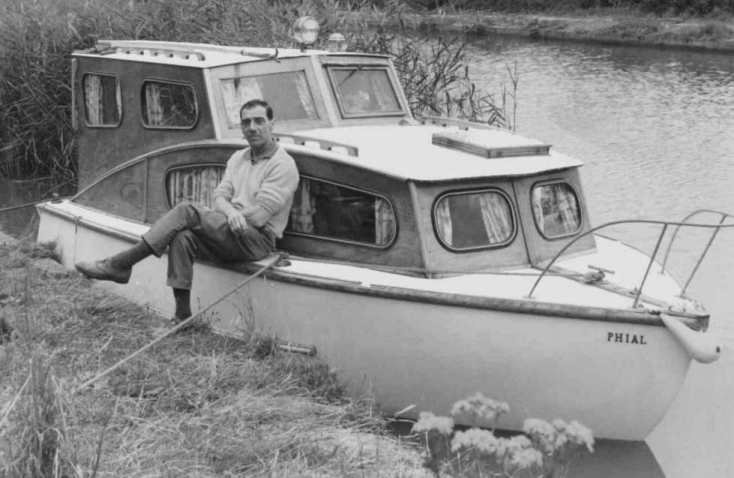
Father and his beloved "Phial" above Bunbury Locks in 1967
(Photograph - James M Wood)
It was shortly after this that I accompanied Jim to our first IWA National Rally. This was at Whalley Bridge and I can still remember seeing Doctor Michael Wynstanley MP... the popular Member of Parliament and later Lord Wynstanley aboard a cruiser viewing the craft that had assembled for the rally.
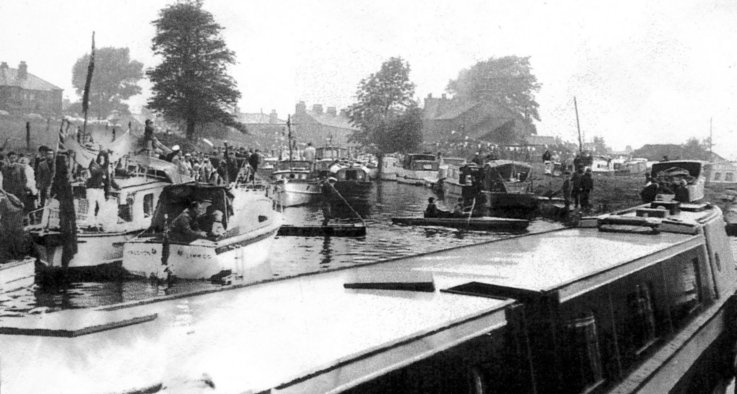
The 1966 IWA National Rally at Whalley Bridge
Preparations were now well under way for our first holiday on “Phial”. It was decided not to go too far the first year but to use the holiday as a “shake down” cruise to identify any problems or modifications that needed to be made before going further afield. I also suspected that finances were tight after Father used all of his savings plus obtained a bank loan for the purchase of the boat and the Austin A35.
We set sail for the Llangollen Canal, eager to see how the boat fitted in the notoriously narrow Hurleston bottom lock (remember Chris?) at the beginning of the canal. Needless to say, she fitted beautifully with no tight spots anywhere along the lock chamber. We continued along the canal to Grindley Brook where, after negotiating the three single and one triple staircase locks (also notoriously narrow), we met Stan Clegg. Stan had been attending a breakdown at one of their boats and was glad of a drink of American Cream Soda laced with ice cream (bought from the Post Office-cum-shop adjacent to the staircase lock). It was on this occasion that we learnt of Sid Dean’s annoyance at our buying a boat of our own. After saying farewell to Stan we carried on along the canal, stopping at Ellesmere, Welsh Frankton and Chirk.
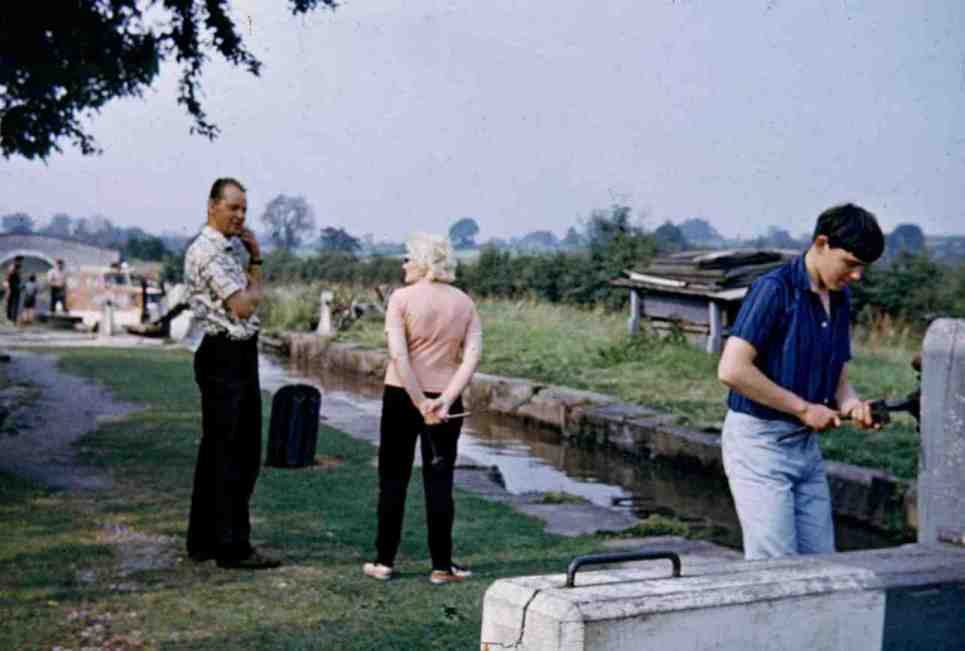
| Mother chatting at New Marton Locks on the |
| Llangollen Canal whilst I am left to do the work! |
(Photograph - James M Wood)
Whilst moored at Welsh Frankton, we saw another Marlin. Well, at least a boat with a Marlin hull. The boat was called “Pegasus III” (see Chapter 7 - Beeston Days) and belonged to a school teacher from Macclesfield who had bought the hull from Marlin Craft and fitted his own superstructure. It had a centre cockpit configuration that looked quite cramped and was fitted with the new Crescent Nine outboard motor. Father commented that the Crescent Nine would have been better suited to our needs than the Eighteen, but with hindsight, the Nine would not have had sufficient power for some of the waterways that we were to cruise in the future. After taking photographs and comparing notes, the other Marlin departed to carry on up the canal. We decided not to continue further upstream than Chirk and turned around in the basin before the tunnel and headed back to Hurleston Junction.
This trip was well documented with Jim’s cine camera and in one shot Father turned “Phial” around in the basin between Chirk Aqueduct and tunnel. As the boat turned to face the camera, the sunlight shone on the varnished superstructure and gleaming white hull. A sight that made us very proud of our new boat.
We returned to the “Shroppie” and ventured into new territory along the Middlewich Branch to the Trent and Mersey Canal. I remember Father not being too impressed by the oil in the Trent and Mersey at Middlewich making “Phial’s” brilliant white hull filthy. We moored above King’s Lock and had a look around the town before returning to the cleaner waters of the “Shroppie”. On the way back we called at Ladyline Cruisers base at Barbridge Junction (formally Deans) where Father bought a few bits (additional cleats, etc) and I purchased the latest editions of the British Waterways Board’s Canal Cruising Guides (which I still possess). Little did I know that forty seven years later I would buy a narrowboat from this location (see Canalscape Book 9 - Chapter 3). We then spent a few days at Hack Green to reflect upon our first cruise, plan any modifications to the boat and I read my new books from cover to cover.
One problem that came to light on our “shake down” cruise was the narrowness of the rear deck. Father made a metal bracket that ran the width of the transom, which supported two platforms to extend the rear deck by six inches. The extension made quite a difference to getting on and off the boat in addition to offering added protection to the hull. A transom guard was also constructed (complete with a captive wing-nut to allow opening for access to the lower section of the outboard motor’s leg when tilted) to protect the outboard in addition to additional cabin lighting and extra shelving plus two “M” shaped supports for the boat hook on the rear cabin roof.
The engine did not escape scrutiny either. To prevent the sparking plugs oiling up, “hotter” ones were fitted. To help with the extra demand on the batteries, Father spent hours rewound the alternator coils to give an extra couple of amps charging current in addition to the pitiful half an amp of the standard coils. An innovative addition was two coils of fine copper wire wound around the ignition h.t. leads. The current that they induced was fed to two neon lights mounted on the engine’s lower casing. When the spark plugs were firing, they illuminated, when one of them was not firing, one of the lights did not illuminate. So, identifying, not only an ignition fault but also the cylinder concerned.
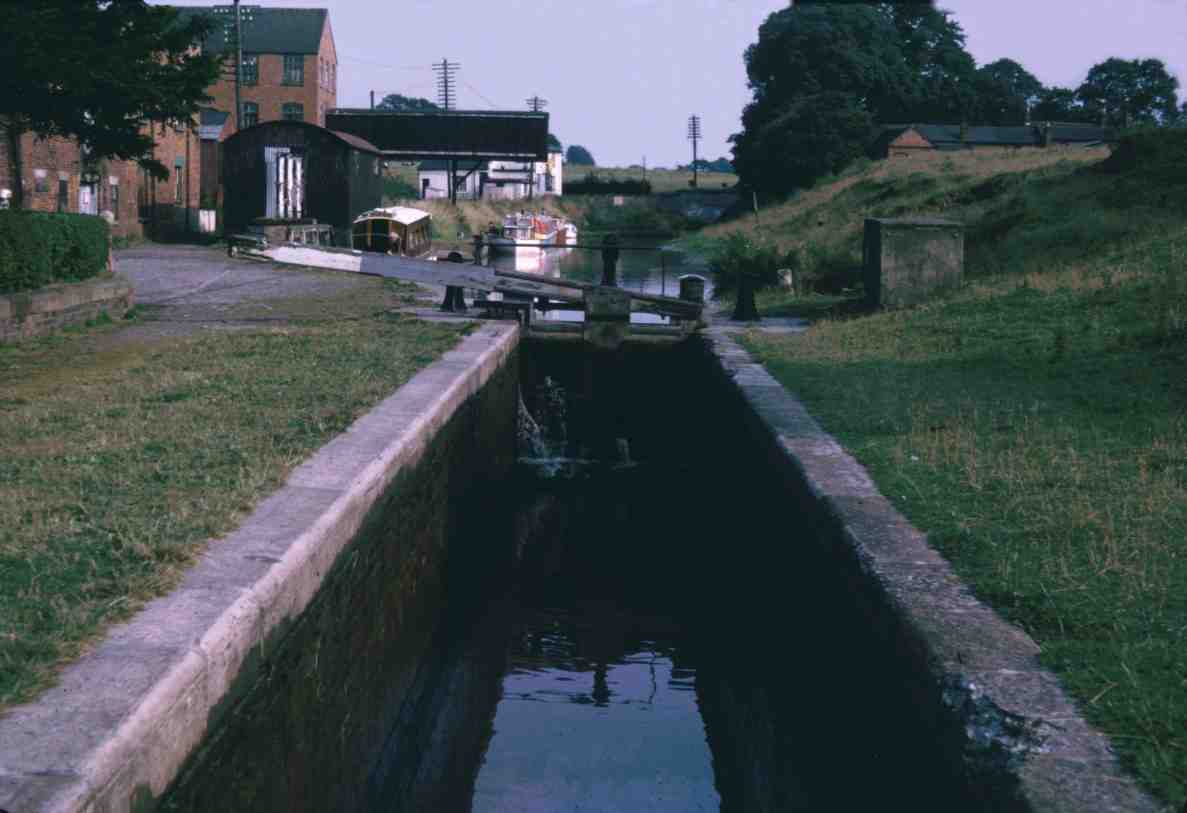
Audlem in 1967. "Phial" can just be seen moored in the distance
(Photograph - James M Wood)
Even though a spare propeller had been purchased, Father was not happy with its performance and decided to make one himself (he was a Marine Engineer after all). He computed the blade pitch, diameter, etc. and gave the new prop had a finer pitch, which allowed the engine to rev a little higher. This in turn, helped to prevent spark plug fowling and gave additional current for battery charging. He was more satisfied with his own creation and it remained in use as the main propeller, the new one from Wallasey Small Boat Services being sold and the original supplied with the engine used as a spare.
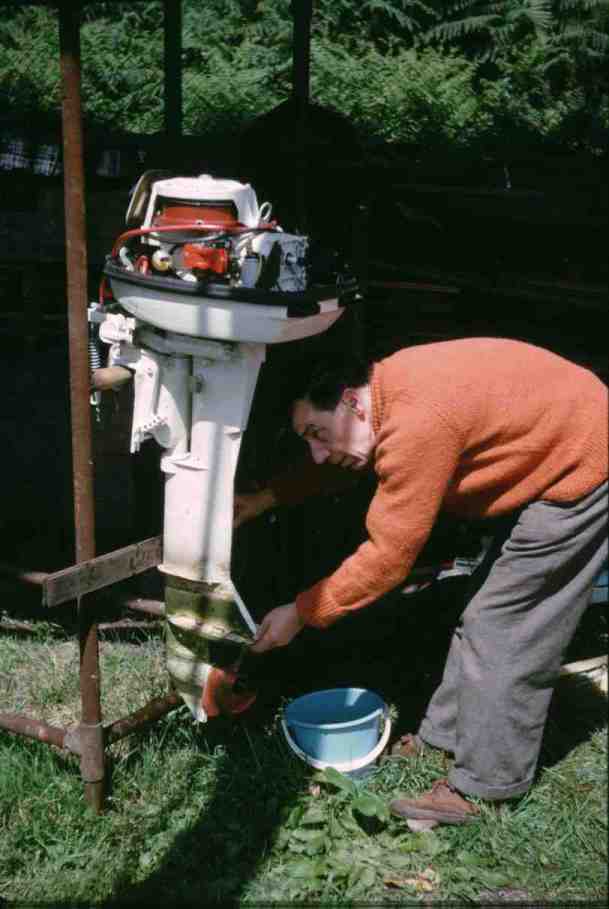
| Father servicing and changing the gearbox oil and |
| cleaning the Crescent Marin 18 outboard motor |
(Photograph - James M Wood)
When the engine was not in gear and the boat was drifting, there was no steerage. We experimented with various sizes of rudder bolted to the outboard before settling on a Kort Nozzle of Father’s own unique design. This was a square aluminium box through which the thrust from the propeller passed. It gave twice the rudder area compared to a conventional rudder and did not reduce efficiency due to the thrust from the propeller being “clean” and not being split by a rudder. A conventional Kort Nozzle is usually circular in design but to aid steering and ease of construction, “Phial’s” was a square box-like design.
Another problem was “cavitation”. This is where the propeller sucks air from the surface of the water in front of it and lowers efficiency, especially evident in shallow water and reverse. Even though the engine was a long-shaft model, it suffered from this problem and the propeller sucking in air from the whirlpools created could be heard distinctly in the form of a “slurping” sound. In addition to lowering the engine’s mounting, Father made a large anti-cavitation plate that fitted between the Kort Nozzle and the outboard’s body, facing forwards. It made a considerable improvement to performance, especially in reverse. The only problem was when a shear pin broke or the propeller was fouled by fishing line, weeds or other miscellaneous rubbish that managed to wrap around it, one of us had to get in to the canal to remove it as the engine would not tip fully due to the steering assembly and the inaccessibility problems caused by the Kort Nozzle and the anti-cavitation plate.
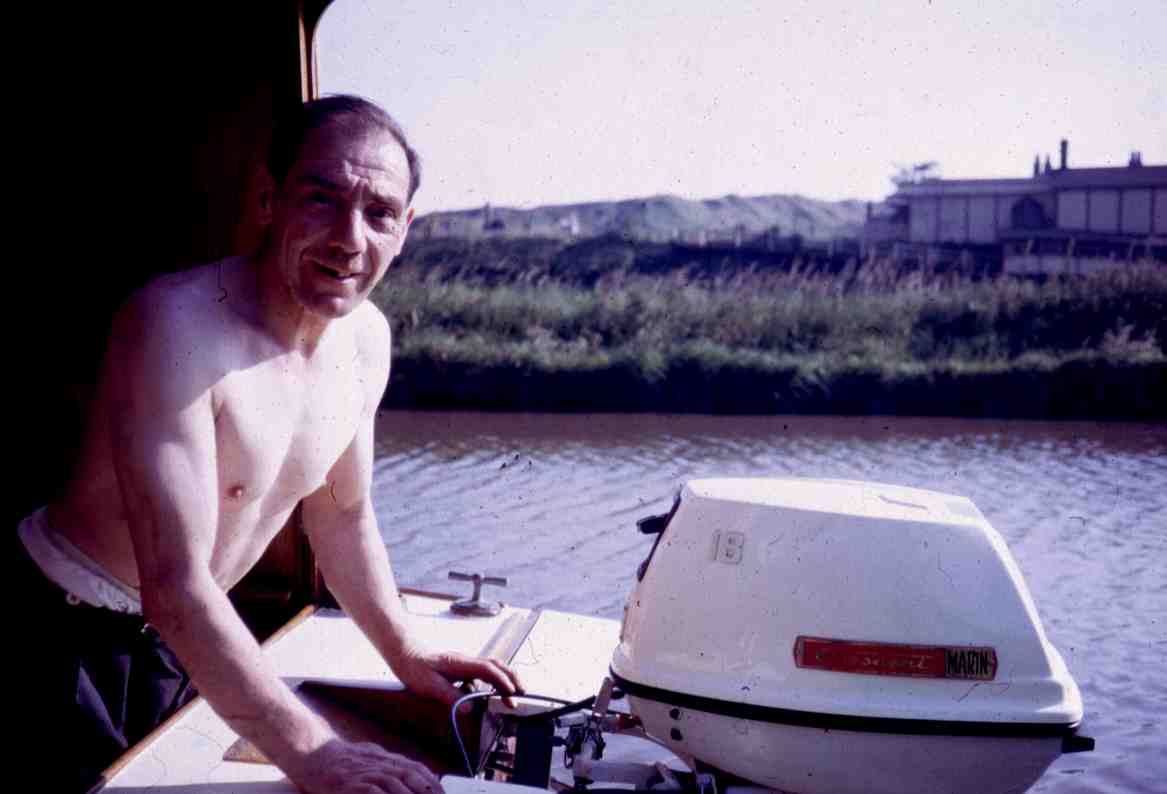
|
Father in 1968 on "Phial's" rear deck with Beeston Castle and |
|
Tarporley Railway Station (now demolished) in the background |
At the beginning of October, “Phial” was prepared for her first winter. A green tarpaulin cover was obtained from a wagon driver friend of Father’s (later replaced by a cover custom-made to the shape of the boat which even had a “lump” for the headlamp and horn) and was held in place by numerous pieces of thin rope (clothes line) passed beneath the hull. I can remember spending many long and cold hours with one of us standing on the landing stage and the other hanging on to the handrails precariously. We pulled the wet ropes from bow to stern using a seesaw movement until the desired position was reached. It was a lot easier to remove in the spring. The ropes were untied and the whole cover pulled off and folded ready for the next winter. “
Phial’s” mooring was unusual in that she was secured by four ropes. In addition to the conventional bow and stern ropes, a “fore spring” and “aft spring” were used. The “fore-spring” went from the bow towards the stern and had a sprung shock absorber spliced into it to minimize the movement created by passing craft. The “aft-spring” went from the stern towards the bow and was continuous. Looking from above, the mooring ropes looked like an “X” with two lines connecting the upper and lower arms of the “X” on either side. They were tied (using “Clove-Hitches” of course) to heavy mooring stakes one meter in length.
Father constructed a stand out of tubular steel for storing the outboard motor when not mounted on the boat. This normally resided in the locked shed adjacent to our mooring. Before the motor was fitted, the engine was cleaned, serviced and the gearbox oil changed in addition to touching-up any paintwork that had been chipped or damaged.
Once all the problems had been identified on “Phial’s” shake-down cruise and dealt with, she was safely winterized and we could make plans for our 1967 holiday. Our planned route was to take us along the “Shroppie” to Autherley Junction where we were to turn right onto the Staffordshire and Worcestershire Canal and continue on to Stourport on Severn. This was to be the first of our long-distance cruises with many more to equally exciting waterway adventures to follow. Jim was not able to join us for the outward part of the holiday but Tom Merral gave him a lift in his white and black Ford Anglia Super (with a short excursion to photograph a scrap-yard full of Austin Champ 4x4 ex-army vehicles near Prees Heath) to Stourport where he was to join us.
The Staffordshire and Worcestershire Canal was new territory to us. Apart from a short excursion from Autherley Junction to Tettenhall Bridge when we collected Jim in 1960 we had not cruised this canal. When cruising a canal for the first time there are features that seem almost alien. The canal “furniture”, the way that bridges are constructed, the appearance of the lock gates and twin paddle gear on the top gates, to name but a few. These are the kind of things (along with the surroundings) that give each canal its character and individuality. Compton Lock was different from locks that we were used to. The footbridge at the tail of the lock did not possess any provision for the towpath (but some of the bridges do have apertures allowing access to boats) and this could be problematic when ropes were being used; hence some locks have arches or wings allowing the rope to pass through the gap between them (such as the ones at Kidderminster and Falling Sands Locks). James Brindley’s original overflow weirs on this canal are unusual in that some of them are circular in shape and the overflowing water passes down a circular hole in the centre of the weir, down a pipe to the tail of the lock where it empties into the pound below. Unfortunately, there are not too many examples left but what must be the prototype is still in existence (not to by-pass a lock but as an overflow weir) on Brindley’s first canal… the Bridgewater Canal and can be seen on the towpath side of the canal when approaching Hulme on the outskirts of Manchester City Centre.
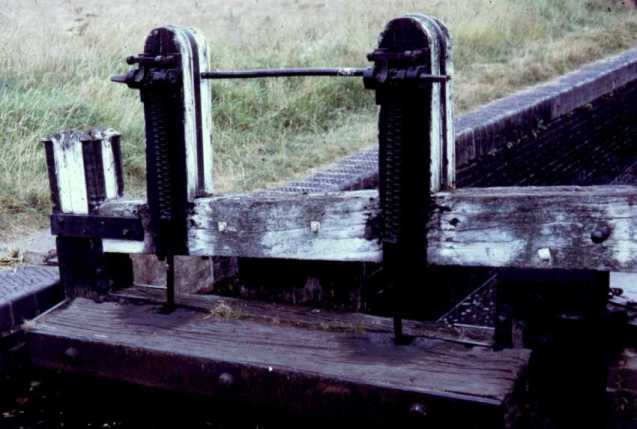
An example of the unusual Staffordshire and Worcestershire Canal lock paddle gear
When we arrived at Bratch Locks they came as a complete surprise. The octagonal toll house is unusual enough but the chambers are something else. We were used to staircase locks but Bratch are a hybrid of a conventional flight of locks and a three-step staircase lock. Originally constructed as a three-step staircase or “riser” it proved to be not very efficient with regards water usage. To alleviate this problem the “riser” was rebuilt as a conventional flight of locks. Instead of relocating the lower chambers, short intervening pounds between the locks were added so that the chambers lead almost immediately into the next and are separated by about two metres. The water supply for each chamber comes from side-ponds… a non-navigable pound that runs alongside the locks’ chambers and used in the conventional manner. The only difference between this flight and a conventional flight is the fact that a boat cannot start up the flight if there is already one coming down due to there being, as previously mentioned, no intervening pounds between the chambers.
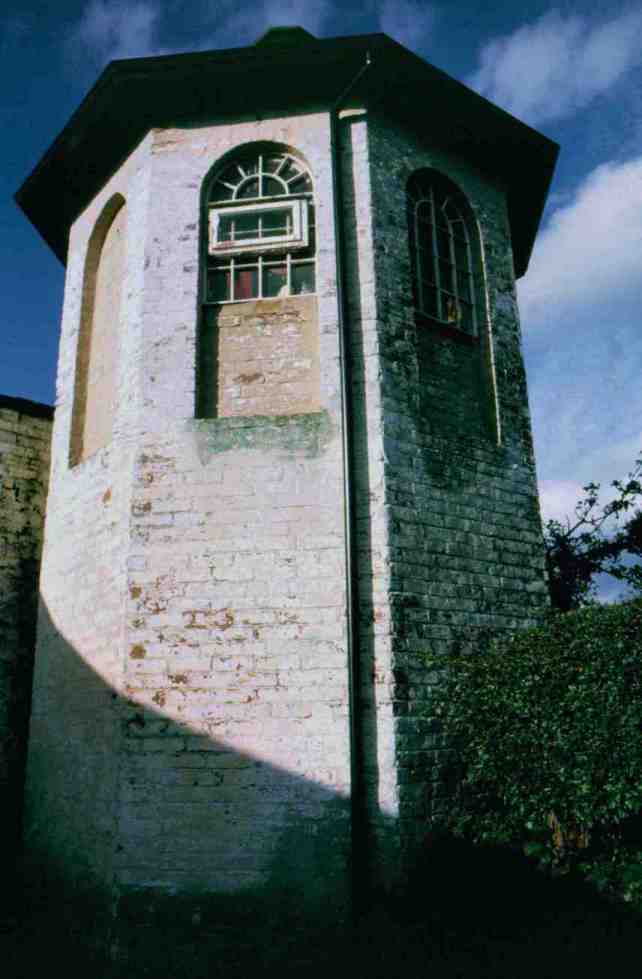
The octagonal toll house at Bratch Locks before restoration
There is also a wonderful water pumping station situated at Bratch (nothing to do with the canal I might add) which houses two large triple expansion steam engines used for pumping fresh drinking water. They are named “Victoria” and “Alexandra”, completed in 1896. Each engine was capable of raising 1 million gallons in 24 hours from the 150 foot deep well. In 1960 the engines were taken out of use, but between 1991 and 1996 the building was refurbished and "Victoria" was restored to working order. Fred Dibnah visited the pumping station during his “Made in Britain” television series when he enthused about the engines and the restoration that Len Crane… the station’s resident engineer has accomplished over the years.
We had a brief stop at Stourton Junction to have a look at and photograph the disused Stourbridge Canal and the Stourton flight of locks. The locks were in a poor state of repair and the restoration taking place further up the canal had not reached these locks yet. It would be quite a few years before this restoration was to take place but if the locks are viewed today they are a tribute to the dedication of the volunteers from the Waterways Recovery Group led by Graham Palmer that secured the canal’s place in the cruising routes available today.
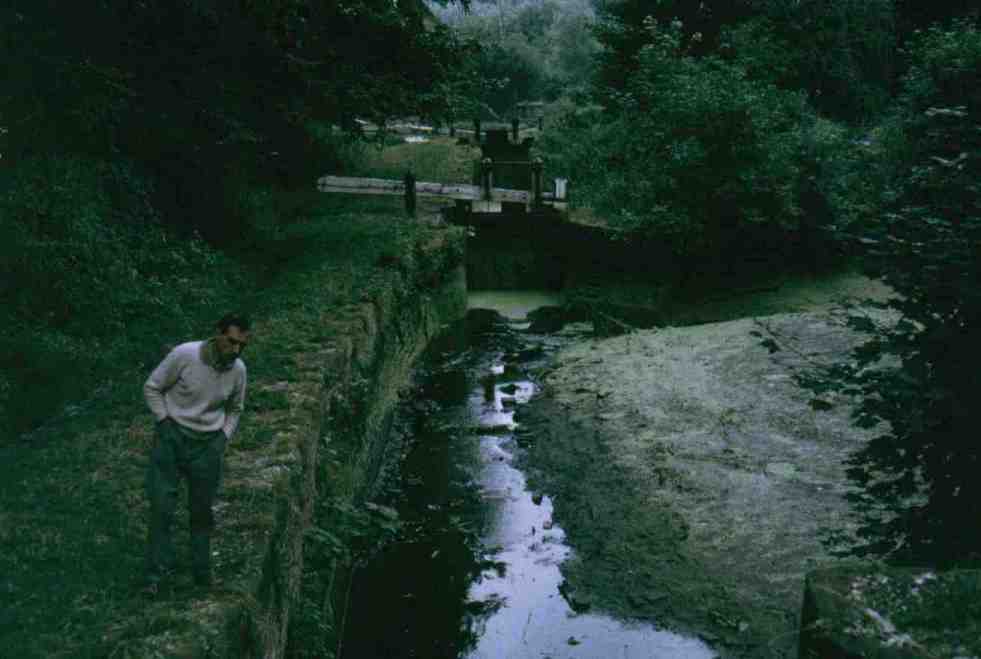
Father inspecting the drained Stourton Locks
The impressively named Falling Sands Lock is the lock that inspired Sid Dean to christen his boat after. The location of this lock is partially in a cutting hewn out of the solid rock outcrop through which the canal passes. Shortly after this is the disused connection with the River Stour. This gave access to the Wilden Iron Works which received its raw materials by narrowboat and the finished products were similarly conveyed to their destination. There are several sharp turns on the river which lead to some ingenious solutions to navigating seventy foot boats which did not possess engines by the use of pulleys and ropes secured to posts located on the river bank.
It did not take long for us to reach Stourport and once through York Street Lock we passes through the large basins until we found a mooring outside the Clock Warehouses (now the home of Stourport Boat Club). I looked after the boat whilst Mother and Father went into the town for provisions and looked around the basins and locks of England’s first canal town.
The next day we were due to have Jim join us and, as the weather and river conditions were fine, we decided to venture onto the river. We passed through the barge locks (the narrow staircase locks were not in use at this time) onto the River Severn and cruised down as far as Lincombe Lock. Once on the river we had the opportunity to open the engine up fully in deep water to see just how fast she could go. Father estimated that we touched over ten mph going downstream and about eight when returning upstream. Needless to say we made sure that there were no witnesses to our speeding as we were producing a considerable wash, especially when returning upstream. After our trial run on the River Severn we returned to the safety of Stourport Basins, collected Jim and started our return journey along the Staffs and Worcs. At York Street Lock was a craft shop that sold miniature “Buckby” Cans and Jim bought one but not before it had the boat’s name painted onto it. On the way down the “Shroppie” we had a little more time than on our outward journey so we paused at some of our usual haunts… Brewood, Gnosall, Market Drayton. Here we moored at the Ladyline Marina and had a good look around their excellent chandlery and book department. Needless to say I bought a couple more of the British Waterways Board’s canal guides to add to my collection.
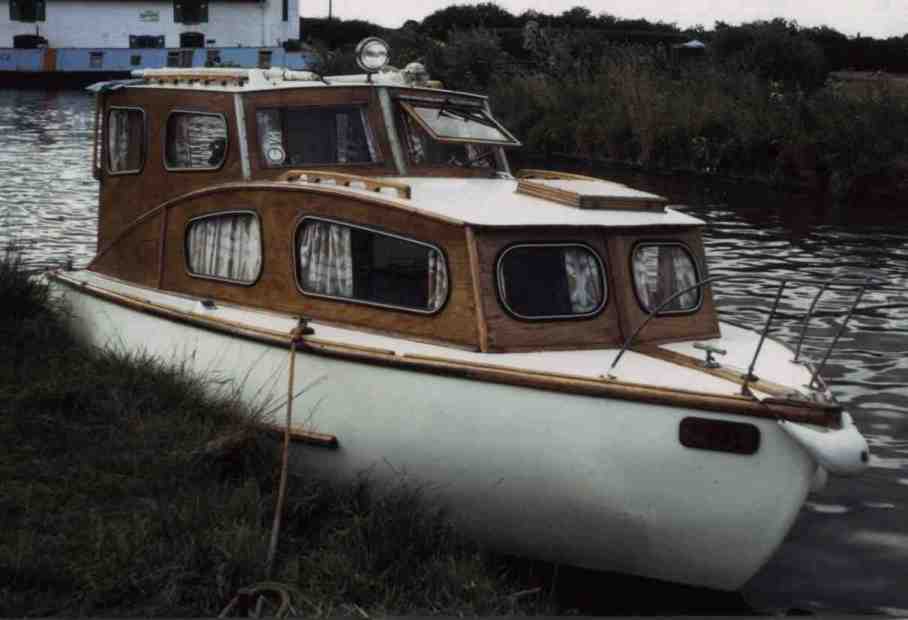
|
"Phial" moored below Audlem in 1968 |
|
(Note narrowboat "Prince" moored in the background) |
All too soon we were back at Beeston and we tied up at our mooring above the Iron Lock loaded the cars and returned home eager to see the photographs and ciné film of our exploits. This was the first time that I had taken a serious interest in still photography and had a Rank Mamiya Ranger camera. I was pleased with the results when I projected the transparencies (slides) after they were processed and still possess them today although the camera was part exchanged for a Russian Zenith “B” SLR with a separate light meter.
For our 1968 holiday Jim was not able to join us for any of the time that we were away. This year we also journeyed down to Stourport but once on the River Severn we planned to venture as far as Worcester. On approaching the first lock… Lincombe Lock, we sounded the horn and waited at the landing stage at the head of the lock for the giant gates to open and the “traffic lights” to turn from red to green. We had considered waiting in mid-stream but the close proximity of the cut leading to the overflow weir and the possibility of commercial traffic coming upstream out of the lock persuaded us to head for the landing stage. It was a good job that we did as a large coastal barge carrying coal to Stourport Power Station came out of the lock when the gates opened. Fortunately, it wasn’t going very fast and was not pulling much of a wash. Even so, the turbulence it created was considerable and we were glad when the lights turned to green and we could proceed into the lock.
Even though we had been through the barge locks from Stourport Basins onto the river, the locks actually on the river seemed absolutely massive. We hung onto chains dangling down the sides of the lock chamber whilst the lock keeper raised the paddles and let the water out of the lock. It didn’t take long to empty and we were soon passing out of the chamber into the next section of the river below it.
The next lock… Holt Fleet Lock was negotiated in a similar fashion but we had to wait a considerable amount of time at Bevere Lock due to more commercial traffic on the way up the river. Whilst we waited Father and I took the dog for a walk and had a quick look around the lock at the same time. I mentioned earlier that Father was a marine engineer by trade. On the river bank at above the lock was some old Bailey Bridges. Father had worked on the design of these floating bridges during the Second World War and showed me the clasps which were used to attach the individual units together, that he had designed and patented. After taking photographs we returned to the boat just as the barge was coming out of the lock. We untied the ropes and negotiated the lock in much the same way as the previous ones.
This was the last lock that we were to negotiate before reaching Worcester but not far from the lock is a beautiful Thomas Telford cast iron bridge spanning the river. It is interesting to not that this bridge was constructed in 1828… the same year as Beeston Iron Lock. When we reached Worcester we moored on the long floating jetty that extended from just past the race course to the approach to the main bridge in the centre of the city. We didn’t moor here overnight and after looking around the city and buying supplies we cast off and headed downstream to see the Cathedral where we turned around and headed back upstream.
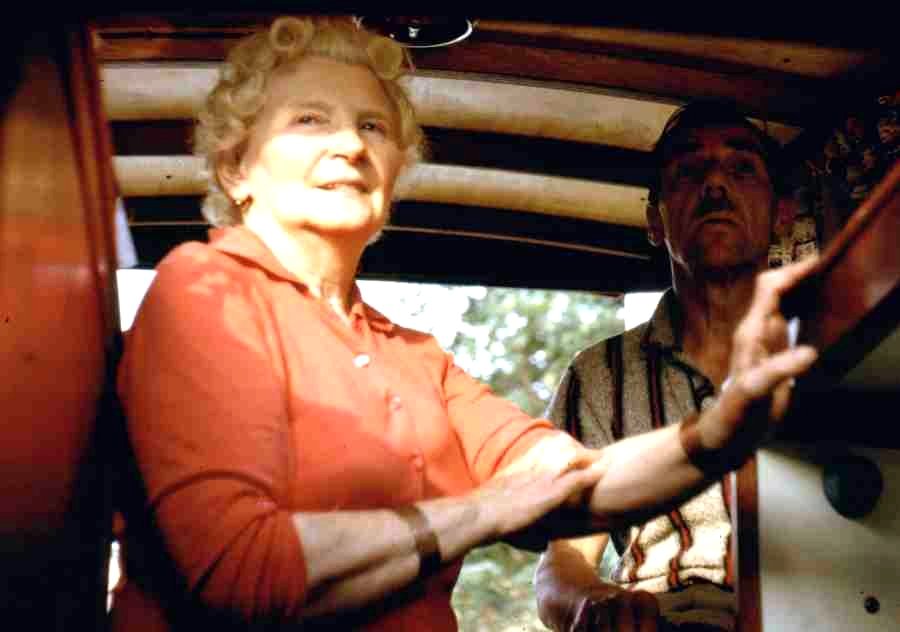
Mother and Father inside "Phial" whilst under way
One problem that we had on the river concerned mooring. When it was time to moor-up at night, quite often we would find ourselves miles from anywhere and, on one occasion, we found a suitably sheltered "bay" surrounded by trees. The grappling hook was thrown around one of the trees and secured to the bow rope. For the stern, Once the outboard had been tilted to avoid damage, one of us had to get into the river and paddle to the banks in order to tie the stern rope around the trunk of a suitably substantial tree. The problems didn’t end there. Jack the dog had to come off the boat for exercise and ablutions. As I was already wet, I picked him up from the boat’s rear deck and carried him to the bank, reversing the process a little later on when it was time for him to return to the boat.
In 1968, there was still quite a lot of commercial traffic on the river and we were alarmed at the wash produced by the coal barges that fed Stourport Power Station and the large coastal craft heavily laden with timber or other cargo. If they were overtaking us we would steer towards their wash and then tuck-in behind them as soon as they had passed to minimize the effect of their wash on our, comparatively speaking, miniscule craft. A similar maneuver would be made if we met them coming towards us. When we were moored and a commercial craft passed, we would check the mooring ropes just in case their passing had loosened them or pulled the mooring stakes out. We retraced our steps upstream, back through Stourport Basins, back along the Staffs and Worcs and “Shroppie” with a day’s “chill out” at Hack Green before returning to Beeston.
For 1969, we decided to cruise to Stratford upon Avon via the Birmingham Canal Navigations, Grand Union and recently restored Southern Stratford on Avon Canals. Jim didn’t accompany us again due to pressure of work so there was just the three of us and Jack the dog. We set off up the “Shroppie” and didn’t hang around as we had a long way to go. We were briefly on the Staffs and Worcs before turning left at Aldersley Junction onto the Birmingham Canal Navigations.
I had turned seventeen the previous Christmas and had passed my driving test soon afterwards. My first car was a 1959 Hillman Minx (624 DKA) and one of the problems that it possessed was a faulty windscreen wiper mechanism. Whilst climbing the “Wolverhampton Twenty One” flight of locks we noticed a scrap yard that contained a Hillman Minx that was the same model as mine. We moored between two of the locks leaving Mother to look after the boat whilst Father and I took a trip to this scrap yard armed with the boat’s tool kit to remove the wiper mechanism. Once at the scrap yard we located the car that we had seen from the canal and removed the mechanism for which we paid the princely sum of one pound. The mechanism was wrapped in a plastic bag and lived on the rear cabin roof for the rest of the trip.
After climbing the 132 feet up the Wolverhampton 21 we entered the labyrinth of canals around this area. The provision of dual towpaths, the width of the waterway and “genuine” traffic islands with direction posts on them impressed us. We cruised for a bit, turning right at Horseley Fields Junction on to the BCN Mainline before passing through Coseley Tunnel admiring its twin towpaths and mooring on the far side of the tunnel for lunch. We carried on the virtually empty canal hardly seeing anything moving. At Factory Junction we cruised straight on and climbed the three Factory Locks onto the Birmingham Level which would take us straight through to Farmer’s Bridge Junction. We passed the branches that lead to the Dudley and Netherton Tunnels on the lower level to right before reaching the Smethwick area. We passed beneath the Stewart Aqueduct which carries Brindley’s Old Main Line across Telford’s New Main Line. The aqueduct in turn is crossed by the M5 which has one of its support legs in the centre of the canal. We then passed through Smethwick Cutting and beneath Thomas Telford’s beautifully proportioned cast iron Galton Bridge.
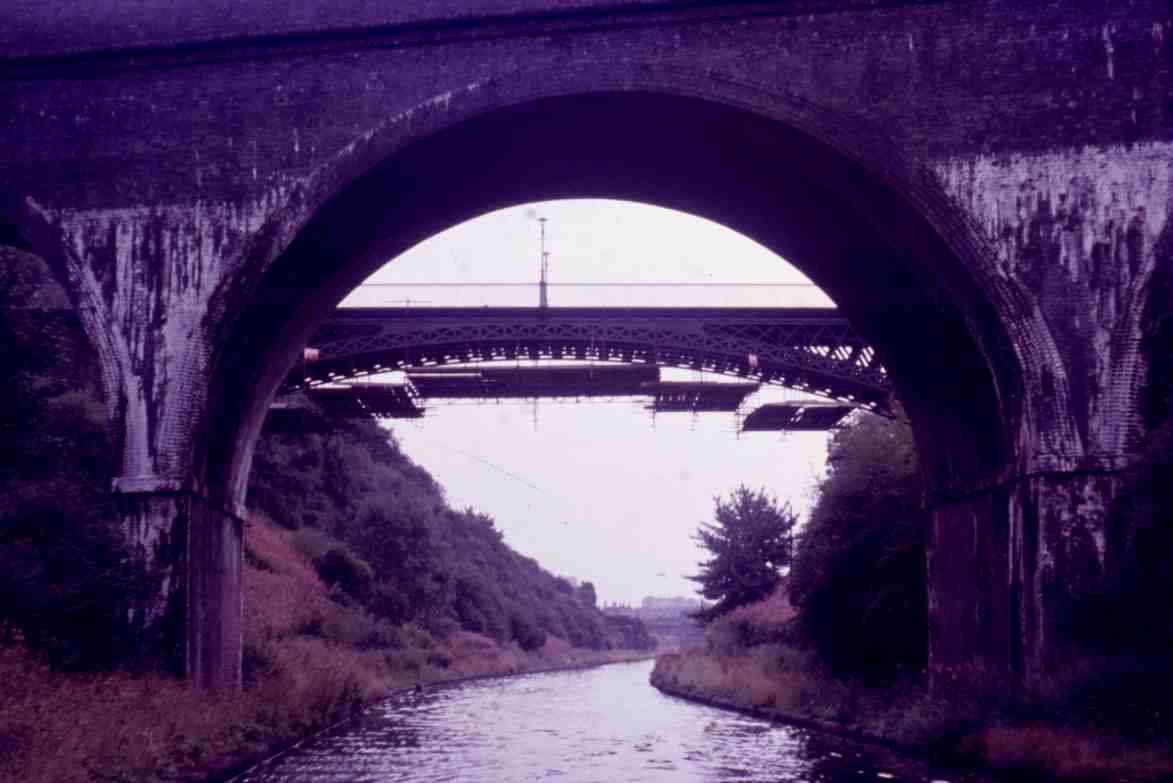
Smethwick Cutting ... Galton Bridge is just visible above the scaffolding
At this time, “Spaghetti Junction” was being constructed and the workman must have cursed us as they lifted temporary roadways out of the way in order for us to pass through what must have been one of the largest building sites in the country. The canal is crossed by hundreds of roads and at Spon Lane Junction it even runs beneath the motorways sharing the same route for a considerable distance. This has its advantages in that when it is raining you do not get wet but at the cost of the road dust and noise that accompanies the motorways.
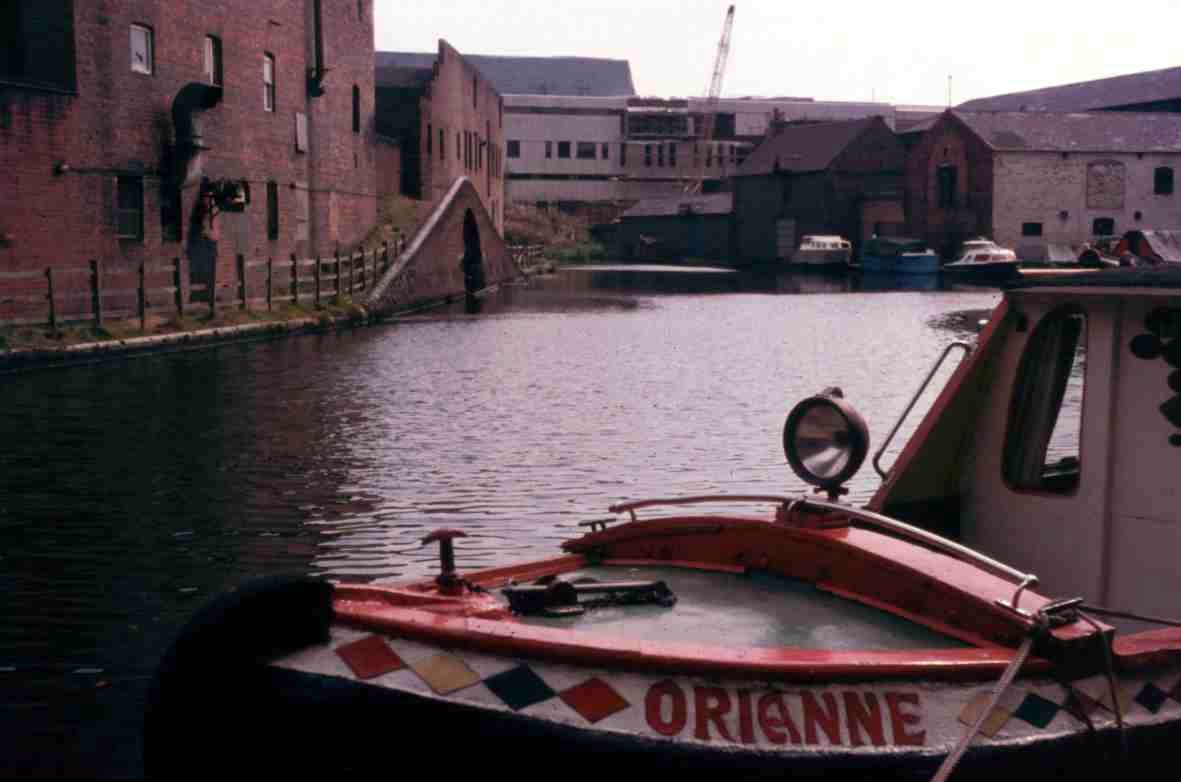
Gas Street Basin in the centre of Birmingham before the developers moved in
We eventually reached Gas Street Basin where we moored for the night adjacent to the Worcester Bar Gauging Point (narrows that resemble a stop lock) and enjoyed a meal from the renowned chippy just around the corner from the “hole in the wall” that gave access to the outside world. We admired the diversity of craft moored in the basin. They ranged from glass-fibre cruisers, wooden cruisers to ex-working narrowboats. Leisure narrowboats were in the minority but there was one converted ex-working narrowboat christened the "Heather Belle" that had been converted into a leisure craft by using a good bit of lateral thinking. The modified top deck of a bus body had been grafted onto the hull where the hold used to be (complete with original windows and yellow/green colour scheme) quite tastefully and successfully. I wouldn’t mind betting that the owner became quite excited when measuring the width of the body prior to fitting to the hull and discovered that they were the same width!
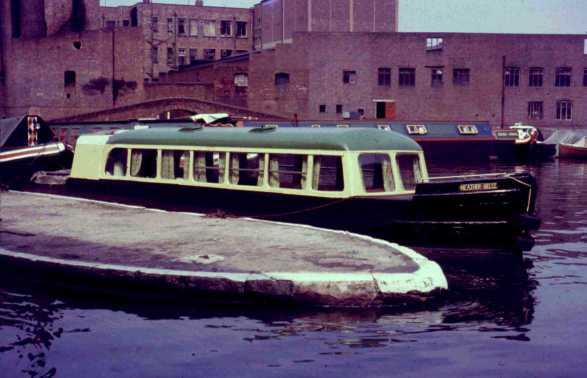
The "Heather Belle" moored in Gas Street Basin
Whilst we were moored at Gas Street Basin Mother and I went into Birmingham City Centre for supplies . On the return trip we nearly got lost in the “Bull Ring” but eventually found the hole in the wall that lead to Gas Street Basin and the secret world that the wall encloses. Whilst we were putting the supplies away, Father went to a nearby garage and bought some petrol which would take us as far as Kings Norton and the start of the Stratford Canal, more of which later.
There was a lot of development work being undertaken at Gas Street Basin and at Farmers Bridge Junction. The town planners had not yet vandalized the Gas Street area completely but at Farmers Bridge Junction there was a development that had transformed the canalside area and boasted a new pub development at Cambrian Wharf that looked out of place in the dereliction that surrounded the development.
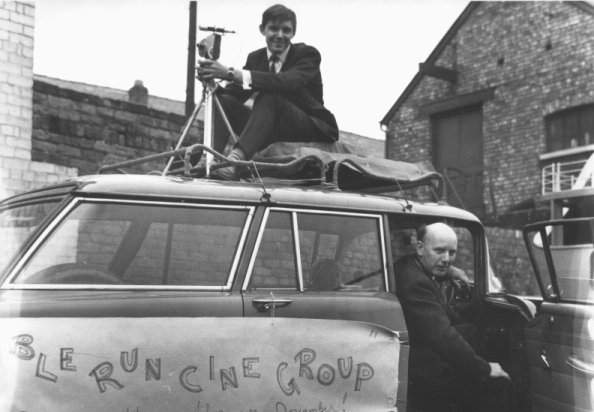
The Author on roof of Eric Knowles' Vauxhall Victor estate car participating in Wallasey's Gala procession
(Photograph - John Lomax, Wallasey's Double-Run Cine Group)
As well as an interest in still photography I had inherited my brother’s interest in ciné photography and was a member of Wallasey's "Double-Run Cine Group (later to be known as "Wirral Movie Makers") which I was secretary of. At the time I had a Bolex H8 ciné camera fitted with Kern lenses as well as a “Delrama” widescreen lens. I was experimenting with capturing sound to accompany the images captured on the H8. For the recording of sound I used a Fi-Cord 202A portable reel to reel tape recorder (which needed fourteen MN1500 (AA size) Duracell batteries) and had recently purchased a Beyer M119 microphone to go with it. Unfortunately, the microphone suffered from excessive wind noise when used outdoors so I made an excursion on foot to a nearby electronics shop where a suitable wind shield made by Grampian was purchased for ten shillings and six pence. The Fi-Cord tape recorder and Beyer microphone were both replaced by more modern equipment (requiring less batteries) many years ago although I still have fond memories of them and was recently given some photographs of myself (with said equipment except that the Bolex H8 was preceded by a Bell and Howell 605c) perched on top of Eric Knowles from the cine club's Vauxhall Victor estate car when Wallasey's Double Run Cine Club had a float in the Wallasey Gala procession. The photographs were taken by my old friend John Lomax who I have known for over forty two years, who sadly, died recently in 2007. On one occasion I accompanied John and Keith Medley (local photographer and Movietone News cinematographer) to Lake Coniston in January 1967. John was making a film entitled "Campbell at Coniston" which documented Donald Campbell's attempt of the World Water Speed Record. We were there on that fateful day when "Bluebird" flipped over and even today, forty years on, when I see footage of the crash it still sends a shiver down my spine and reduces me to tears! John was also responsible for introducing me to the delights of Port Merion... Clough Williams Ellis's' masterpiece of architecture located on the Lleyn Peninsula in North Wales. The eagle eyed amongst readers will notice on the far right hand side of the photograph above the back end of Wallasey's "Royal Iris" promotional bus that was a common sight around the Wirral in the 1960s.
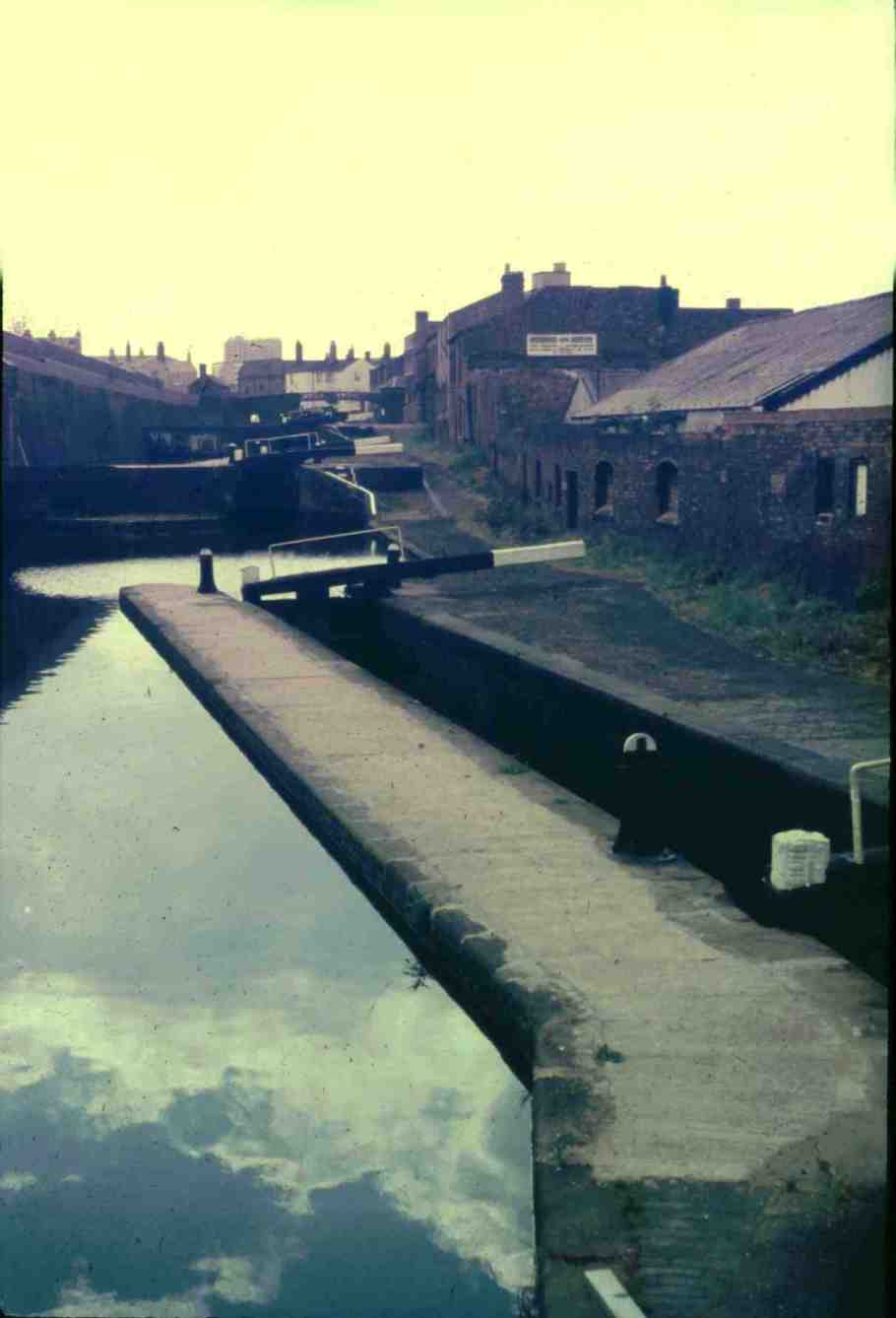
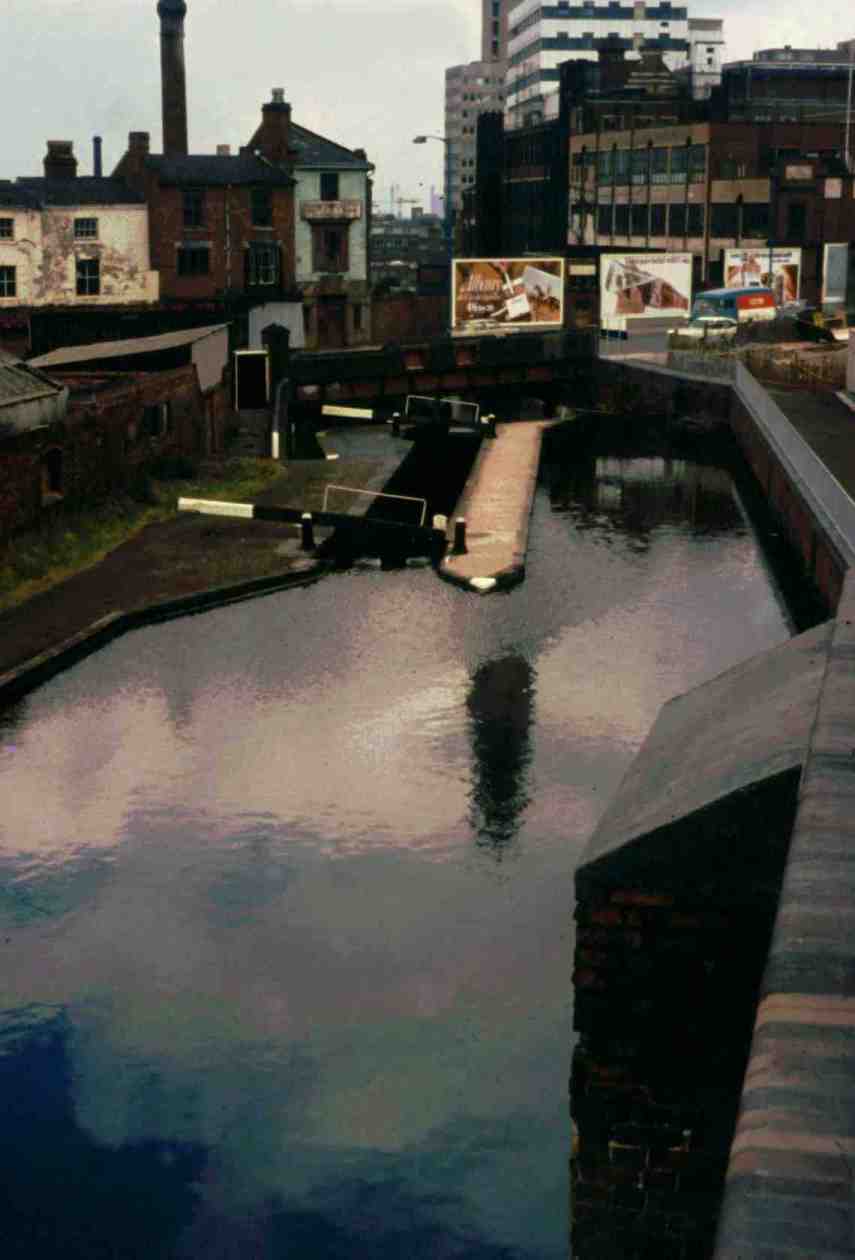
Two photographs of Farmers Bridge Locks in Birmingham
Once under way again we descended the flight of locks at Farmer’s Bridge, dominated by the giant GPO Tower. At one point a modern office block named James Brindley House had been constructed over the canal and, in fact, directly over a lock. It is a pity that it wasn’t raining so that we could have taken refuge beneath its span. Soon after descending the Farmer’s Bridge flight we turned right at Aston Junction and encountered the six Ashted Locks. The next junction was Digbeth Junction at Warwick Bar and followed soon after by Bordesley Junction that marked the start of our journey on part of the Grand Union Canal. All too soon our trip along the labyrinth of canals that thread their way through Birmingham came to an end when we arrived at the Camp Hill flight of locks. These locks were extremely dirty and oily and we stopped at the first opportunity to clean the residue off the waterline of “Phial’s” white hull.
The Grand Union Canal is a seriously wide canal similar in dimensions to the Bridgewater Canal. We admired the large Knowle Locks which gave an insight as to what the Hatton Twenty One would be like should we decide to venture further south at a future date. Before very long we were at Kingswood Junction where the Stratford upon Avon and Grand Union Canals meet. The Kings Norton Guillotine Stop Lock is situated on a small arm that leads off the Grand Union to the Stratford Canal. At this point the Stratford Canal splits into two… the Northern Stratford which connects with the Worcester and Birmingham Canal at Kings Norton Junction and the Southern Stratford which winds its way down to the town that gives the canal its name… Stratford on Avon.
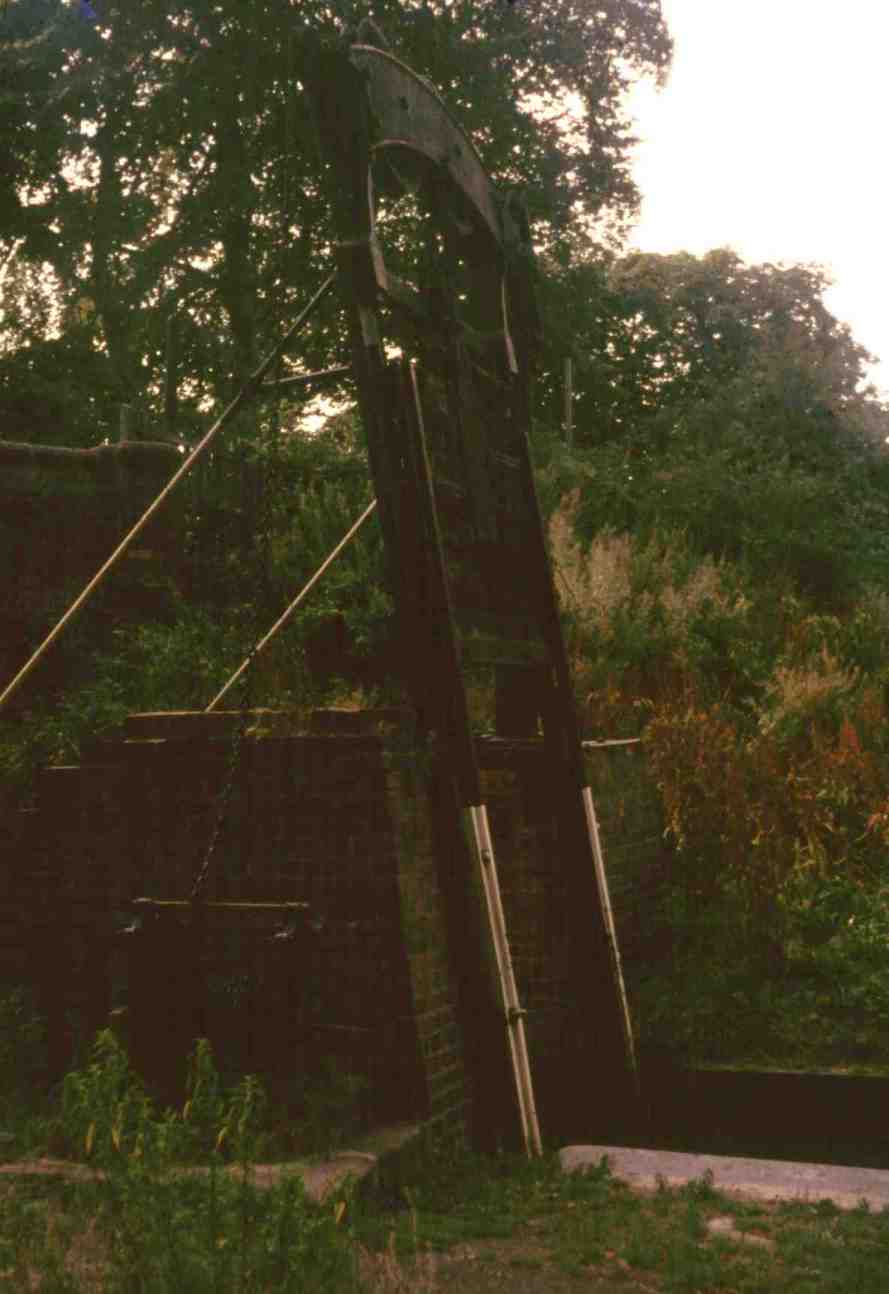
Guillotine lock gate King's Norton Stop Lock
Before starting down the canal we made a brief excursion on foot to the nearby garage to replenish the fuel tank. On our return we cast off and entered the first lock where we paid our National Trust Licence fee (the National Trust owned the canal at that time) and descended the lock which was in first class condition. It was only later on that the cut-corners in maintenance became apparent.
Below lock 21 we encountered the first of the barrel roof cottages that are a feature of the southern part of the canal (none exist on the Northern Stratford). It has been suggested that the cottages were built this way for cheapness and that the navies (short for “navigators”) who had constructed the canal tunnels could construct a cottage in this form more easily than the conventional method of a pitched roof. In truth, no one knows who designed these unique structures or why this form was chosen. Another feature of the southern end of the canal is that the tail (bottom) of the locks have a single gate instead of a pair of mitred gates. This may sound like a good idea, as you only have one gate to close rather than two, but the single gates are very heavy and most have only one gate paddle so are slow to empty.
As we ventured further down the canal we encountered lock paddle gear that was so badly worn that we had to wedge branches into the racks so that the pinions could wind them up and down. We were annoyed at the time but the canal had only been open a few years after its restoration and allowances had to be made for this fact. This canal has many oddities such as the previously mentioned barrel roofed lock cottages, the split-arch bridges and unusual cast iron aqueducts.
There are three aqueducts on this canal that feature cast iron troughs. The first (and smallest) is at Preston Bagot and it leads directly (or out of – depending upon the direction) into a lock. The next is at Wooten Wawen which carries the canal across a road. When we came to Edstone Aqueduct (which possesses the longest cast iron trough in England) I decided to walk across the aqueduct on the towpath which is at the same level as the bed of the trough. I was busy taking photographs when “Phial” came past me at shoulder level… most uncanny!
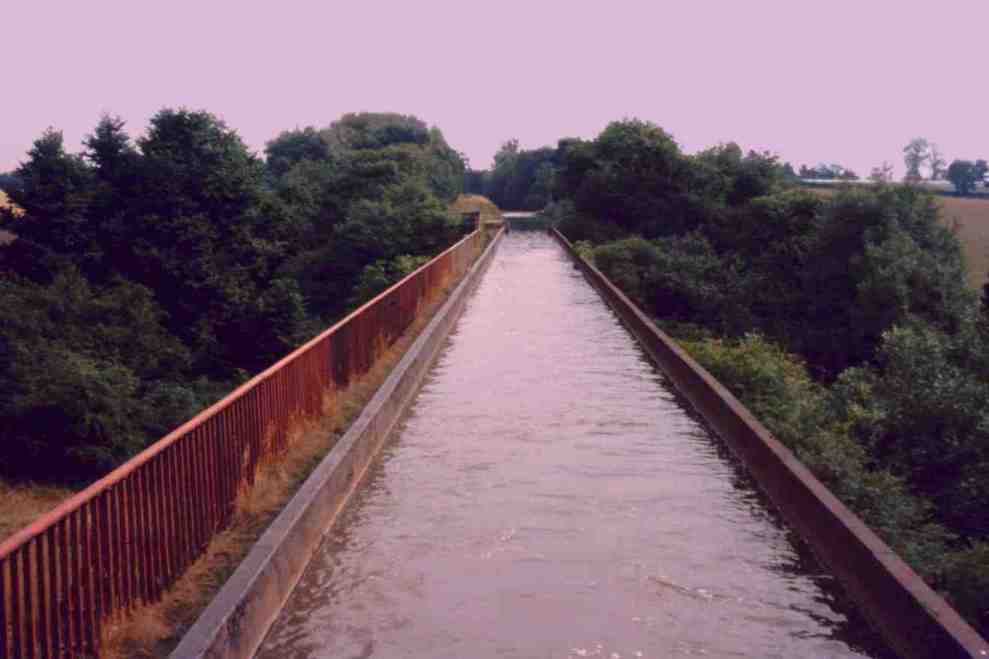
The cast iron Edstone Aqueduct on the Stratford Canal
Once in Stratford, we moored in the basin and I looked after the boat whilst Mother and Father went shopping. On their return it was my turn to go exploring. After walking around the town and taking many feet of ciné film (as well as quite a few 35mm transparencies) I returned to the boat, we cast off, locked down onto the Avon and cruised down to what is now the present location of Colin P Witter Lock, the first lock downstream of Stratford. As the river had not yet been restored to full navigation, we could not navigate any further downstream so we turned around at this point, headed back upstream and moored by the trees opposite the Royal Shakespeare Theatre. Later on, we left Stratford on Avon and cruised out of the town for a few miles before we found a suitable mooring for the night.
The place that we moored was in the middle of nowhere but there was a road of sorts running along the towpath. Around nine-o-clock in the evening a red Ford Thames 300E van (based on the Ford Anglia 100E saloon) came bouncing along the road at quite a speed. A few hours later the same van returned and we thought no more of it. That is until the next morning when we saw the van upside down in the canal. There was a lock not too far away and it seems that the driver of the van was a student who spent his summers as a lock keeper. The previous evening he had gone to the pub and drank too much. Hence, on his return journey to the lock cottage, he missed the track and ended up in the canal. Fortunately he wasn’t hurt except for a few scratches and his pride!
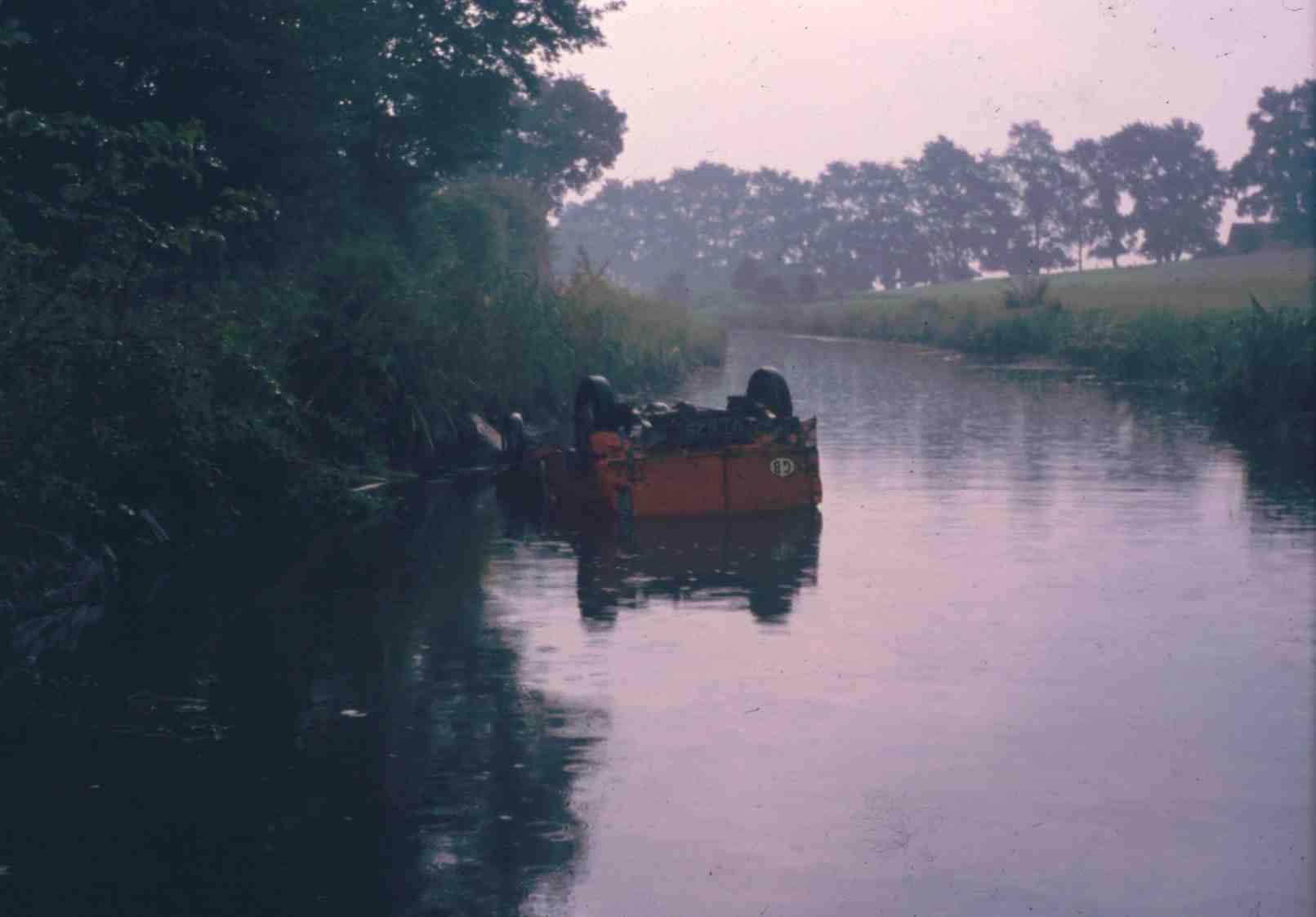
A drowned Ford Thames 300E van in the Stratford Canal - 1969
The next day we started to retraced our route up the canal When we eventually reached Birmingham we decided to take Brindley’s Old Main Line through Birmingham. We discovered that the old route was not as well used as the New Main Line which was evident by the number of times that we had to stop to replace shear pins and to clear rubbish from around the propeller. Before long we were locking down the Wolverhampton 21 onto the Staffs and Worcs and our home waters of the Shroppie to Beeston after a most enjoyable and adventurous holiday.
As well as ciné film I took many photographs on this holiday but with hindsight I would have taken a lot more photographs of the changing face of the canal system in this area, especially whilst passing through Birmingham and beneath Spaghetti Junction. We saw many working boats that have now disappeared as have many of the wharves that they traveled between.
In 1970 we decided to cruise down the River Severn again but this time as far as the Gloucester and, if time allowed, along the Sharpness Ship Canal to visit my Uncle Rex (Father’s younger brother) who lives in Stinchcombe, not too far from the Slimbridge Wild Fowl Centre. In Gloucester we moored adjacent to the Pillar Warehouse on Baker’s Quay. The docks have changed considerably since we visited them. They are home to the National Waterways Museum - Gloucester and many other visitor attractions within the Conservation Area that encompasses most of the docks. Unfortunately, after buying groceries, petrol, etc, we did not have sufficient time to venture very far along the Gloucester and Sharpness Ship Canal we left our warehouse mooring, explored a little way along the Gloucester and Sharpness before turning around and headed back upstream.
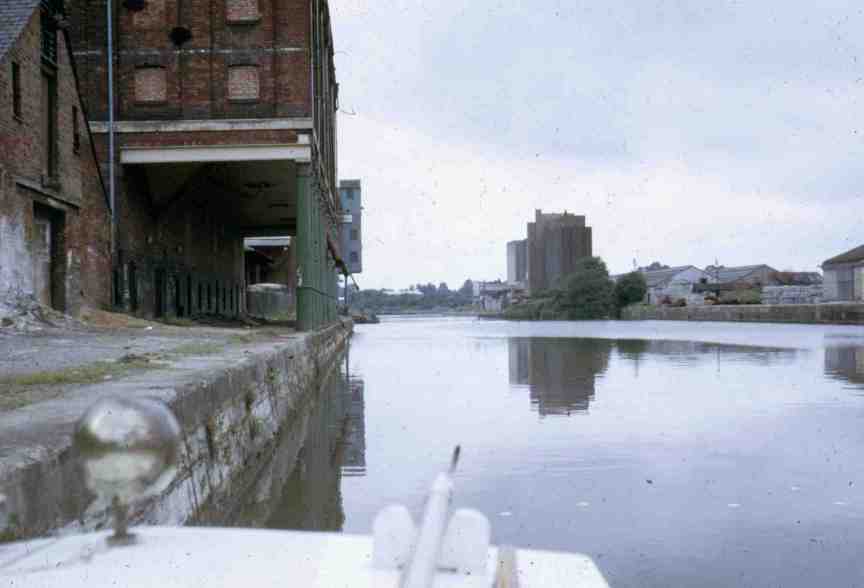
The view from "Phial" moored outside the Pillar Warehouse at Gloucester Docks
“Phial” loved the deep water of the River Severn and with the throttle wide open we made mincemeat of the broad, deep waterway... even when going upstream against the current. A few more horsepower and I think that she would have tried to “get up on the plane”. As previously mentioned, the commercial traffic caused problems, especially when we were moored but we took these problems in our stride.
The holiday was enjoyable but uneventful and it was to be the last of my long distance cruises on “Phial”. This was due to my girlfriend (later to become my first wife – more of which later) wanting different types of holidays and also my not being able to have the same holidays as my parents. But “Phial” was to go further south without me. In later years she navigated the complete length of the Coventry Canal and, on another occasion managed to reach Leicester with just Mother and Father on board. Unfortunately I cannot relate details of these cruises as I was not with them and Father did not keep a log of their cruises (but they did send me postcards).
The spring of 1967 was a very sad time. It was the occasion of the foot and mouth disease outbreak that affected the Beeston area badly. When we were driving up to the boat we could see mounds of cattle carcasses being burnt and buried. On one occasion, we were stopped at Golden Nook Bridge near Waverton by a roadblock preventing people from entering the area in an attempt to stem the spread of the disease. To this day one can still see the mounds in the fields that are the graves of the poor, unfortunate creatures that succumbed to this deadly disease.
Whilst discussing the Waverton area, the route that we took to reach Beeston from home prior to the opening of the M53 motorway was along the A41 to past Christleton where we left the main road and drove along Moor Lane. This lane took us through the rich Cheshire countryside through Waverton where it wound through the village and around its sandstone church. Mother had read a series of novels by a local author whose name I cannot remember that were set in the area. After leaving the village behind the lane runs alongside the Chester Canal for a mile or so. Along this stretch of road was a lay-by where we used to stop to let Jack the dog relieve himself. It was uncanny really as he always knew when we were approaching the lay-by and started to get excited, If we did not stop there he would have a look of dejection on his face and sulk for the rest of the journey to Beeston.
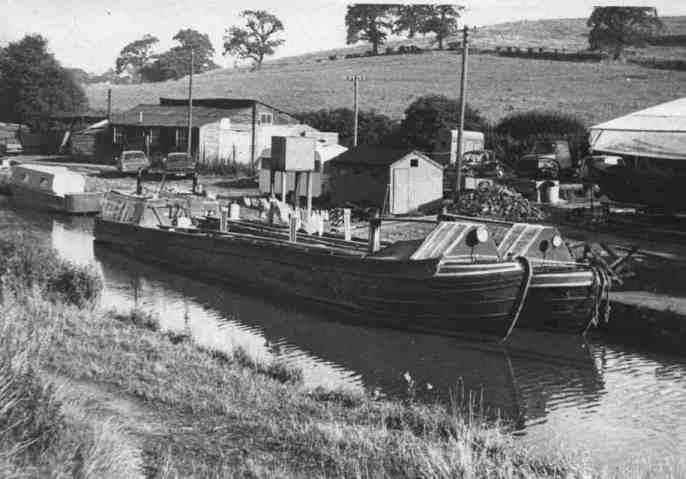
Ex-working narrowboats moored at Beeston Wharf in 1969
We had become quite friendly with Mister Merral, the owner of “Phial’s” moorings, his wife and son. Sydney… the name we came to know him by, was like the canals’ answer to Fred Dibnah, complete with “weskit” (waistcoat), moleskin pants and flat cap (all that was missing was the red bandana). An agricultural and drainage engineer by trade, his claim to fame was the invention of the “Mole Plough”. This was a device that was towed behind a tractor and fed flexible piping or electrical cable into a channel that the plough made at adjustable depths beneath the ground. He was a bit of a collector of all things deemed useless by most people but he might just find a use for them one day. He would go to Beeston Market farm implement sale and come back with all kinds of tools, bits and pieces to the dismay of his wife… Marion.
Mother (standing on the back deck of "Phial" and having a bad hair day) and Marion Merral (sitting)
(Photograph - James M Wood)
He was a canal enthusiast in the truest sense of the word. As well as owning Beeston Castle Cruisers, he used to build his own boats. The fleet consisted of “Skylark” (a pair of pontoons, joined together to about 35ft fitted with a cabin and an air-cooled Lister engine), “Starling” (the bow and stern sections of a full-length narrowboat welded together, fitted with a distinctive cabin and a BMC “Commander” 2.2 litre engine) and “Swan” (the centre section of “Starling” fitted with a cabin similar to “Skylark” and also an air-cooled Lister engine). “Swan” was renamed “Jacqueline Yvonne”, moored at Lymm and then Grappenhall on the Bridgewater Canal before changing owners and moving to the Macclesfield Canal. Even now, over thirty five years later, the hull still appears to be in good condition and the original timber cabin has been replaced but retains the design of the original one. Sidney did build other boats… the “Seagull” was one of them but was sold after a few years in the hire fleet. On one occasion, he bought a sixty foot Leeds and Liverpool “Ice Boat” hull and brought it back from Skipton on the Leeds and Liverpool Canal, powered by a “Seagull Century” outboard motor. He planned to fit an engine, counter stern and cabin and add it to the rest of his fleet. Unfortunately, the conversion never took place and the hull ended up being sold to a private buyer.
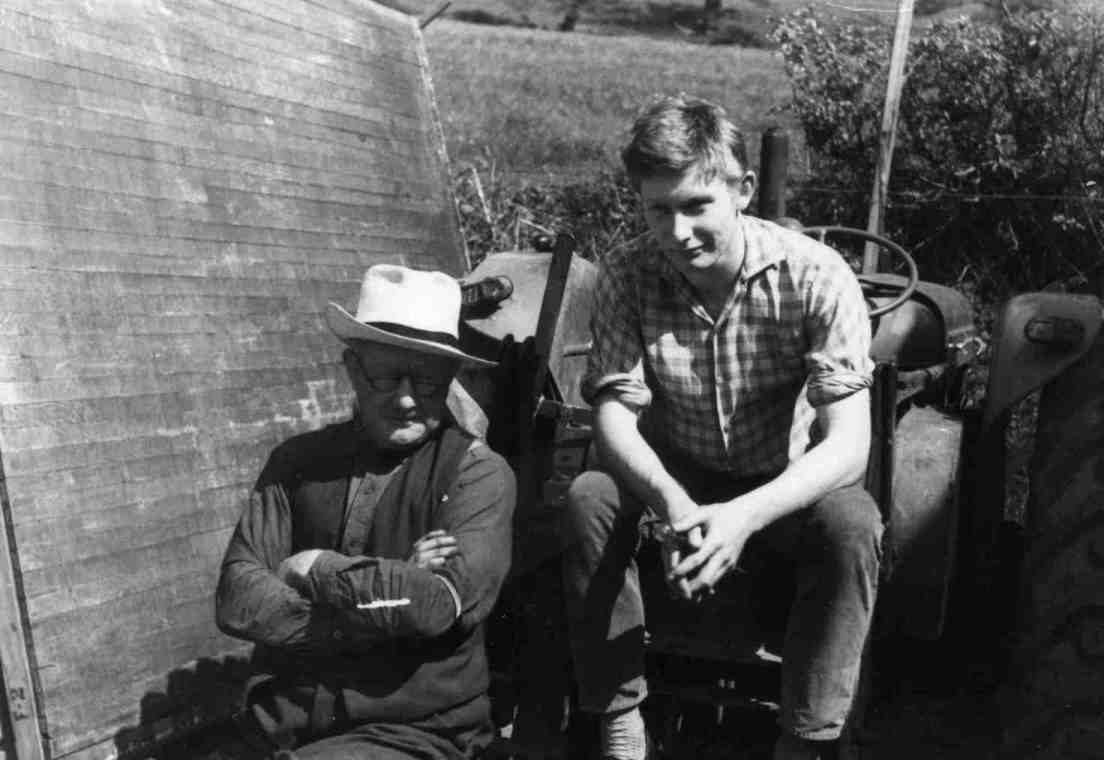
Sidney and Tom Merral
(Photograph - James M Wood)
In the early days the journey from home to Beeston initially was via the A41, A51 and A49 roads (this was in the days before the M53 was constructed). I can remember Father shouting "The Headless Women" every time we passed the pub in Duddon that bares that name. Mother was not impressed by this behaviour and neither was Ange when I recently shouted the same announcement as we passed this location! Mister Merral suggested a quicker route along the A41 to Waverton then onto Moor Lane and a route using the "B" roads running alongside the canal, crossing it at Golden Nook Bridge then on through Huxley to Tiverton where we joined the A49 for a couple of hundred yards down the hill to the small lane that lead to the moorings. In the end it took about forty five minutes from door to door and I came to know every bend and bump in that road.
During the winter we would go up to Beeston on a Sunday afternoon to check on "Phial". On one occasion there was snow on the ground and as we drove around a corner not far from Golden Nook Bridge the A35 skidded on a snow drift, left the road and ended up in a ditch. No amount of pushing would remove the vehicle from the ditch so Father decided to walk to a nearby farm and ask the farmer to help with his tractor. Not too long after he left, a huge Massey Ferguson came bouncing down the road with Father riding side-saddle next to the farmer. It only took one "go" to retrieve the A35 from the ditch and after thanking the farmer we were soon on our way again. Sometimes we would drive up to Beeston in the evening after tea and watch home movies or slides with the Merrals. On one occasion, Sydney took Father and I to a meeting of the IWA. in Manchester where Frank Mullineux, the well known Bridgewater Canal Historian was giving a lecture on the Worsley Mines. The information that I gained at this lecture was to sow the seed for my appreciation and love of the Bridgewater Canal… more of which later.
Father and Sidney prepared a new mooring for “Phial” above the Iron Lock in the spring of 1967. This entailed dredging the canal, building a concrete landing stage and erecting a shed in which to keep various items (like the outboard motor) when not in use. He also laid on mains electricity, which was, in turn, connected to “Phial” via a forerunner to the waterproof three-pin connections that we use today to connect our boats’ 240 volt circuits to a land line.
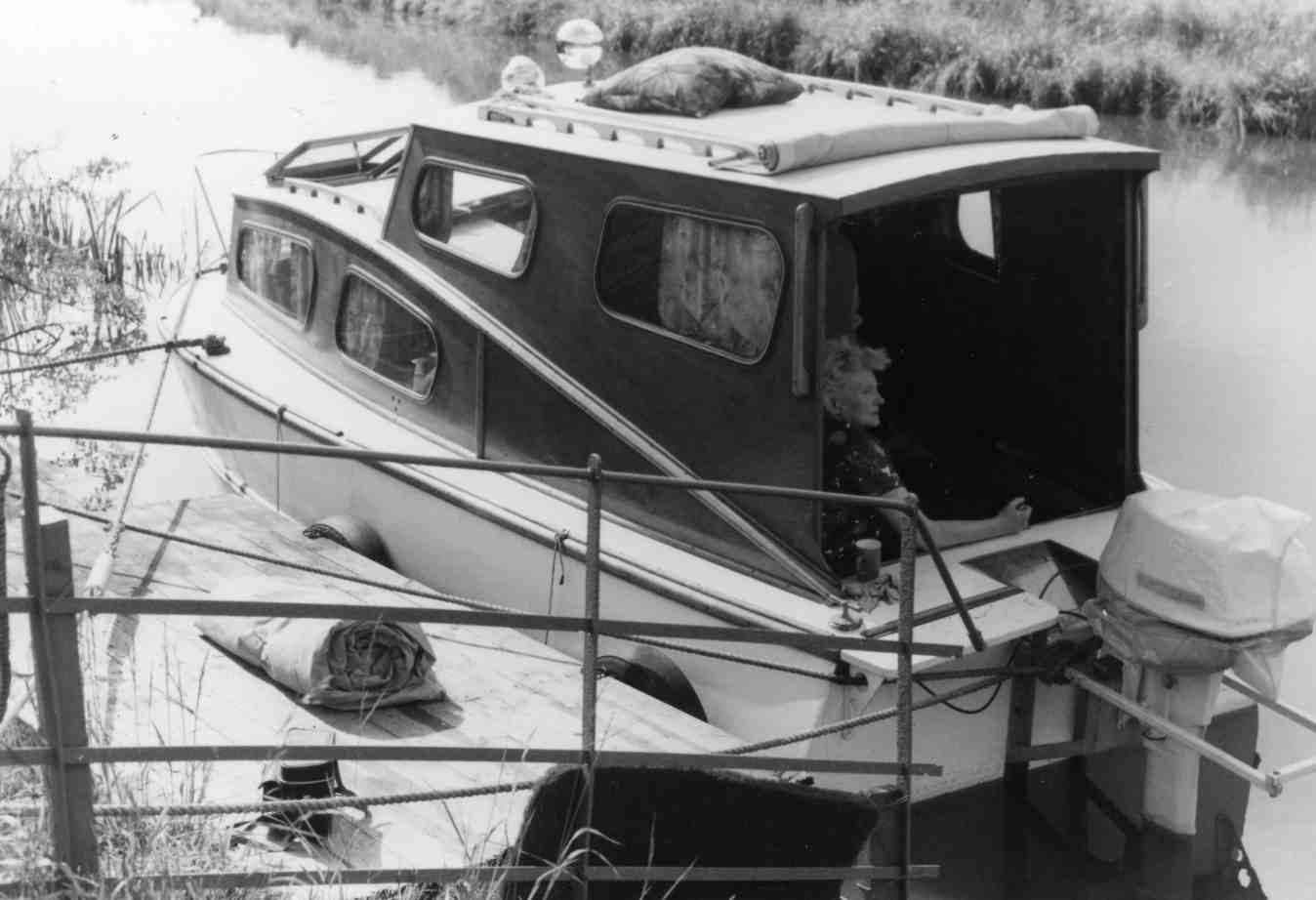
Phial at her new mooring above Beeston Iron Lock - April 1967
(Photograph - James M Wood)
Sydney also taught me to drive his Massey Ferguson tractor and later, when I had become more proficient... the more powerful Fordson Major tractor. I would, on occasion, help him on jobs when his son Tom was unavailable. I became very proficient at clutch control and throttle feathering which stood me in good stead when I was old enough to apply for my driving licence and start taking driving lessons. Whilst on the subject of my learning to drive, after Sydney gave me my introduction to driving , Father used to let me drive his Austin A35 van along the private lane that lead to the boat’s moorings and later on when I had my Provisional Driving Licence, I would drive on the public roads from Golden Nook Bridge along the back lanes to Tiverton where Father would take over again for the short stretch down the A49 Whitchurch Road to Beeston Brook where the boat was moored.
One humorous tale concerns Sydney and the North West Section Inspector of British Waterways who was, on this occasion, doing his rounds. They were sitting on “Starling” drinking a cup of tea and discussing canal matters in general when an “Amphicar” (an amphibious motor car based on a Triumph Herald chassis) went past on the canal. They were engrossed in watching this strange craft go by when the Inspector (who was responsible for enforcing the speed limit on the canal) jumped up and exclaimed, “That bugger’s doin’ more than four miles an hour and I’ll bet he hasn’t got a license either!” He duly jumped off the boat and accosted the unsuspecting steerer of the craft at the tail of Beeston Iron Lock.
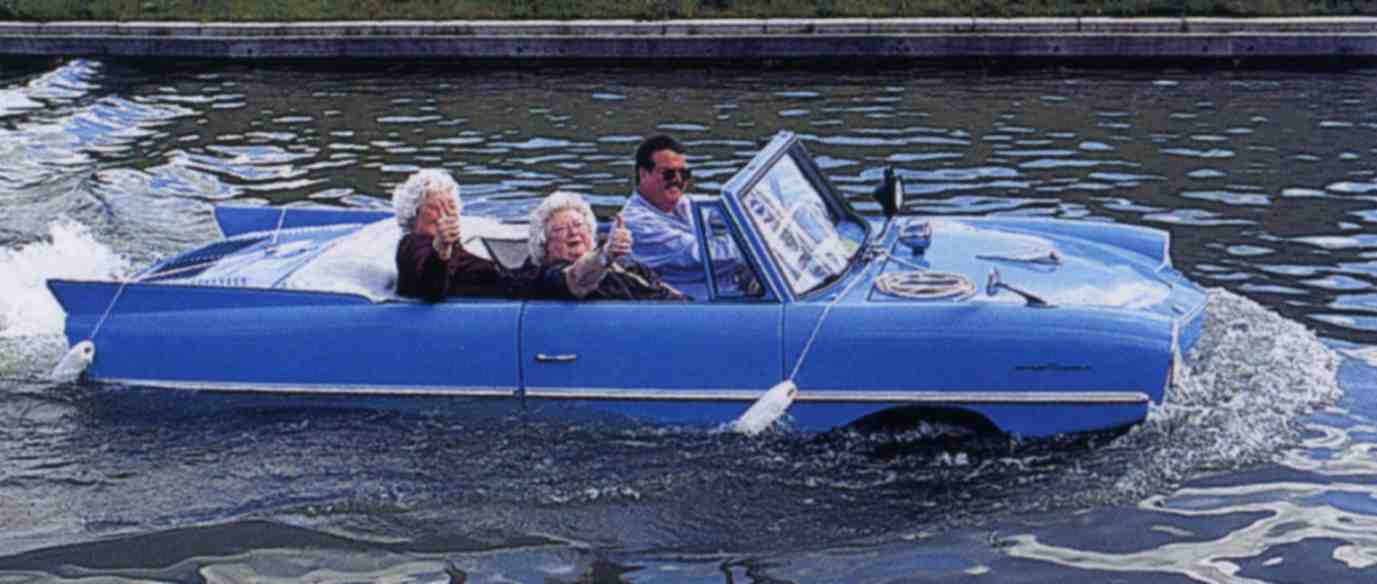
A good example of an "Amphicar" cruising on a canal
(Note no BW registration numbers though)
On another occasion, Sydney was bringing one of his boats, the “Skylark”, out of the water at the slipway he had constructed. A trolley was backed into the canal and the boat maneuvered onto it before being pulled out by his Fordson tractor’s winch. One of the trolley’s wheels got stuck in the mud on the canal bed and had to be raised-up by a five ton hydraulic jack. When the wheel was clear of the mud, a wooden board was placed beneath it to spread the load. Unfortunately, the jack was lost during the maneuver and Mister Merral offered a “thirty bob” (£1.50… quite a lot then) reward to the finder. When the trolley was out of the way, Tom and I rolled up our trouser legs and started to grovel in the mud to try and find it. Needless to say, we didn’t find it. A few weeks later, when the boat was being re-launched, Tom was in the water guiding the boat off the trolley when one of the wheels caught on a large stone. He jokingly said “I’ll just get this five ton jack out of the way” and tossed, what he thought was a stone onto the canal bank. It wasn’t a stone at all but none other than the lost five ton jack. Needless to say, his father stood by his word and gave Tom the reward.
I quite often helped the Merrals with their boats, taking them down to the winding hole at the end of the straight stretch at Beeston to turn them around prior to them being taken out by the next hirers. Theirs were the first narrowboats that I steered and I will never forget the first time that Sydney allowed me to take “Starling” down the cut on my own to wind ready for the next hirers. Tom’s friend… Richard “Dixie” Dean had a seventy foot, wooden, ex-working narrow boat called “Dove” which would quite often visit Beeston and moor at the wharf when the hire boats were out. I was invited aboard on many occasions for a short cruise down to the winding hole and on one occasion I was allowed to steer this seventy foot giant (complete with speed wheels and gear rods). In fact, “Dove” was the first full-length narrow boat that I ever steered. I have not seen Richard for many years but Tom tells me that he is a cartographer, has kept his canal associations and he often produces maps for many canal authors including Charles Hadfield. Recently, in “Waterways World” Richard wrote a series if articles about Bradshaw’s canal maps and is involved in “Waterways World's” sister magazine… “Narrow Boat”. It’s a small world isn’t it?
The author aboard "Dove" inside Wharton Lock in 1967
(Photograph - James M Wood)
At the top of the slipway adjacent to the Iron Lock was a partially completed narrowboat that Sydney had always said was going to be his own personal boat when he retired. In later years I contemplated buying this boar off Sidney and completing it myself. But this wasn't meant to be and the part-completed boat was eventually sold to someone who completed it and moored it on the Wirral Line of the “Shroppie” at Stoak Picton near Ellesmere Port. There was also a steel narrow boat hull tucked away in the corner of Sydney’s field close to where “Phial” was moored. When they were young, my children used to play inside the hull and floated their model boats on the rainwater that collected inside it. Sydney threatened to complete it one day and put the boat into his hire fleet but this never happened and the hull was also sold privately.
Tom and his friend Phil built an all-steel hull and superstructure from scratch in the saw mills opposite Beeston Market that Sidney leased. When the steelwork was completed the shell was brought around to the wharf on a trailer where it was launched and completed. The resulting craft was christened “Panther” and was moored below the Iron Lock for many years until Tom bought the house at the top of Grindley Brook Staircase Lock on the Llangollen Canal and moored it there. Tom no longer owns “Panther” but she is still moored at Grindley Brook where Tom now has a caravan and boat repair business.
We spent a great deal of time at Beeston and came to look upon it as our second home. Marion Merral suggested that my parents visited Beeston Castle Farm which was owned by Freddy Wood (no relation) and his father, to purchase eggs, milk, etc. We became quite friendly with them and they gave us an open invitation to visit them anytime. Freddy's father also lived on the farm. He was quite a character and had a predilection for swearing. In fact he introduced quite a few new words to my vocabulary (needless to say that I didn't use them then and I don't use them now)! I enjoyed walking around the area and quite often strolled across the fields to Beeston Castle, “bunking” over the boundary wall surrounding it when it was closed and there was nobody around. On the way there I would quite often visit Beeston Castle Farm. Freddy's wife took a shine to me and would feed me bacon and egg sandwiches. On one occasion her father-in-law taught me how to milk goats. I can still see him now showing me the correct way to hold and squeeze the teat whilst he squirted the warm, creamy goat's milk into my face. They all found it more humorous than I did! I later was to graduate to milking cattle. The first thing that one learns when milking cattle is to recognise when the cow is going to give a kick with one of its rear legs and how to avoid contact with the hoof. Something that I never seemed to pick-up on!
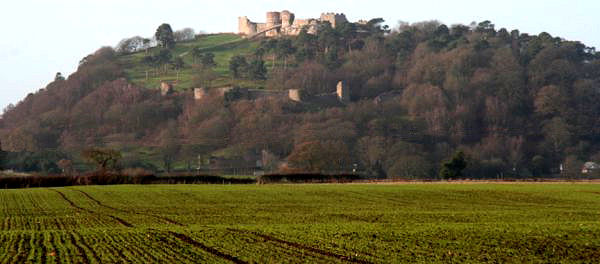
Beeston Castle overlooking fields belonging to Freddy Wood's farm
Whilst out walking I would quite often see brand new Rolls Royce Silver Shadows or Bentley Ts undergoing their road tests from the Crewe factory. The A49 trunk road, which ran through Beeston, was on the test route that they regularly used and I can remember that the cars usually had their radiator grills missing and that the paintwork looked dull due to their not having been polished yet. We were soon accepted into the local community as we got on well with everybody and shared many happy memorable moments. Sydney had a good relationship with Father and they both did many favors for each other over the years.
Another of the other characters that lived at Beeston was Harry Williams, the lock-keeper at Beeston Stone Lock… the next lock up from Beeston Iron. He could be seen most nights staggering along the towpath on his way home after imbibing many pints of the “falling down liquid” at the Beeston Castle Hotel, opposite the railway station (when it was there) and adjacent to the cattle-market. On his retirement he took a cottage at Barbridge (the one nearest the "Jolly Tar" pub) and his place was taken by a young man by the name of Stuart who must have had an affinity with goats if the number of these creatures he had grazing around the lock was anything to go by.
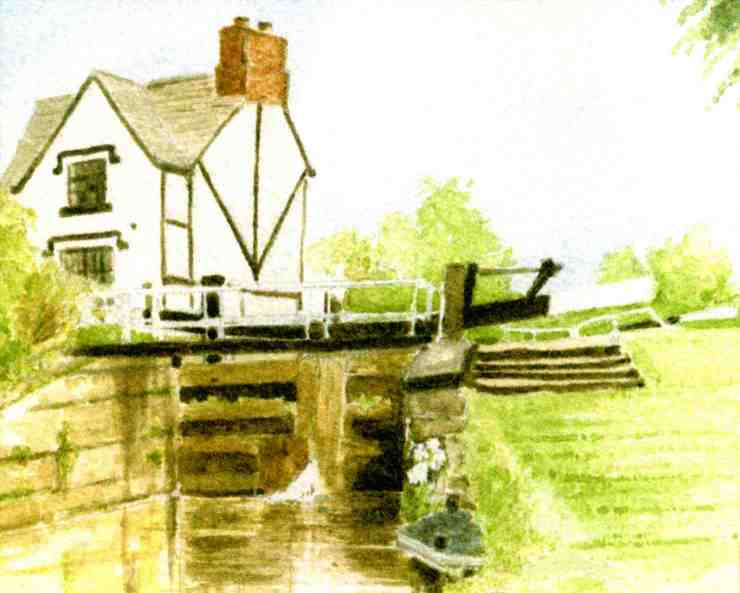
A watercolour painting of Beeston Stone Lock by an unknown artist
One of our family friends was Doctor Anne Biezanek... the well known advocate of birth control in the 1960's (my best friend at school... Chris "Doggy" Glassfield married one of her daughters). Doctor Biezanek had a small steel cabin cruiser on which she spent much of her free time. I had not long passed my driving test when she asked me to run her to Preston Brook on the Bridgewater Canal where her boat was moored near to Preston Brook Tunnel after one of her voyages. "It will only take you half an hour" she told me. This was a case of famous last words. I had never driven in that area before but she did know the way. We turned off the main Northwich road close to the "Tunnel Top" public house and bounced down the lane (try potholed track) that lead to the cutting on the Bridgewater Canal side of the tunnel. This was the first time that I had ever been there and little did I know that in years to come it would be my home waters. After dropping her off at her boat I managed to retrace my steps to Beeston without incident or getting lost... and she never did give me any money for petrol! But anyway, she did introduce me to Preston Brook.
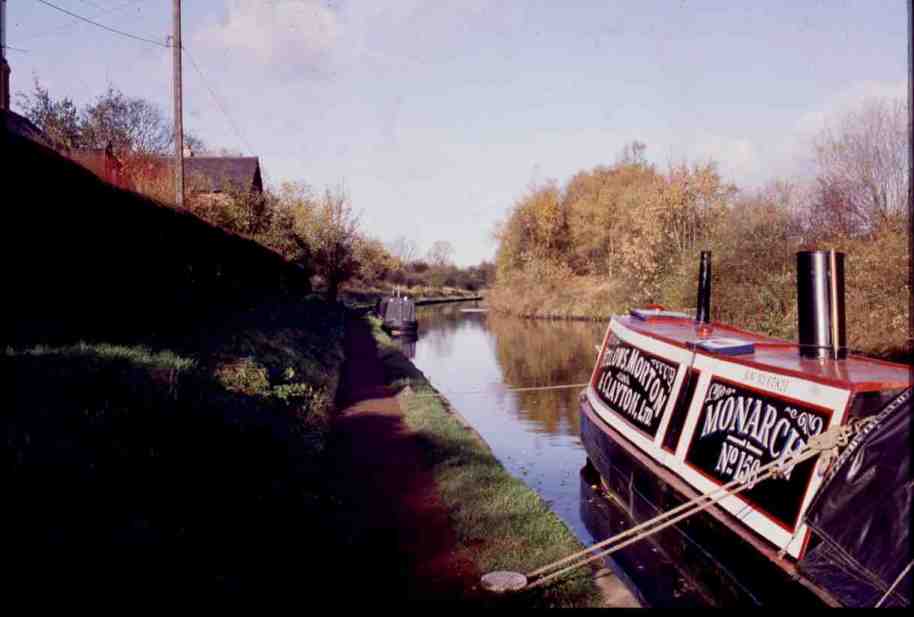
The Bridgewater Canal leading to Preston Brook Tunnel
In 1970 I met a girl called Barbara Place who I was to marry a few years down the line. She was not particularly interested in canal cruising at that time although she did come with us when we journeyed down the River Severn to Gloucester. After I was married I did not spend as much time at Beeston or go cruising on "Phial" as I did previously due to family pressures. I think that my parents were disappointed in my not going canal cruising with them any more. With hindsight, they were not getting any younger and would have appreciated the help on locks and swing bridges. At one point they decided to look for a larger boat to replace “Phial” with in the hopes that it would entice my wife to come canal cruising (I didn't need any encouragement). On their return trip during the 1974 holiday they saw a boat for sale at Brewood on the “Shroppie”. It was called “Smuggler” and was a thirty foot (ish), varnished mahogany, carvel-hulled, aft cockpit cruiser not unlike a Taylor and it possessed great character as well as an inboard diesel engine. Mother asked me to take her down to Brewood by car to have another look at it and to hear my views on the boat. This I did accompanied by a very pregnant wife who did not enjoy the trip at all. It was a nice boat but would have required a lot of up-keep being constructed 100% of timber, most of which was varnished. With hindsight it would have been good for them to have bought this boat as they would have had more space and not have to have worried about the problems associated with outboard motors. But, for various reasons, the plan never went ahead and we have not knowingly seen “Smuggler” since then.
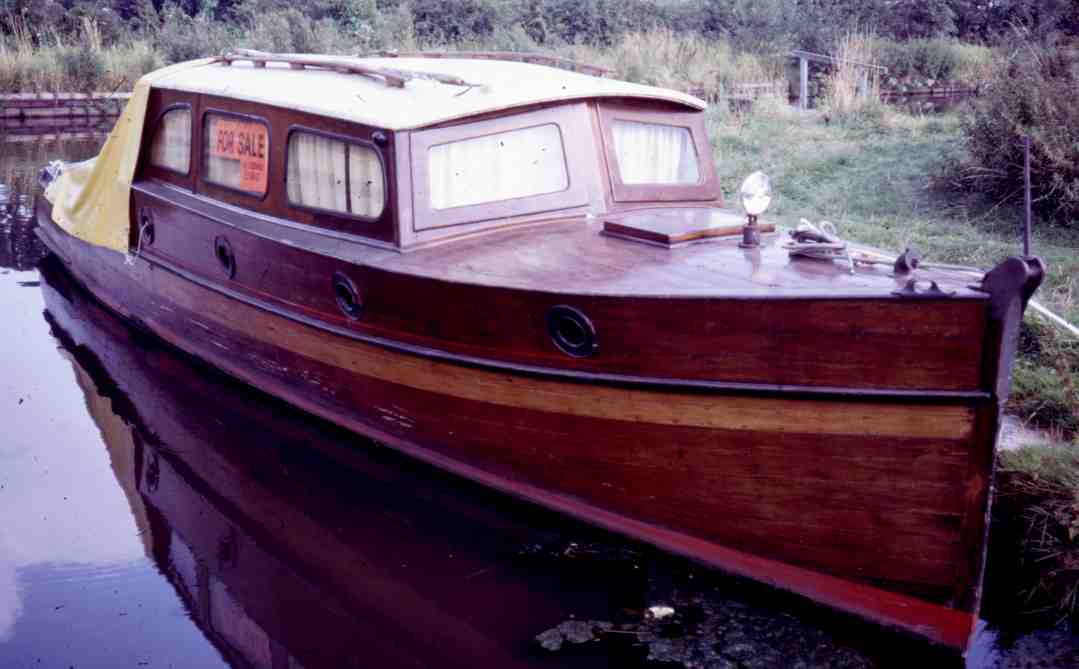
"Smuggler" moored at Brewood in 1974
As the years rolled by, “Phial” aged gently. The odd leak on the cabin joints occurred but was usually sealed by the annual paint and revarnish week every Easter. She was slipped out of the water at Sam Weaver’s boatyard, Waverton in 1975. This was to clean the underside of the hull and check the keel. Needless to say, all was found to be in order.
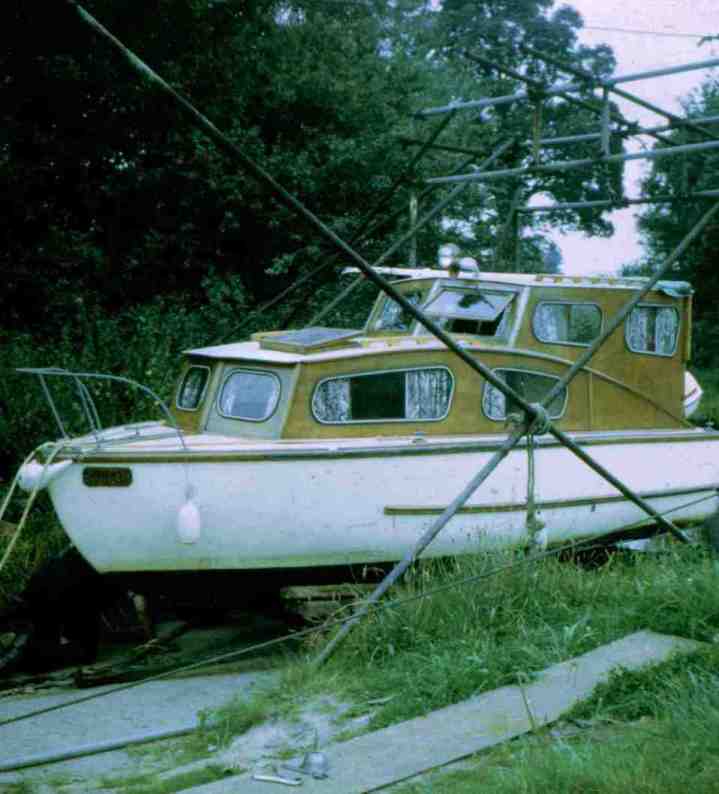
"Phial" slipped at Sam Weaver's boatyard in 1975 for hull cleaning and inspection
Periodically, we would see other Marlin Craft. The Police boat on the River Dee was a Marlin and there were several good examples around as well as a few neglected ones. Their distinctive hull design and cabin lines meant that they can be spotted at quite a distance and they all shared certain design features unique to Marlins like the overall line of the hull and superstructure, window shape, transom bracket, pulpit design, etc.
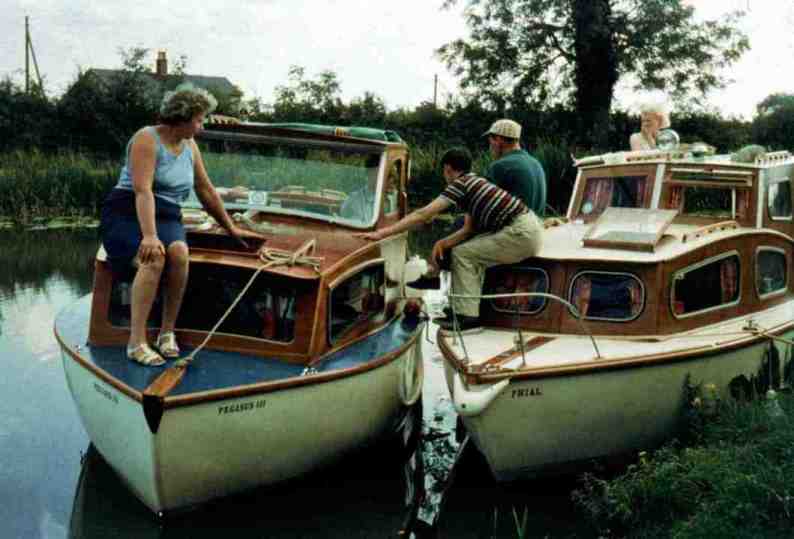
|
Our first encounter with another Marlin - Pegasus 3 at Welsh Frankton in 1966 |
|
(Mother doesn't look very impressed) |
(Photograph - James M Wood)
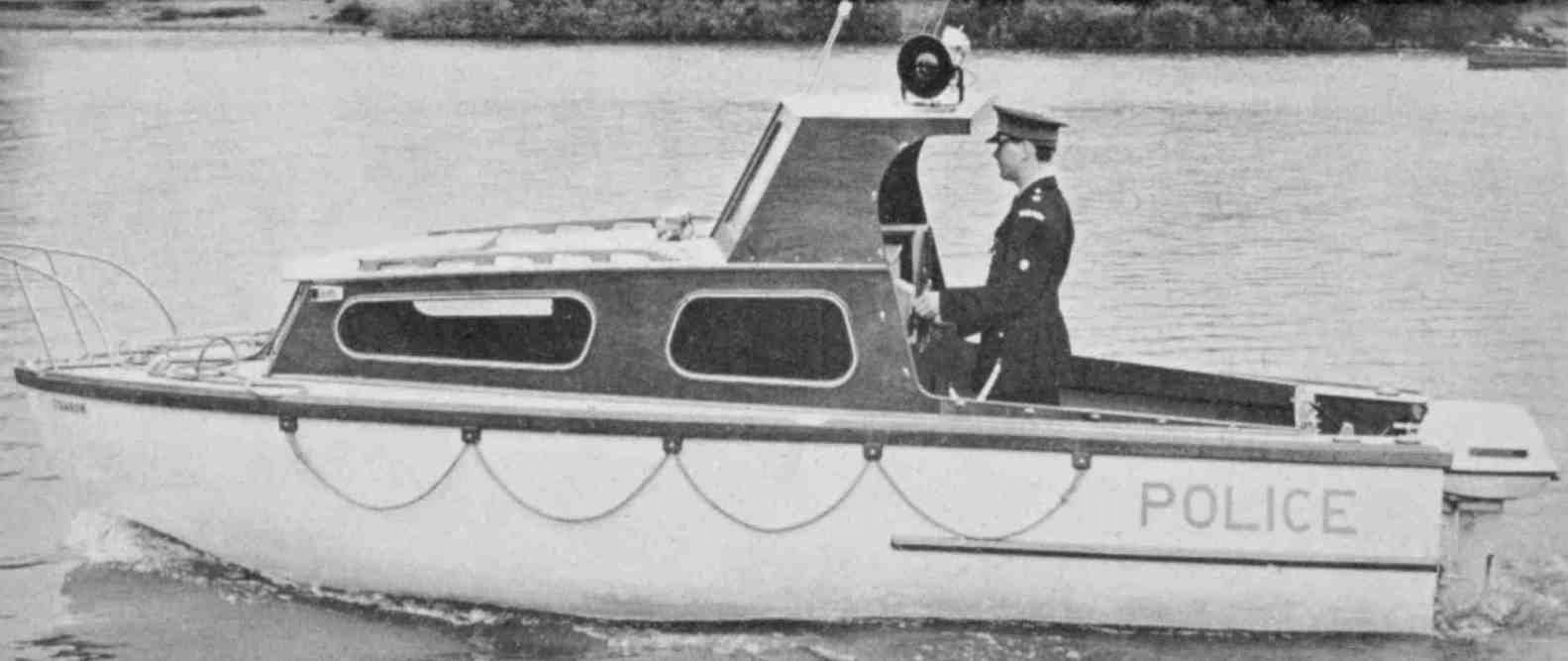
Chester's River Dee Police Boat was a Marlin
(Photograph - Chester City Library)
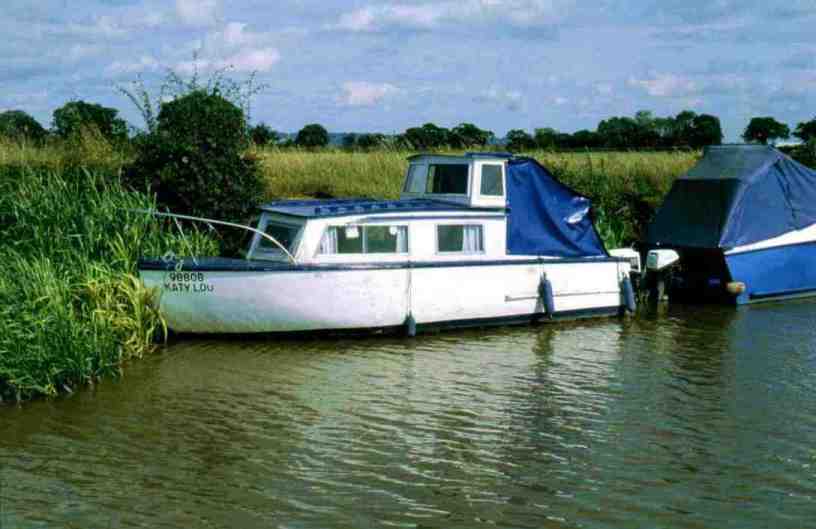
"Katy Lou" was an early example moored at Golden Nook, Waverton on the "Shroppie"
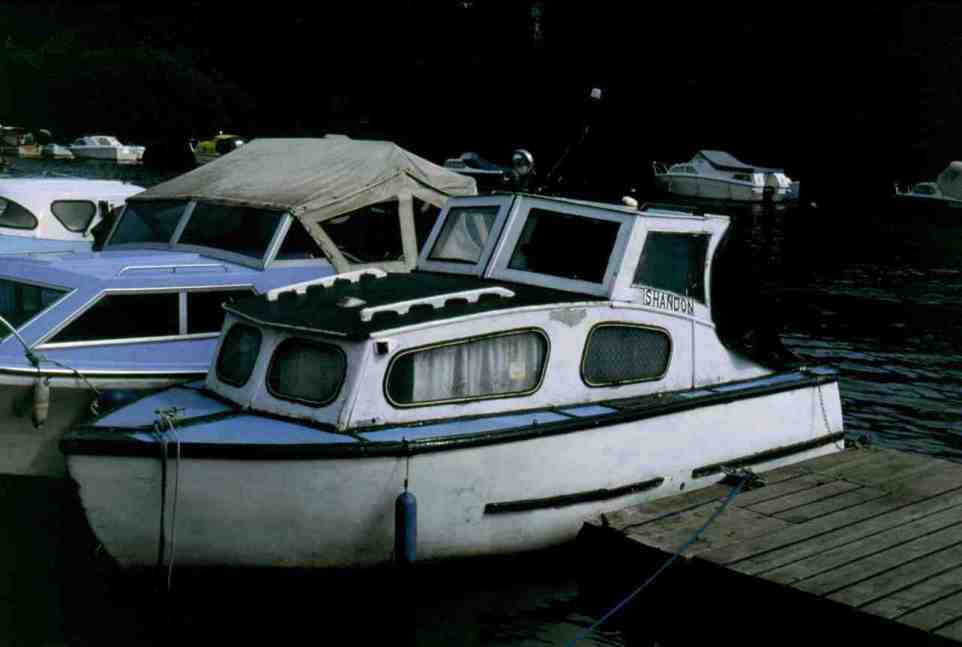
"Shandon" moored on the River Dee at Chester
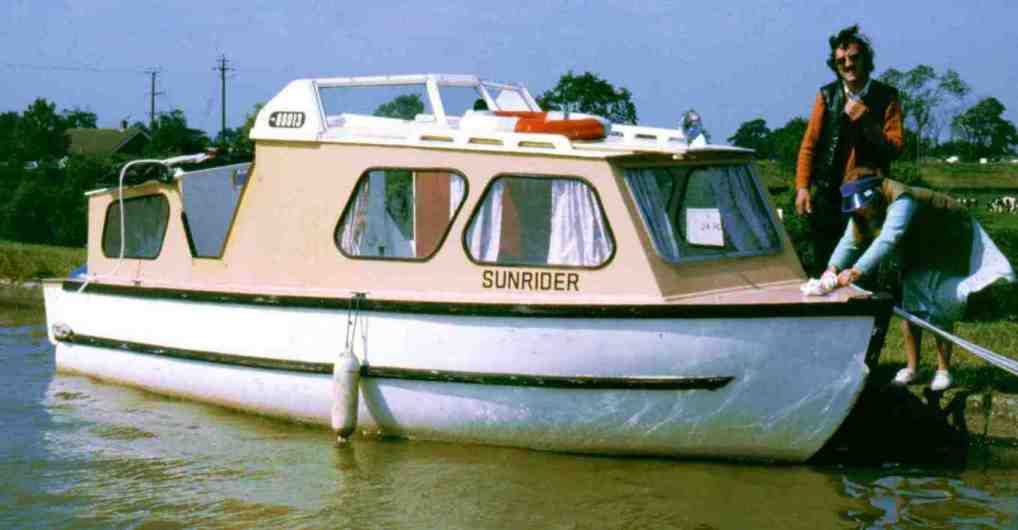
"Sunrider" at Barbridge on the Shroppie in 1984
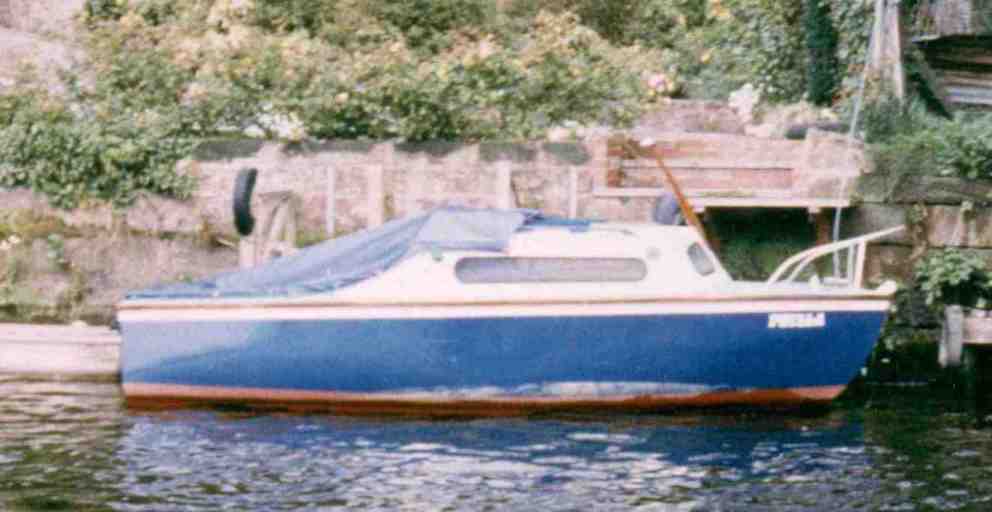
"Portia" - another River Dee resident
Early in the spring of 1975, I hired a narrowboat for a long weekend. We were accompanied by our friends Ian and Rita Fitzpatrick plus their small son, Carl. The boat we hired was “Sunseeker”, a fifty-five foot Mastercraft from Eggbridge Marina at Waverton. We cruised along the “Shroppie” as far as Cholmondeston on the Middlewich Branch. Even though I don’t think that our friends enjoyed as much as we did, I managed to take some atmospheric photographs, some of which are, even today, shown in some of my audio/visual presentations. In fact, the first transparency in the “Canalscape” audio/visual presentation (from which this eBook borrows its title) illustrated below was taken on this occasion.
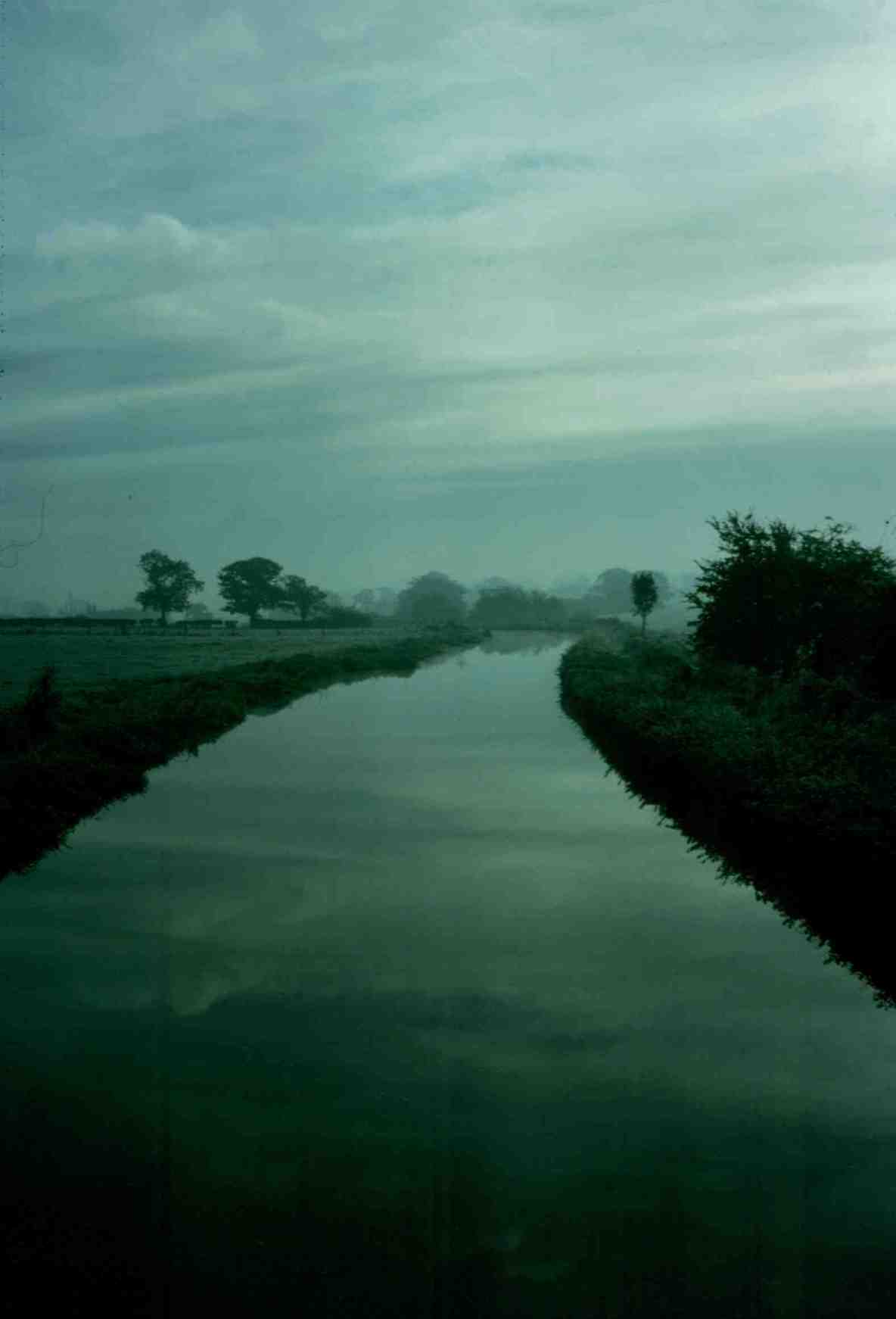
A spring morning at Waverton on the "Shroppie"
In 1978, father died of cancer. He visited “Phial” one last time but had to be taken to Chester Hospital, extremely ill. After they did what they could for him he was transferred to St Catherine’s Hospital in Birkenhead where he spent his last few weeks. As can be expected, “Phial” was a little neglected that year. The following year, Mother, who had by now retired, decided to spend all of the summer on board and did so every year from Easter onwards, only coming home when the weather turned cool in October.
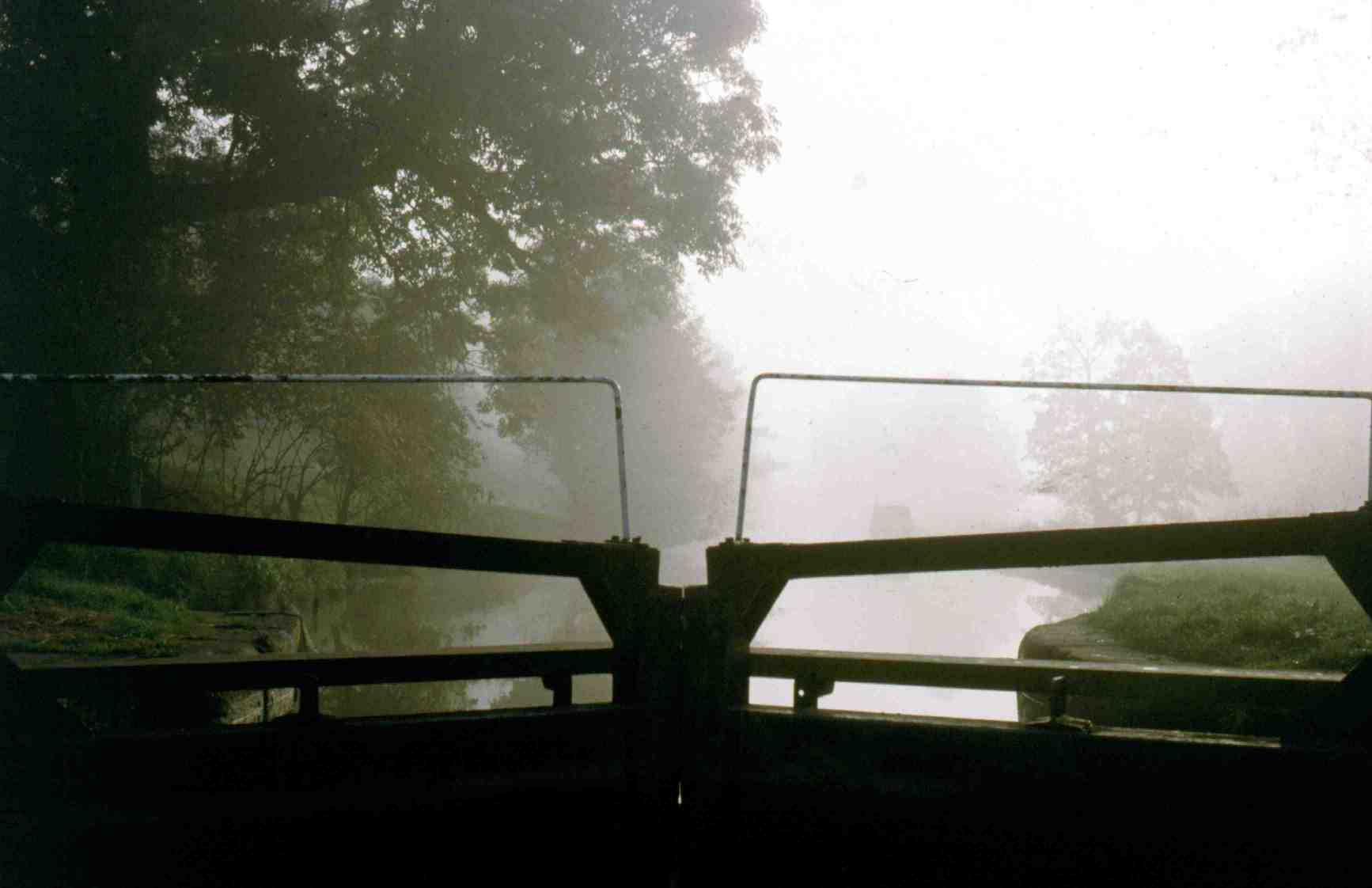
A misty morning at Tilston Lock of the "Shroppie"
By this time I was married and had three children of my own. My children often kept Mother company during the summer holidays and they all have wonderful memories of Beeston, Mother and “Phial”. Mother used to take the children to Chester or Tarporley on the bus and they would accompany her to Tiverton Village Post Office, a fifteen minute walk up the hill from the canal, to collect her pension on a Thursday.
Tilston Lock on a warm summer's day
The children used to explore the fields that backed on to the moorings and spent many happy hours there and had just as many adventures. But they did get up to mischief. One hot, sunny Sunday, the children were playing in the next field when a narrowboat approached Beeston Iron Lock. The people on the boat were laughing and pointing at the children saying… “We’re glad that we won’t have to wash those children!” When I poked my head around the hedge, I couldn’t believe what I saw. They had been paddling at the canal’s edge in a place that was very shallow and used by cattle to drink. They were literally covered from head to toe in mud. We had to hose them down before giving them a thorough wash in the shed. My children are now grown up and they often talk about the summers spent at Beeston (and later, on the Bridgewater Canal). The adventures that they had would warrant a book all to itself. It made me feel good when one of the boys told me that their childhood spent on the canals was like having a holiday every weekend. They all look back with great fondness to the adventures that they had and not many children can say that these days of DVDs, computers, Play Stations, X Boxes and Wii consoles.
Lisa and Michael after playing in mud
“Phial’s” steering had never been to Father’s or my satisfaction and in 1979 I decided to renew the steering assembly. Previously, steering was achieved by cables and nylon pulleys, which transmitted vibrations to the steering wheel and needed constant adjustment to counteract the stretch in the cables. The pulleys, being nylon, were prone to wear and needed frequent replacement. After looking around various boatyards and chandlers, the new system was purchased from Ladyline’s Liverpool outlet that used to be located above what is now McDonalds Restaurant on the corner of Paradise Street and Lord Street. The new system was of the “Teleflex” type and was a revelation compared to the original. Gone were the vibrations that were transmitted to the steering wheel as well as the constant attention. The new system also allowed the engine to be tilted fully for de-weeding once the connection clip was disengaged (which took all of two seconds), a luxury never afforded by the previous system.
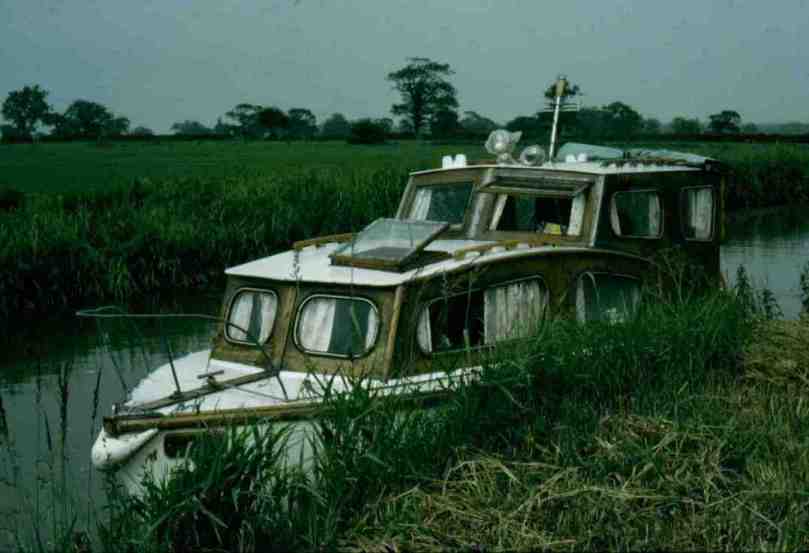
"Phial" moored at Hargrave on the Shroppie in the summer of 1982
In 1980 we decided to take “Phial” up the Llangollen Canal as far as Ellesmere but, with three adults and three children on board, it was understandably cramped. It was on this occasion that we ventured down the Prees Branch for the first time. I can remember mooring just after the second lift bridge and taking photographs of the area. I suppose that it is a testament to Jim and Father who initially designed the boat that the six of us could all fit in eighteen foot six inches. Throughout the summer we also had occasional day excursions to Bunbury, Cholmondeston (by Venetian Marine on the Middlewich Branch) or Brockholes Aqueduct near Tattenhall (where the River Gowy runs beneath the “Shroppie”).
As you can imagine, since Father died I had taken over the maintenance of "Phial". I tried to continue the annual ritual of varnishing at Easter but, as the boat had a wooden superstructure, leaks were inevitable. The biggest culprit was a mysterious leak from one of the windows above the port-side bunk in the front cabin. It was very illusive, surfacing somewhere that bore no relation where it was actually entering the boat's interior. I do not know how many tubes of "Holts Clear Sealer" were used in trying to cure it. I spent many hours lying down on the bunk when it rained trying to find the entry point of the rain water. With hindsight, I should have removed the window, applied silicone sealant and replaced it. Put that one down to inexperience. A bolt clamping the wooden keel, through the hull, to the keelson sprang a leak in 1982. “Phial” was brought out of the water at her moorings and covered up to dry out over the winter. The following spring, the offending bolt was replaced, sealed and “Phial” was subsequently relaunched with no sign of any leaks.
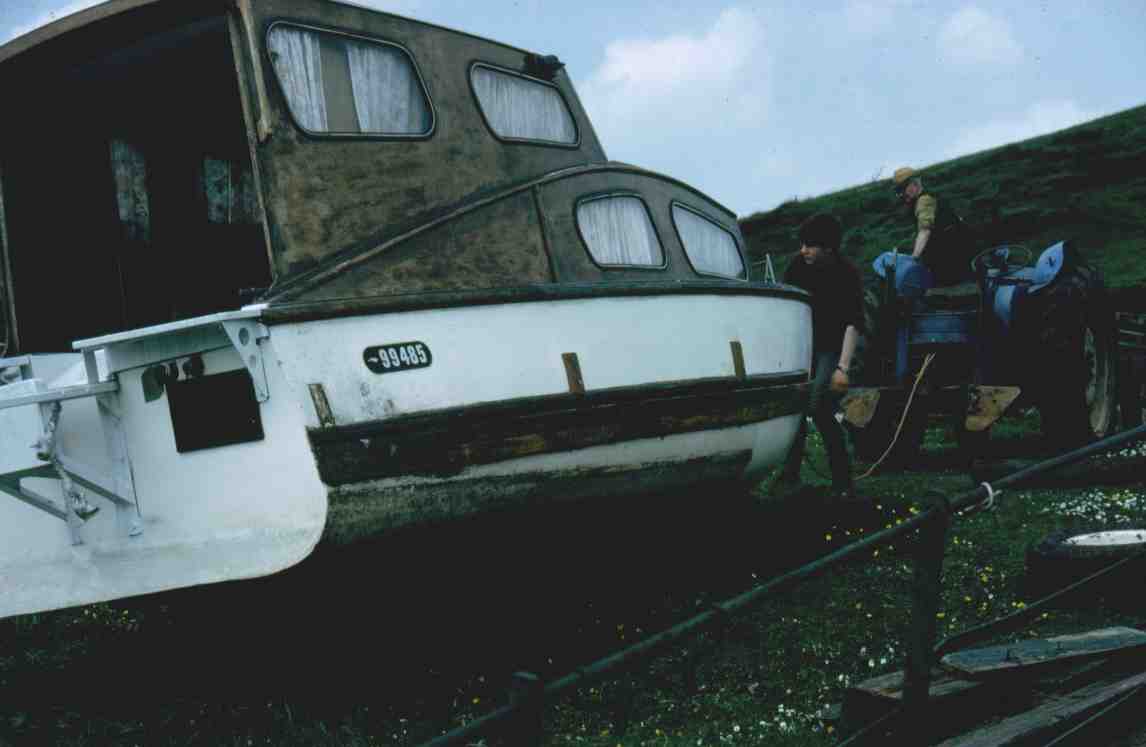
"Phial" out of the water at Beeston in 1982 to tighten-up a keel bolt
(Photograph - James M Wood)
It was around this time that I was exploring the possibility of buying an inexpensive boat myself. When going to the various boatyards to purchase bits for “Phial” I would always look to see if they had any reasonably priced boats for sale. At Venetian Marine of Cholmondeston they had a brand new beige “Dawncraft” 22 complete with Honda 100 outboard motor on display outside the saleroom on the car park. I remember looking over it and admiring the exterior finish and the way that the interior was tastefully trimmed (orange dominated – fashionable at the time and it matched the beige of the exterior). It would have been nice to have been able to afford a new one but my budget would not have stretched to that. So it was back to looking around the boatyards. We didn’t go out of our way boat-hunting but an opportunity was about to unexpectedly present itself.
In 1983 I bought my own boat, a Mystral 20. We christened her “Misty Waters” and moored her at Beeston below the Iron Lock (the story of “Misty Waters” is documented by the chapter of that name in “Canalscape 2”). In 1985 she was replaced by a Dawncraft Dandy bearing the same name. Shortly afterwards, we moved our moorings to Preston Brook Marina on the Bridgewater Canal and only saw “Phial” when visiting Mother during the summer.
By 1988, Mother felt that she was getting too old for boating and put “Phial” up for sale. I was offered her but was too wrapped up in my own boat, plus, I had suspicions that the rear cabin might be too tall for Preston Brook, Saltersford and Barnton Tunnels and so, preventing access to the Bridgewater Canal. I look back at my lack of interest with sadness. I have since discovered that “Phial” would have passed through the tunnels (just) and if I had bought “Phial” then, she would have been spared the attentions of an owner inexperienced in the ways of boat maintenance and the indignities that were to follow. “Phial’s” new owner was a Mister Ellis, who also lived in Wallasey and was an acquaintance of my brother’s. In 1990, after a short illness, Mother died. She never saw “Phial” again after selling her. “Phial” could be likened to Mother and Father… gone but most certainly not forgotten.
|
|
|
|
A list of major milestones in my canal |
|
|
cruising experiences from 1959 to 1982
|
|
|
August 1959 |
“First Contact”, viewed canal boats at Christleton on Shropshire Union Canal |
| August 1960 | First canal holiday Shropshire Union, Staffordshire & Worcestershire and Llangollen Canals (Kathleen) |
| August 1961 | Llangollen and Shropshire Union Canals (Kathleen) |
| August 1962 | Llangollen and Shropshire Union Canals (Kathleen) |
| August 1963 | Shropshire Union and Llangollen Canals (Ursula) |
| August 1964 | Llangollen and Shropshire Union Canals (Maureen) |
| August 1965 | Llangollen and Shropshire Union Canals (Maureen) |
|
April 1966 |
Phial Launched and cruised to Beeston moorings |
| May 1966 | Phial returned to Marlin Craft at Chester for remedial work to varnish |
| August 1966 | Our first IWA National Rally at Whalley Bridge on the Peak Forest Canal (by car) |
|
August 1966 |
Shropshire Union, Trent & Mersey and Llangollen Canals (Phial) |
|
August 1967 |
Shropshire Union and Staffordshire & Worcestershire Canals to Stourport (Phial) |
|
August 1968 |
Shropshire Union and Staffordshire & Worcestershire Canals and River Severn to Worcester (Phial) |
|
August 1969 |
Shropshire Union, Birmingham, Grand Union and Stratford Canals to Stratford & River Avon (Phial) |
|
August 1970 |
Shropshire Union and Staffordshire & Worcestershire Canals and River Severn to Gloucester (Phial) |
|
March 1975 |
Shropshire Union Canal, Waverton to Cholmondeston (Sunseeker) |
|
July 1981 |
Shropshire Union and Llangollen Canals to Ellesmere (Phial) |
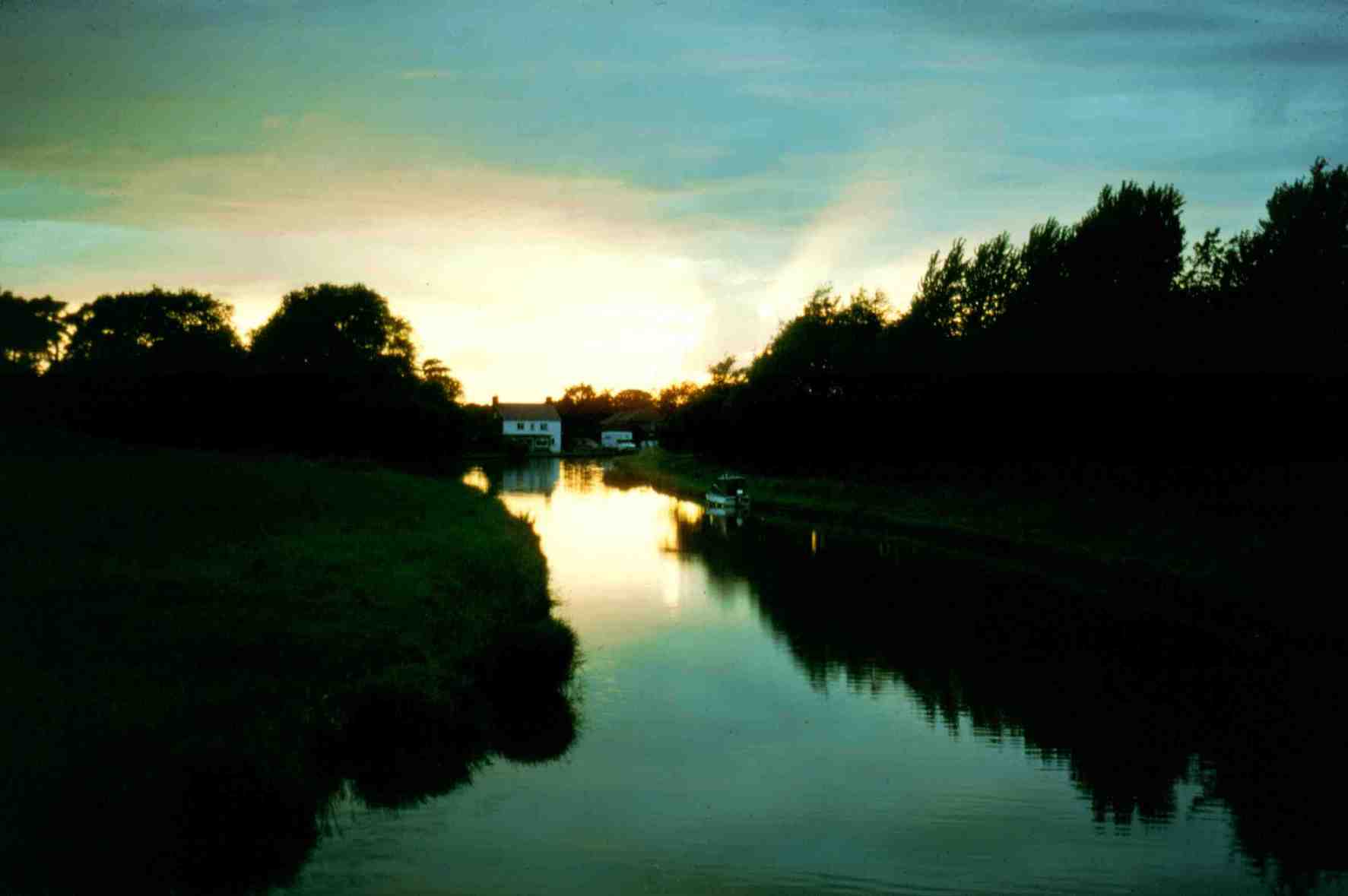
"Phial" (in the middle distance) moored at sunset taken from Bridge 99 at Barbridge on the "Shroppie"

Book 2
Canal Cruising 1983 to 1999
|
|
|
|
| "Canalscape" and "Diarama" names and logo are copyright |
or select another book below...
|
Click here for the latest entries or on the required section in the Contents below to follow links |
|
| Forward | |
| So You Want To Go Canal Cruising? | |
|
|
Introduction |
|
|
Book 7 - 2011 |
|
|
Book 10 - 2014 |
|
|
Book 12 - 2016 |
|
|
Book 13 - 2017 |
|
|
Book 14 - 2018 |
| Book 15 - 2019 (Coming Soon) | |
| Our Boats | |
| Ruby | |
| nb Squirrel | |
| Canals on Screen | |
| Canalscape Photography | |
|
Shroppie - The Shropshire Union Canal System (In Preparation) |
|
| The Manchester and Salford Junction Canal | |
| Mersey Connections (Coming Soon) | |
| Canis Canalus | |
| Shannon | |
| Site Map | |
| Go to the | |
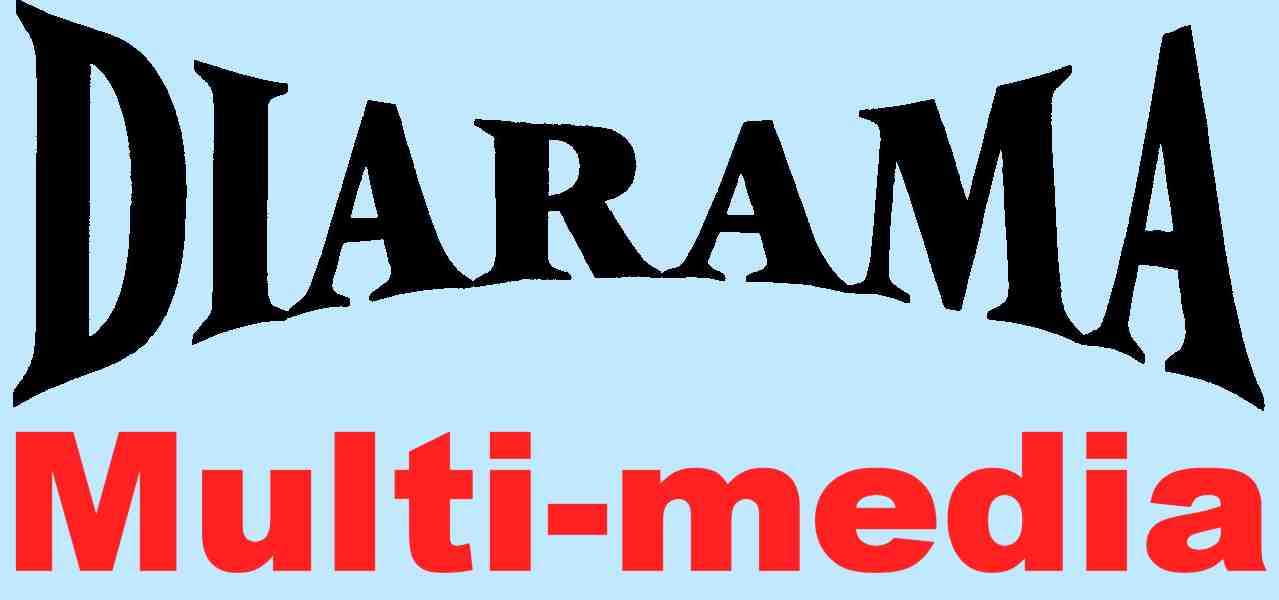 |
|
| Website | |
| e-mail link - cyril.wood@virgin.net | |
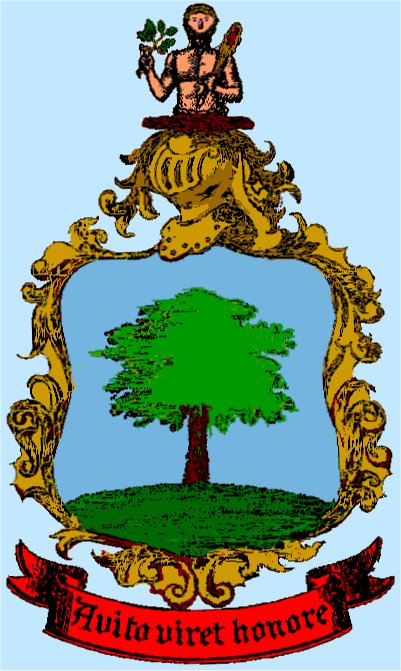 |
|
|
"Canalscape" and "Diarama" names and logo are copyright |
|
Updated 05-08-2018

